HSP HISTORY Blog |
Interesting Frederick, Maryland tidbits and musings .
|
|
This past weekend was dedicated to US Presidents, past and present. The annual POTUS lovefest is sandwiched between the birthdays of two of the greatest of the profession—Abraham Lincoln on February 12th and George Washington on February 22nd. It’s not only the perfect time to buy a new mattress, but more so, to reflect upon these unique individuals and so many others who have held the position in the past. We have viable accounts of visits by both these legendary leaders to Frederick. Lincoln, who served from 1860-1865, came in early October 1862, weeks after the battles of Antietam and nearby South Mountain. He gave impromptu speeches at Court House Square and the Baltimore & Ohio Railroad station at the intersection of South Market and All Saints streets. George Washington made multiple trips through early Frederick Town, starting with a supposed meet-up with Gen. Edward Braddock of the British forces (during the French & Indian War) in April, 1755. On a later visit, while serving in the role as our very first United States president from 1789-1797, Washington would receive a special address upon his arrival at Frederick on June 30th, 1791. “At the request and in behalf of the inhabitants of Frederick” signed by George Murdock, William M. Beall, Richard Potts, Dr. Philip Thomas, and John McPherson, and reads: “The inhabitants of Frederick take the liberty to congratulate you upon your safe Arrival at this place. And to Assure you that it gives them sincere pleasure to have this opportunity of expressing that veneration and attachment which they have always felt and still feel for your person & character, As A Patriot, a soldier, A Statesman And a fellow citizen. They have Sir a lively sense of gratitude for that long Series of Services which you have so ably exhibited on the public Stage on behalf of your Country, and from which they, in common with the rest of their fellow citizens, have experienced Such Solid Advantages. They consider you, under heaven, as the chief Author of their political Salvation; And At the time that they profess their firm attachment to your person as their chief Magistrate, And to that excellent Constitution over which you preside, they are happy in the blessings derived from your Administration; And as republicans have a pride in Admiring that equality that hath been established, and which they hope will ever prevail throughout United America. They gratefully Acknowledge the blessings of Providence conferred by your safe return in good health from your long Southern tour at an unhealthy season of the Year, and pray heaven that it may very long be preserved here, & that you may be finally happy hereafter.” The following day, President Washington would write the following letter of thanks to residents who had just hosted him here: “Gentlemen, I express with great pleasure my obligations to your goodness, and my gratitude for the respectful and affectionate regard which you are pleased to manifest towards me. Your description of my public services over-rates their value, and it is justice to my fellow-citizens that I should assign the eminent advantages of our political condition to another cause—their valor, wisdom, and virtue—from the first they derive their freedom, the second has improved their independence into national prosperity, and the last, I trust, will long protect their social rights, and ensure their individual happiness. That your participation of these advantages may realise your best wishes is my sincere prayer. G. Washington” Upon the deaths of both men, Frederick would host special events including a luminary procession through the streets following Lincoln’s assassination in April, 1862, and a memorial funeral service for Washington in February of 1800. Our town, and county of the same name, has many connections to individuals who held the special title and position of President of the United States. In earlier days, Frederick was simply a town located on the crossroads of major transportation routes. Our history books claim that Thomas Jefferson and Andrew Jackson traveled through town by stage and visited the Old Tavern that once stood at the intersection of West Patrick and Jefferson streets. Many other early presidents and important statesmen would do the same. It also doesn’t hurt having the presidential retreat on Catoctin Mountain up near Thurmont. This location, built in 1942, has hosted presidents starting with Franklin D. Roosevelt, our 32nd president, up through memorable visitors such as Lyndon Johnson, Jimmy Carter, and Ronald Reagan. Most recently, Joe Biden spent Christmas 2023 at the mountain getaway. As many know, I’m the historian and preservation manager for Frederick’s historic Mount Olivet Cemetery. I often get the chance to make both Frederick and Mount Olivet connections to former U.S. presidents through my weekly “Stories in Stone” blog, which can be found on MountOlivetHistory.com and Mount Olivet’s FaceBook page. We have decedents here that personally interacted with the presidential greats including the fore-mentioned George Washington and Abraham Lincoln. In addition, Mount Olivet may be the final resting place of the mysterious mixed-race daughter of Thomas Jefferson named Harriet Heckman. Its definitely known that we have a confidante of President Andrew Jackson in Francis Scott Key. Maryland’s only “Roughrider,” Jesse C. Claggett, charged San Juan Hill under future president Teddy Roosevelt, while John Groff served as a White House security guard under President Warren G. Harding. Sadly, Groff would die on the job in 1921. Dr. Basil Norris, the personal presidential physician to presidents Andrew Johnson and Ulysses S. Grant, owned cemetery plots here, but would be buried in San Francisco instead. Surprisingly, James Monroe’s grandson, Samuel L. Gouverneur, is buried a short distance away, also in Mount Olivet’s Area G. I thought we may have Carroll Harrison Kehne (1910-1994) buried in Mount Olivet, the man who served a Coke to President Harry Truman in 1953, but he is buried in my old stomping grounds of Yellow Springs/Indian Springs at Pleasant Hill Cemetery, near the new development of Kellerton. As far as presidents on the grounds, we have had only one that I know of, but should have had two. President William McKinley was invited to attend the unveiling of the Francis Scott Key Monument in August of 1898, but had to respectfully decline because he was in the middle of the Spanish –American War. Our largest president, William Taft would make it to the Key Monument in order to lay a wreath in November, 1911. Speaking of Key, President George H. W. Bush landed within yards of the cemetery back in 1991 aboard Marine One in order to attend a Frederick Keys baseball game. I was at that game operating the centerfield camera with a secret service agent right beside me. In addition to his grandson, the president’s central companion that night was M. J. Grove, son of the stadium’s namesake James Henry "Harry" Grove. Both Groves are buried in Mount Olivet as well.  In recent memory, locals can remember visits to town by President Dwight Eisenhower, whose wife (Mamie) loved to shop here. Ike's successor, John F. Kennedy, had a campaign stop in downtown Frederick in 1960, and later skied at Braddock Heights with his family. Kennedy’s presidential opponent, and a later U. S. president himself, Richard F. Nixon, “partied” at Braddock Heights as a senator when the mountain retreat was still in its heyday. He also visited Fort Detrick in October, 1971 to announce a new mission of researching cancer before signing the National Cancer Act. I also know that the Clintons stopped in the old Frederick Visitor Center on East Church Street and shopped at our antique stores including Great Stuff By Paul on Chapel Alley. Back in February of 2018, I wrote a “Story in Stone” on a past clerk of our Frederick County Court named Eli G. Haugh. Mr. Haugh, of no relation to me, had issued a fishing license to our 31st president, Herbert Hoover. Hoover enjoyed recreating in the Thurmont vicinity at Little Hunting Creek, near the old Catoctin Furnace below Thurmont, before President Roosevelt put his plan for Shangri-La (later to be named Camp David by President Eisenhower). As a matter of fact, Hoover’s personal secretary, Lawrence Richey, went as far as purchasing two properties for his boss’ recreational use. These included the old Furnace master’s home at Catoctin Furnace, and later Trout Run further south. Catoctin Furnace was built by Governor Thomas Johnson and brother James Johnson, the original furnace-master who lived in this home before building Springfield Manor down the road. Seven years back, I wrote about a brother of this tandem named Joshua Johnson (1742-1802), as he is buried with these siblings in a family plot in Mount Olivet's Area MM. Joshua was father-in-law to John Quincy Adams, son of our second president, John Adams, whom Governor Thomas Johnson served with on the Continental Congress. Joshua’s daughter, Louisa Catherine Johnson, would marry John Quincy Adams (1767-1848) in 1797.  President John Adams (1735-1926) President John Adams (1735-1926) Quincy would fulfill duties as the first US minister to Russia, followed by an appointment as envoy to Great Britain where he met Louisa. The couple came back to the United States after Quincy was appointed to the position of Secretary of State in 1817 under President James Monroe. He held this position until 1825, when he was elected as the 6th President of the United States. In doing so, Joshua Johnson’s daughter became the first-lady of the nation. Let’s jump back to our second president, John Adams, who made a brief visit, himself, to Frederick in late May, 1800. He was traveling from Philadelphia by carriage to the newly constructed executive mansion (White House) in the new capital of Washington, DC. The website “ghostsofdc.org” recounts the visit as follows: “The traveling party reached the town of Frederick, Maryland in the evening of Saturday, May 31st. He was greeted near the Monocacy River, about three miles outside of the town by Doctor Tyler, ironically a Presidential elector who supported Jefferson and not Adams. The following day, being a Sunday, saw the President and (nephew and personal secretary William) Shaw attend religious services at the Lutheran Church, conducted by Rev. Samuel Knox. The sermon focused on text from the book of Matthew: “Blessed are the peacemakers, for they shall be called the children of God.” They set out from Frederick with the destination of Georgetown, their first stop across the District line. Both Dr. William B. Tyler (1784-1872) and Rev. Knox (1756-1832) are residents of Mount Olivet, and the route used by John Adams (South Market Street turning into the Old Georgetown Pike) would have taken him directly past what would be our cemetery’s front gate 54 years later. Two years back, I wrote a story about people buried in Mount Olivet who are named after presidents. Trust me, there are many “George Washingtons” here, but you will also find the likes of Franklin Pierce Benner, Millard Fillmore Lease and Woodrow Wilson Miller One such person in Area C/Lot 62 was named for a president who has an extra special spot in Frederick’s history. Or should I say, we have a distinct spot in this gentleman’s personal and professional history. It’s not definitive, but it’s an interesting story nonetheless. Our cemetery resident is named for another president with a February birthday—William Henry Harrison. Our Mount Olivet “Tippecanoe” was born November 13th, 1848. He was the son of Josiah Harrison and wife Ann Rebecca Ludwig. He married twice and worked at the Birely Tannery for many years. The location of this operation was on the northside of Carroll Creek at a site across from the Delaplaine Arts Center. Mr. Harrison died on May 3rd, 1924. His obituary helps paint a better picture of this man. Nearly eight years before our Mr. Harrison’s birth, Frederick played host to the 9th US President of the same name. He would be here for roughly 18 hours, but they could have been hours that definitely changed his life. On February 5th, 1841, the President-elect (William Henry Harrison) arrived in Frederick. Nicknamed “Old Tippecanoe,” Harrison was on his way to office in Washington, from his native Indiana, after soundly defeating the incumbent candidate President Martin Van Buren. Before I get to the scant details of his visit, I want to share some background on a very complex man in the history of our country who is known better for his role as a soldier instead of politician. Here is some of the narrative found on his Wikipedia site: William Henry Harrison was an American military officer and politician who served as the ninth president of the United States. Harrison died just 31 days after his inauguration as president in 1841, making his presidency the shortest in U.S. history. He was also the first U.S. president to die in office, causing a brief constitutional crisis since presidential succession was not then fully defined in the United States Constitution. Harrison was the last president born as a British subject in the Thirteen Colonies and was the paternal grandfather of Benjamin Harrison, the 23rd president of the United States. Harrison was born into the Harrison family of Virginia at their homestead, Berkeley Plantation. He was a son of Benjamin Harrison V, a Founding Father of the United States. During his early military career, Harrison participated in the 1794 Battle of Fallen Timbers, an American military victory that ended the Northwest Indian War. Later, he led a military force against Tecumseh's confederacy at the Battle of Tippecanoe in 1811, where he earned the nickname "Old Tippecanoe.” He was promoted to major general in the Army during the War of 1812, and led American infantry and cavalry to victory at the Battle of the Thames in Upper Canada. Harrison's political career began in 1798, with an appointment as secretary of the Northwest Territory. In 1799, he was elected as the territory's non-voting delegate in the United States House of Representatives. He became governor of the newly established Indiana Territory in 1801 and negotiated multiple treaties with American Indian tribes, with the nation acquiring millions of acres. After the War of 1812, he moved to Ohio where, in 1816, he was elected to represent the state's 1st district in the House of Representatives. In 1824, he was elected to the United States Senate, though his Senate term was cut short by his appointment as Minister Plenipotentiary to Gran Colombia in 1828. Harrison returned to private life in North Bend, Ohio, until he was nominated as one of several Whig Party nominees for president in the 1836 United States presidential election; he was defeated by Democratic vice president Martin Van Buren. Four years later, the party nominated him again, with John Tyler as his running mate, under the campaign slogan "Tippecanoe and Tyler Too.” Harrison defeated Van Buren in the 1840 presidential election. The president-elect was 68, and certainly not in perfect health. His trip to Frederick was a long one during which he traveled in boat, stagecoach and steam cars. At every town, village and crossroads along the National Pike, residents gathered to greet him. Harrison had come to Frederick directly from Hagerstown via the National Road, which is represented by today’s US 40A. He had come through Boonsboro and traveled eastward over South Mountain to Middletown. From here, Harrison’s entourage scaled Braddock Heights and Catoctin Mountain and traversed the Golden Mile long before it was, well, “Golden.” Frederick diarist Jacob Engelbrecht wrote of the momentous occasion in his legendary diary: “General William Henry Harrison, President-elect of the United States, arrived in this town this evening about half past six o’clock. He stopped at Dorsey’s City Hotel.” Friday, February 5, 1841 Other accounts have said that by the time Harrison arrived in Frederick, he was very tired. He supposedly mustered enough strength to attend a Frederick reception at the City Hotel on West Patrick Street, located where the old Francis Scott Key Hotel is today near the corner of Court Street. This, of course, was the former Talbott’s Tavern, purchased by Baltimore business entrepreneur Daniel Dorsey in 1838. After improving the hotel, which had hosted the Marquis de Lafayette less than 20 years earlier, Col. Dorsey (1811-1885) ran the operation for six years before going back to Baltimore and taking over a popular hotel called the Exchange. He would manage hotels in New York and eventually the renown Barnum's City Hotel in Baltimore as he had married into the family. Col. Dorsey is buried in Baltimore's Greenmount Cemetery. Let’s get back to William Henry Harrison. After supper, the president-elect is said to have addressed the citizens outside in the cold rain. An exhausted Harrison thanked the people of Frederick for their hospitality and expressed his appreciation to the people of Maryland for their votes in the election. Having spent the night at this location in Mr. Dorsey's City Hotel, Gen. Harrison again met with the Frederick faithful. This eventually won over some of his opponents as Engelbrecht made a second notation in his journal: “This morning at 9 o’clock General Harrison addressed the people on a rostrum before the City Hotel (being first welcomed to our city by L. P. W. Balch, Esquire). The whole pavement and street was crowded. He departs in the cars at 10 1/4 for Baltimore. Saturday, February 6, 1841 I became intrigued with the name of the master of ceremonies, one L. P. W. Balch. I soon learned that the L. P. W. stood for Lewis Penn Witherspoon Balch. Mr. Balch was a leading lawyer in town and resident of Court House Square at the time of Harrison's visit in 1841. L. P. W. Balch was born December 31st, 1787 in Leetown, Jefferson County, Virginia (now West Virginia). His father, Rev. Stephen Bloomer Balch was a noted clergyman who helped establish Frederick's Presbyterian Church. Here is a little blurb on that gentleman. In 1840, L. P. W. Balch worked as a lawyer and can be found living in Court House Square with Frederick heavy-hitters including Dr. William Tyler, Richard Marshall, Nicholas Potts, and Fairfax Schley. His name can be found in early newspapers advertising his services and acting as trustee in real estate and other property sales and auctions. Balch's wife Elizabeth Willis Wever (1790-1874), was the sister of Caspar Willis Wever (1786-1861), an engineer builder involved in the Baltimore & Ohio Railroad, and the creator of Weverton, Washington County, Maryland, an early industrial village that failed. Balch would leave Frederick to take over his family estate in Jefferson County, Virginia (later West Virginia). Before his death, he would serve as Judge of the Jefferson County Circuit Court. Engelbrecht’s reference above to Harrison departing in“the cars,” meant the rail cars and railroad. The Baltimore & Ohio was still relatively new, having first connected Frederick to Baltimore a decade earlier in 1831. The freight depot was on Carroll Street and the old passenger station, which still stands, was located on the southeast corner of S. Market Street at the intersection with East All Saints Street. (A later incarnation of the station is today the home of Frederick’s Community Action Agency at 100 S. Market). Harrison was escorted to the depot and took a train to Baltimore where he would next enjoy hospitality at Barnum’s City Hotel said to have been "one of the finest hotels in the mid-Atlantic.” Harrison reached Washington from Baltimore, but would never make it back to Frederick, among many other places. Three weeks later, he would be inaugurated on March 4th. “When Harrison came to Washington, he wanted to show that he was still the steadfast hero of Tippecanoe and that he was a better educated and more thoughtful man than the backwoods caricature portrayed in the campaign. He took the oath of office on Thursday, March 4, 1841, a cold and wet day. He braved the chilly weather and chose not to wear an overcoat or a hat, rode on horseback to the grand ceremony, and then delivered the longest inaugural address in American history at 8,445 words. It took him nearly two hours to read, although his friend and fellow Whig Daniel Webster had edited it for length. Harrison’s inaugural address was a detailed statement of the Whig agenda, a repudiation of the policies of his predecessors Andrew Jackson and Martin Van Buren. It was also the first and only formal articulation of his approach to the presidency. Likely reminiscent of his speech in Frederick in early February, Harrison’s address began with his sincere regard for the trust placed in him: “However strong may be my present purpose to realize the expectations of a magnanimous and confiding people, I too well understand the dangerous temptations to which I shall be exposed from the magnitude of the power which it has been the pleasure of the people to commit to my hands not to place my chief confidence upon the aid of that Almighty Power which has hitherto protected me and enabled me to bring to favorable issues other important but still greatly inferior trusts heretofore confided to me by my country.” President William Henry Harrison promised to re-establish the Bank of the United States and extend its capacity for credit by issuing paper currency in Henry Clay's American system. He intended to rely on the judgment of Congress in legislative matters, using his veto power only if an act were unconstitutional, and to reverse Jackson's spoils system of executive patronage. He promised to use patronage to create a qualified staff, not to enhance his own standing in government, and under no circumstance would he run for a second term. He condemned the financial excesses of the prior administration and pledged not to interfere with congressional financial policy. All in all, Harrison committed to a weak presidency, deferring to "the First Branch", the Congress, in keeping with Whig principles. He addressed the nation's already hotly debated issue of slavery. As a slaveholder himself, he agreed with the right of states to control the matter: “The lines, too, separating powers to be exercised by the citizens of one state from those of another seem to be so distinctly drawn as to leave no room for misunderstanding…The attempt of those of one state to control the domestic institutions of another can only result in feelings of distrust and jealousy, the certain harbingers of disunion, violence, and civil war, and the ultimate destruction of our free institutions.” This was very telling of the future as we would have states rebelling and dropping from the Union with the American Civil War twenty years later as Abraham Lincoln was inaugurated for his first time as president. Following his speech, William Henry Harrison rode through the streets in the inaugural parade. He would stand in a three-hour receiving line at the White House. He would wrap up what was likely the busiest and most stressful day of his life by attending three inaugural balls that evening, including one at Carusi's Saloon entitled the "Tippecanoe" ball with 1,000 guests who had paid $10 per person (equal to $325 these days). In the days following his March 4th (1841) inauguration, Harrison fell ill. This was just one month after his visit to Frederick. Some say that this sickness was the exacerbation of a cold caught while giving his speech in Frederick. Others say it was the result of the entire grueling journey from Tennessee. Yet others think it was a consequence of his conduct on Inauguration Day itself. More recent study has even said that it could have been enteric fever and have connections to Washington's questionable drinking water supply of the period. Harrison’s death continues to be speculated about. He would only serve 31 days, a period fraught with several stressful “job-related” situations and another rainstorm situation which caught him by surprise while on a morning walk on March 24th, 1841. The president became ill with cold-type symptoms and would be bed-bound with a “severe chill.” Within days, his doctor diagnosed him with pneumonia. In the early morning hours of April 4th, Harrison would die exactly one month after his inauguration, and 53 days after visiting Frederick. He was the first US president to die in office. Jacob Engelbrecht wrote on April 6th (1841) a brief passage of Harrison's death and instructions given to his successor, John Tyler, but nothing about the potential cold caught in Frederick: The last words uttered by General Harrison about 3 hours before his death in the presence of Doctor N. W. Worthington were, “Sir, I wish you to understand the true principals of the government. I wish them carried out. I ask nothing more.” General Harrison’s funeral will take place tomorrow at 12 o’clock AM. A 30-day period of mourning commenced and William Henry Harrison was buried in a family cemetery in North Bend, Ohio. I found it interesting that Jacob Engelbrecht would make the following entry in his diary nearly 33 years later on January 23rd, 1874 regarding presidents: I read this day in Gruber’s Almanack that we have had eighteen Presidents of the United States since we exist as a government viz. George Washington, John Adams, Thomas Jefferson, James Madison, James Monroe, John Quincy Adams, Andrew Jackson, Martin Van Buren, William Henry Harrison, John Tyler, James K. Polk, Zachary Taylor, Millard Fillmore, Franklin Pierce, James Buchanon, Abrahan Lincoln , Andrew Johnson, Ulysses S. Grant. I was born during the Presidency of John Adams so that there were seventeen Presidents during my lifetime in these United States. I saw of these 17 the following, James Monroe, John Quincy Adams, Andrew Jackson, Martin Van Buren, William Henry Harrison, James Buchanon, Abraham Lincoln, Andrew Johnson, & Ulysses S. Grant. I reckon we’ll not see many more, past 76 years. Ironically, Jacob Engelbrecht died on President Washington’s birthday, February 22nd, 1878. He did vote in one more election, his 16th, and “his man won” in the form of Rutherford B. Hayes of Ohio. Back in those days, the count actually took months to compile as Jacob journaled that he had voted on November 7th, 1876 and the final vote tally would not be made until March 2nd, 1877. With electoral votes, Mr. Hayes was victorious with 185 votes compared to his Democratic challenger Samuel J. Tilden who received 184.  Now, I’m not sure if Engelbrecht had an earlier opportunity to meet, or at least see, Rutherford B. Hayes when he was a Union commander during the Civil War. Lt. Col. Hayes came through Frederick in early September, 1862 and could have passed the diarist’s front door on West Patrick Street along Carroll Creek. This future president commanded the 23rd Ohio Regiment during the 1862 Antietam campaign and was severely wounded at Fox’s Gap during the September 14th Battle of South Mountain. He would recuperate for three weeks afterward at the home of local Middletown merchant Jacob Rudy. Just five months before his own death, Jacob Engelbrecht would make it “18 for 18” as he would see, and hear, President Hayes in person as an invited guest to the Great Frederick Fair. The diarist (and former Frederick mayor) estimated the crowd at 10 or 12,000—the largest ever to attend and on account of the President’s visit and address. The local Frederick newspaper would comment: ”Now he (the president) comes to see the triumph which agriculture has achieved under the broad banner of a united country.” President Hayes speech (October 11th, 1877): Ladies and fellow citizens, I thank you for the very cordial reception you have extended to me, and particularly I return my thanks to the people of Frederick city and county for their kindness in inviting me here. Of all the interests to be promoted by institutions like this the agricultural interests of the country are the most important. If the farmer is prosperous and the planter is prosperous, the country will surely be. Every interest finds an advantage in the promotion of agriculture, and if today we rejoice in reviving and returning prosperity to our nation it is because good crops and good prices make good times. We come, therefore to take part in this demonstration because it represents the agricultural interests of the country. Your county is well known throughout the Union. The skill and excellence of its cultivation are conceded, and in the locality from which I come we have the advantage of numbering amongst our citizens many who originally came from Frederick county. (applause) In Seneca and Sandusky counties, Ohio, there are many families who look back with pride to their early life in Maryland. They were familiar with this county in their boyhood, and in my acquaintance with them I do not feel a stranger to you. And their pride and boasting of their old home are great. The richest lands on the Sandusky are not, in their belief, as fertile as those of Maryland, and there are no fruit or crops like those of the county of Frederick, MD. And beside this I will remember the days I once spent here and the many kindnesses which I received, and on this account I feel at home amongst you. It’s so interesting to ponder the fact that these great individuals, the most powerful in American history, visited our fair town and county. Perhaps it was short and sweet, or somewhat insignificant in the grand scheme of events, but I think we will always see something romantic, magical and unique about past presidents being on our streets, sleeping in our buildings, shopping and dining in our stores and restaurants, and enjoying the tranquil atmosphere of Frederick and Frederick County, Maryland. Happy President’s Day, week and month! History Shark Productions Presents: Chris Haugh's "Frederick History 101" Are you interested in learning more about Frederick's incredible history?
Check out this author's latest online course offering: Chris Haugh's "Frederick History 101," with the next session scheduled as a 4-part/week course on Saturday mornings in March, 2024 (March 2, 9, 16, 23). These will take place from 9-11:30pm via the Zoom platform, all you need is a computer and you will be sent a link to view/hear the class. Cost is $79 (includes 4 classes). For more info and course registration, click the button below! (More sessions to come)
0 Comments
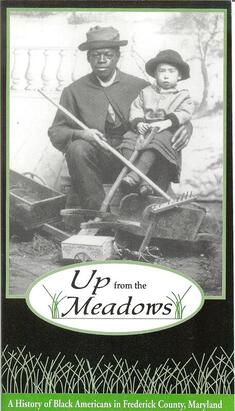 I am enjoying a period of great reminiscing of late. It was 30 years ago (February 1994) that I was inspired to produce a video-documentary project focusing on the Black history of Frederick County, Maryland. I wouldn't start production until two years later, and two years past that (March 1998), I surprisingly found myself on a stage in San Diego, California accepting an award called the Beacon Award of Excellence, the highest honor for communications and public affairs in the Cable Television industry. It was quite a thrill, but more so, a humbling experience as this award belongs to my many "teachers" for this endeavor, along with a host of people I only knew as gravestones, sprinkled throughout the county —their spirits were certainly guiding me. The five-hour documentary was given the title Up From the Meadows, a play on the opening line from John Greenleaf Whittier’s famed poem about hometown Civil War heroine Barbara Fritchie. Throughout the production process, I was able to live in the moment, as I knew that creating this long-form television program would not only educate and humble me (a white male born at the tail-end the Civil Rights Movement period) but would certainly shape my thinking about past events, places and persons. I went into the project with the basic Black history knowledge I had carried since my childhood and early school days. There were the obvious stories of Martin Luther King, Rosa Parks, George Washington Carver and Jackie Robinson. I also could make connections to my home state through legendary native Marylanders: Frederick Douglass, Harriet Tubman, Benjamin Banneker and Thurgood Marshall. When I was 10 years old, my parents encouraged me to watch the “Roots” television miniseries, which premiered in 1977. Like countless other Americans, black or white, I became inspired toward a lifetime search to know my own ancestors. However, the greater takeaway was getting my first glimpse of a dramatization of the African slave trade and the institution from Colonial America up through the American Civil War, and continued prejudice and segregation that would permeate society in the century to follow. It made quite an impression. From time to time, I thought about delving into a Black history of Frederick, and was inadvertently pushed over the threshold by the late Dr. Len Latkovski (1943-2015), beloved former professor of history and political science for Hood College. I had utilized Len as an on-screen commentator for an earlier Frederick City history documentary entitled Frederick Town which I began producing in 1993. The seasoned professor, originally from Latvia, amazed me with population statistics and anecdotes relating to Frederick County’s slave and free black populations. He also encouraged me to look at slavery through the lens of different religions and their views on slavery (particularly Catholicism, Methodism and the Society of Friends). Len made me realize that Frederick County’s past made for a unique case study of the African-American experience. Where else could you find such a great number of free and enslaved black people living in the same environs—a place bordered by the Mason-Dixon Line to our north, and the Potomac and Virginia, capital of the Confederacy to our south? And all this set in motion and dictated by the original white European cultural-settlement patterns of Frederick County. I would zero in on this “border county within a border state” notion as a central tenet for my proposed “Black history” documentary. My experiences with Up From the Meadows have been readily coming to mind over the past few month. I’ve been preparing lectures and readying materials for an upcoming, multi-week class on the subject that I am slated to teach (in March and April) under my History Shark Productions moniker. Students will view portions of the documentary, interspersed with an illustrative PowerPoint presentation. I plan on explaining the production process, and discussing pertinent points of subject matter. Simply put, the four-part course will be “chock-full” of historic events, places and people from Frederick County’s past that once hovered “below the proverbial radar.” And for a story this rich and important, I can’t say I will be teaching alone. I will have a host of on-screen instructors helping me out, just as they did back in March 1997 with the program’s premiere on local cable television.  Dr. Blanche Bourne Tyree (1917-2019) Dr. Blanche Bourne Tyree (1917-2019) One of these “teachers” was Blanche Bourne Tyree, who holds the distinction of being the first woman from Frederick County to have earned a medical degree. She had a successful career as a pediatrician and a public health administrator for over 40 years. In retirement, she built an impressive resume of civic involvement, including a three-year stint as co-host of Young at Heart: Frederick County Seniors Magazine, a program I proudly oversaw as executive producer while at GS Communications' Cable 10. Medicine would certainly define Blanche Bourne Tyree’s immediate family’s life. Her father was a man named Dr. Ulysses Grant Bourne, Frederick’s first Black physician. Dr. U.G. Bourne hailed from Calvert County, and came to segregated Frederick in 1903, after completing his education in North Carolina at Leonard Medical College. Despite being allowed to practice at Frederick Memorial Hospital, Dr. Bourne went on to open a 15-bed hospital for Blacks on West All Saints Street in 1919. This would be the first county hospital to accept patients of color. Dr. Bourne was a magnificent civic leader as well, whose many accomplishments include the founding the Maryland Negro Medical Society and co-founding Frederick’s NAACP chapter. His name now adorns the Frederick County Government building formerly known as the Montevue Assisted Living Facility (located on Montevue Lane). His other two children experienced success in the healthcare field as well. Dr. Ulysses Grant Bourne Jr. became the first Black doctor to have privileges at Frederick Memorial Hospital, while daughter Gladys (Bourne) Thornton became a nurse. As snow and freezing rain fell outside, I fondly recall visiting Blanche at a local nursing home back in February, 2016. The 98 year-old had been plagued by recent setbacks which precipitated this stay away from her Crestwood Village home. I thought about how surreal things must have felt for a veteran physician and caretaker, now firmly in the role of patient. As I sat in awe of my beautiful friend, discussion on that morning included our past documentary and the day of our interview taping, one in which we were forced to “shoo” her late husband Chris (Tyree) out of the room we were using because he was interjecting too many comments from the “peanut gallery.”  Lord D. Nickens Lord D. Nickens We also recalled one of the true highlights of my professional career, something that began as a simple invitation Blanche had given me. This was in the early spring of 1998, and featured a road trip to find Blanche’s father’s original homestead and farm in lower Calvert County. I did the driving and along the way, we picked up Blanche’s cousin who would help guide us to the rural vicinity of Island Creek (near Broomes Island). This is where Blanche’s grandfather, Lewis Bourne, and wife Emily raised their ten children in a small rural Black settlement in the decades immediately following the Civil War. The old, family house had been boarded up for several years, slowly decaying into the surrounding landscape. I did, however, feel the importance of place here— having produced two generations of Bournes that would certainly shape Frederick into the great place we know today. With that 2016 visit, I again had the opportunity to thank Blanche for her assistance and friendship over the years, but especially with this project. She was my lone, surviving, on-camera commentator from the program which originally boasted 12 Frederick residents. It was moments such as the trip to Calvert County that helped give me a better understanding of Black history and legacy in Maryland, and of my home county in particular. As a white male, I will never be able to fully understand, but with this priceless tutelage, I was able to position myself as a conduit, relaying experiences from residents like Blanche who truly “lived” the documentary. Dr. U.G. Bourne was the father of one of my interview subjects, and mentor to another. Lord Dunmore Nickens (1913-2013) was truly influenced by Blanche’s dad, propelling him to take the lead in Civil Rights activism for the better part of his 99 years. Mr. Nickens taught me a great deal as well, and shared a myriad of personal experiences, “fighting the good fight,” on tape with me. He passed away more than a decade ago, but not before being honored with having a street in Frederick named after him. In 2014, a mosaic memorial mural depicting Mr. Nickens was unveiled on the side of a downtown building located at the corner of North Market and Lord Nickens streets.  Plaque honoring William O. Lee (1928-2004) adjacent Frederick's "Unity Bridge" in Carroll Creek Park Plaque honoring William O. Lee (1928-2004) adjacent Frederick's "Unity Bridge" in Carroll Creek Park Another Up From the Meadows alum was memorialized with a decorative suspension bridge crossing Carroll Creek. This waterway was once considered the dividing line between Frederick's white and black residents. William O. Lee (1929-2004) is best remembered as a longtime educator, municipal politician and community activist. This “gentle man” in the highest regard, can be credited as being among the first people to chronicle and promote Frederick City’s black heritage, highlighted by his childhood home of the All Saints neighborhood as the central hub for black life for well over a century. Mr. Lee walked me all over town, working hard to make sure I had a firm understanding of Frederick’s foremost endeavors in education, business, charity and social life in the segregated black community, and how barriers were finally chipped away in an effort to unite two Frederick’s into one—figuratively “bridging the town creek.”  Kathleen Snowden (1933-2008) Kathleen Snowden (1933-2008) What Bill Lee taught me about the city, Kathleen Snowden of New Market taught me on the county level. The self-proclaimed “outspoken” New Market resident shared her knowledge, based on years of intensive black history research. Ms. Snowden accompanied me as travel companion on several field trips. We searched for the remaining traces of former “Black sections” of leading towns (ie: Middletown, Brunswick, Libertytown) and explored “post-emancipation hamlets,” places like Sunnyside, Bartonsville, Della, Hope Hill and Coatesville. In addition, we experienced Black churches together, looked for old "colored" schoolhouses and walked countless Black burial grounds, seeing names in stone of former slaves and descendants of once-enslaved peoples, not to mention those of soldiers and prominent early free Blacks who lead their neighbors in the long fight towards equality.  Marie Erickson (1932-2011) Marie Erickson (1932-2011) Other teachers for me included 100 year-old Ardella Young of Pleasant View, Maude Morrison, Luther Holland, Arnold Delauter, Bessie Brown, Edith Jackson, Henry Brown and a lone, yet powerful white voice—Marie Anne Erickson. Marie taught me to embrace the fact that I was incapable of appreciating or fully understanding what my other subjects and the Black population (past or present) had experienced over their lifetimes. I was white, and male to boot, the long dominant power combination in our country since its inception. I had not experienced struggle of any kind, however I continue to feel no shame for events of the past, especially going back several generations. Marie Erickson was born and raised in Illinois, the daughter of Swedish immigrants who came to the US in 1923. She would pass in 2012, but not after four decades of assisting local Frederick Blacks in researching their roots, and gaining family connections. Marie was not only a friend to so many people of color, but became accepted as an “honorary” family member in many instances. All the while, she remained 100% genuine, not simply showboating for self-gain. Marie cared about equality and often looked for “teachable moments,” objects and opportunities in which to share illustrative “Black” stories and experiences with white and black readers alike. These appeared through her countless articles and letters to the editor in Frederick newspapers and magazines. A year after her death, Marie's daughter asked me to write the forward for a book to include many of her articles. This was published in late 2012 and is entitled, Frederick County Chronicles: The Crossroads of Maryland. As I said earlier, using Frederick County and its past for context, serves an amazing canvas to tell this story and introduce individuals such as William Ware, Elijah Lett, Professor James Neale, Decatur Dorsey, John W. Bruner and places like Oldfields, Centerville and Halltown. Current residents such as Joy Hall Onley and members of Frederick County's AARCH group (African American Resources Culture and History) continue their amazing work of "piecing together" and preserving this rich legacy. I might add that legendary resident, and founding AARCH member, Rose Chaney helped gather another group of amazing Black history storytellers for The Tale of the Lion, a documentary produced in 2018. Meanwhile, I’m happy to report that Black History Month will be extended through March and April this year for those individuals who take my upcoming “Up From the Meadows: the Class” course. While I market the fact that its my class, I think you can see that its only semantics. I will have plenty of help from former friends and mentors— true legends who helped research, preserve and make Frederick County's history, a mix of all colors when you really think of it. To learn more about the upcoming course (Tuesday evenings starting on March 12th-April 2nd), including registration instructions, click the button below:
The Frederick Board of Real Estate was two decades old when World War II captivated the country and understandably slowed "business" for the real estate industry on a global level. On the flipside, there was plenty of demand for the talent of these professionals during the post-war boom. At this point in time (1950), the national association had made some changes. One such was registering collective trademarks REALTORS® and REALTOR® with the United States Patent and Trademark Office. In late 1955, the Frederick Real Estate Board is said to have “fallen into a slump.” Some REALTORS® jumped ship and affiliated themselves with the Real Estate Board of Baltimore. However, Calvin S. Lohr would re-energize and reactivate the organization under his direction. This was possibly due to an awareness that newly proposed zoning regulations being discussed would have quite an impact on the Real Estate profession. The Board began to hold regular meetings once more and discussed a standard schedule of commission rates and charges. Back to the Future In 1956, the Frederick Board of Real Estate was removed from the books again of the The National Association of Realtors.® This was partially by design as the local organization would be reinstated as the “Real Estate Board of Frederick County, Inc.” As the "Cold War" prevailed on the world stage, things were still hot in the local, Frederick real estate market. Another development came on the city’s west side in the form of Wyngate in 1960. This would be located between Catoctin Park, Brigadoon and Linden Hills and just inside the newly constructed US15 Frederick Bypass.  US 15 is the descendant of a pair of turnpikes that once connected Frederick with Emmitsburg to the north, and Buckeystown to the south. These turnpikes were reconstructed as state roads in the 1910s north of Frederick, and in the early 1920s from Frederick southward to Tuscarora (also known as Licksville). When US 15 was assigned in 1927, the Tuscarora–Point of Rocks highway had yet to be improved, and this section would not be paved until the early 1930s. The modern Point of Rocks Bridge was built in the late 1930s after its predecessor was destroyed in a flood.  The Frederick Freeway was constructed in the 1950s, and US 15 was relocated to be part of this roadway. The old route of the US Highway, through downtown Frederick via Market Street, became part of MD Route 355. US 15's present highway between Point of Rocks and Jefferson was constructed in the late 1960s, and the old road south of Frederick was replaced with MD 28 and MD 85. North of Frederick, the US Highway bypassed Thurmont and Emmitsburg in the late 1950s and mid-1960s, respectively. US 15 would later be upgraded to a divided highway north of Frederick in the early 1980s. The bypassing of downtown Frederick changed traffic and real estate drastically. Meanwhile, the town’s electric trolley system, which had opened Frederick’s northwest suburbs and Braddock Heights, was now all but a memory, making its final run on the Frederick-Thurmont line in 1954. The busy roadway on Frederick City’s west side ran through the original design for the Rosedale community, nixing plans for residents to live on the west side of Apple Avenue and causing a few “through streets” to be capped off. A tradeoff in this vicinity came in 1957 with the county’s first retail shopping plaza. This was known as the Frederick Shopping Center. Quality of life for nearby neighbors was impacted with the extreme joy, ease and convenience of suburban shopping to compliment suburban living. The Frederick Shopping Center continues to operate today on West 7th Street. US15 served its purpose of moving motorists through the area both faster and safer. It also removed a great deal of congestion from downtown streets, most notably Market and Patrick. Speaking of Patrick Street, on one side of town, one could see the growth of Wyngate to the immediate west of Carroll Creek and Baker Park. Meanwhile, Tulip Hill sprung up southeast of town, just off the Old National Pike and west of the Jug Bridge along MD 144 adjacent the site of today's Maryland National Guard Armory. Monocacy Village had come under construction a few years earlier and would take hold closer to downtown along the north stretch of East Street. To the south of town, once considered below the city limits, was the beginning of Carrollton. Rock Creek Estates would be further out west and between Shookstown Road and US 40. In October of 1960, the Frederick County Board of Real Estate hosted a historic meeting, in which the Maryland Association amended its bylaws to become a “Three-Way” group." By achieving this long-held goal, the Board now represented a solid front of REALTORS® all holding membership in the local Board, the State organization and the National Association of REALTORS.® The local Board incorporated on December 13th, 1961, as the “Frederick County Board of Realtors, Inc.” Frederick's growth was also coming in part due to escalating property tax rates in Montgomery County. At the same time, many families were choosing to live in Frederick County, outside the Frederick City limits, due to high property taxes here as well. Mr. Adlie Magee was president and the first address of the "new" Frederick County Board was Ridge Road, Braddock Heights, MD. Mr. Ruhland C. Boyer and George M. Chapline, Sr. were the other officers of the corporation. Things would be righted in time for a decade that would usher in the era of "the Sixties,” featuring a collection of inter-related cultural and political trends around the globe. This was a decade defined by a counterculture and revolution in social norms regarding clothing, music, drugs, dress, sexuality, formalities, and schooling. The decade was also labeled the “Swinging Sixties.” This moniker is well-deserved due to "the fall or relaxation of social taboos that occurred during this time, but also because of the emergence of a wide range of music from the Beatles-inspired British Invasion and folk music revival to the poetic lyrics of Bob Dylan. Norms of all kinds were broken down, especially in respect to civil rights and precepts of military duty.” An impactful local event came in 1965 when the State Farm Insurance Company would locate one of its 28 regional offices here to Frederick, bringing 240 employees. These individuals required assistance from Frederick’s cast of local REALTORS® in an effort to find new homes for their families. The prior year of 1964 represented a landmark national event with the the signing of the legendary Civil Rights Act. This was certainly the most important news happening in Frederick that year, without compare, officially ending centuries of segregation practices in a city once located within "a border county in a border state" during the American Civil War. Fair Housing A few years later, President Lyndon B. Johnson signed the Civil Rights Act of 1968, meant as a follow-up to the Civil Rights Act of 1964. Long in coming, this legislation expanded on previous acts prohibiting discrimination concerning the sale, rental, and financing of housing based on race, religion, national origin, sex, handicap and family status. Title VIII of the 1968 Act is also known as the Fair Housing Act. The Frederick County Board of REALTORS® once again jumped into action, assisting the municipal government and Frederick County’s Human Relations Committee in an effort to clean-up housing opportunities for the city’s African American population by creating more adequate and dignified housing solutions. This came as a welcome alternative to the dilapidated collection of slums that once existed in many areas of Frederick City. One location of focus was known as Shab Row, located on East Street. In 1958, major action was taken by the Housing Authority which had been in existence since 1938. Slum areas such as Five and a Half Street off East Street (near Laboring Sons Cemetery) and further west spots between Klinehart's Alley and North Bentz Street (between 5th and 7th) were longtime targets. Something drastic needed to be done to not only help unfortunate residents, but to promote a healthier Frederick City. This particular project off Bentz Street would come to be known as the John Hanson Apartments. It was again a prime time for the Frederick County Board of REALTORS® to act. They would make sure there was equity and equality in the realm of housing here in Frederick County. Today, REALTORS® recognize the significance of the Fair Housing Act and reconfirm their commitment to upholding fair housing law, as well as offering equal professional service to all in their respective search for real property. Agents in a real estate transaction are prohibited by law from discriminating based on race, color, religion, sex, handicap, familial status, or national origin. The Frederick County Board of REALTORS®, Inc. continued to stride forward through the waning years of a fascinating time period that saw major protests and other happenings at home. These included such things as the Vietnam War, the assassinations of Martin Luther King, Jr. and Bobby Kennedy, the Apollo 11 moon landing, and a music festival (Woodstock) in rural New York state that attracted over 350,000 participants. In 1968, the wheels for the construction of Lake Linganore were set in motion. Frederick County officials issued the necessary approvals and permits to build the county's first planned unit development in New Market. A greater "love story" could not be written. Here in Frederick on July 1st, 1969, the Board of REALTORS,® under the direction of Mr. William H. Hamilton, began to operate its own Multiple Listing Service. The duplicating and processing of the listings were handled through a business called The Letter Shop. In November of that same year (1969), President Richard Nixon would announce the halt of biological warfare research at Fort Detrick which targeted the elimination of 1,000 area jobs. However, two years later in 1971, he would return to Frederick to announce a plan to convert the military facility into a federally-operated cancer research center. In 1970, Frederick County had a population of nearly 85,000 people. The census taken that year would show seven out of every ten Frederick County families owned their own homes. To underscore the opportunities Frederick County offered for single-family home ownership for the future, it was found that around 58% of the population lived on 1% of Frederick County’s land.  Through the efforts of Frederick County’s Board of REALTORS®, both owners of properties and "would-be" purchasers were now guaranteed equal protection of their best interests in the transfer of real estate. And this same degree of service, of course, would also be granted in the instance of landlord and tenant dealings. The Frederick County Board of REALTORS® reached another milestone in 1972 as it recognized its 50th anniversary. In July of that year, the organization set up its very own office space and secured its own staff under the leadership of the fore-mentioned Howell C. Happ, Jr. The Board began processing its own listings, and the staff secretary helped handle the increased paperwork and filing. On the larger stage, the name of the National Association of Real Estate Boards was changed to the National Association of REALTORS® (NAR). The block "R" logo was adopted by the Association one year later in 1973. Around this time, a newspaper article reported that the organization had “developed into an effective, mature group of 47 Realtors, 18 associate brokers and 400 Realtor Associates. And the group’s growth potential has not yet been reached, officers feel.” Where once the original members had met in one another’s offices for monthly meetings, now gatherings had evolved into dinner meetings held at Watson’s Restaurant. Most of the organization’s actual business had become handled by an executive staff and the Board of Directors at regular monthly luncheon meetings. It is at this time that the county’s local Board began concentrating its efforts on humanitarian goals with increased emphasis placed upon serving the fellow man. This could be done through the REALTORS® national endeavor, the “Make America Better” program. Since 1923, the Francis Scott Key Hotel had been the center of hospitality for four decades when articles began appearing in the local newspapers of an up and coming competitor to be built on the outskirts of downtown to the west. Local businessman Dan Weinberg was a master in the field of entertainment and hospitality with multiple theater holdings, not to mention the town's bowling lanes (Terrace Lanes), borrowing its name from nearby College Terrace, a community that had come about at the time of Frederick's premiere hostelry for business travelers and visitors alike. With the Frederick Bypass, came the need to provide an opportunity for a state of the art, luxury hotel as their already existed a few smaller motel venues already along the National Pike and Route 15. He would be bringing the fabled "Holiday Inn" brand to Frederick to battle the "Star-Spangled"-inspired Goliath that helped launch the Frederick Board of Real Estate in the first place. Golden Commercial Real Estate In the late 1960s, major land would be annexed along West Patrick Street/Route 40 west of the downtown Frederick City, and beyond the new residential communities built over the previous decade. Although a few restaurants and a “Drive-In” movie theater (begun by Mr. Weinberg, himself), had been here. This would fast become a hub for commercial development the likes that the community had never seen. The stretch would earn the nickname of “The Golden Mile.”  Frederick News (July 25, 1968) Frederick News (July 25, 1968) Dan Weinberg's Holiday Inn would eventually receive competition from across the street in the form of the Red Horse Motor Inn, which opened in early 1969. Soon enough, there came an onslaught of fast-food restaurants, retail stores and an indoor mall. These were constructed along this stretch where once stood regal farms dating back to Frederick’s beginning. This, in part, would cause a cultural shift reflecting what was happening across the country. Ease of accessibility from highway travel, with emphasis on parking, made suburban-based retail pursuits more attractive to customers. On the flipside, downtown retail establishments that had flourished in earlier decades would be severely impacted. Suburban living was becoming the norm and a desired approach for young families headed by professionals. Frederick could now be defined as an up and coming “bedroom community” or "commuter town." These terms denote that the population of a particular location is primarily residential rather than commercial or industrial, boasting residents engaged in routine travel from home to work and back. Many professionals working “down the road” in such places as Montgomery County and Washington, DC suddenly chose Frederick to call home. Now more than ever before, the need for talented and knowledgeable REALTORS® here in Frederick was critical to help an influx of new residents choosing Frederick to be their new bedroom. On the eve of the 50th anniversary year of the founding of the Frederick Board of Real Estate (back in 1922), the following "Real Estate" page in the Frederick News of December 29th, 1971 shows some of the talented professionals that assisted so many individuals over a twenty year span from 1960-1980. This era saw a county population explosion of roughly 37%. Single family developments such as Clover Hill (having already been in play now for a few decades) and Mount Laurel Estates to the northwest of Fort Detrick, nearby townhouse communities of Amber Meadows and Fredericktowne Village brought additional residents to Frederick. Waverly Gardens, Rock Creek, Hillcrest Orchard, Stonegate and Willowcrest took their respective places along “the Golden Mile” as well. Frederick soon adopted the moniker, “Frederick, Maryland: Away from the Madding Crowd.” This was turned into a bumper sticker by the upstart Tourism Council of Frederick County which began as a committee in 1974, formed under the Frederick Chamber of Commerce. The Tourism Council would be officially organized in 1976. Historic preservation of old houses and former business buildings began taking form, and the Marcou O’ Leary study, under a movement called Operation Town Action, sought to catch downtown Frederick from experiencing certain death under the auspices of the continuing suburbanization trend. Things, however, seemed to be holding steady for downtown Frederick as productive strategies and plans were being sought. While the nation celebrated the Bicentennial of American Independence, Frederick political and retail leaders, along with a legion of local REALTORS®, were extremely proud and pleased to be named an “All-America City” by the National Municipal League. Frederick had won this distinction due to ongoing, proactive efforts undertaken by local groups to preserve the city’s historic sites and garner various government-sponsored revitalization projects. Things, unfortunately, would “go under water,” both literally and figuratively, in the fall of that memorable year.  Flooding Floods are among the most common and costly natural disasters in the United States. Even smaller events can have a devastating impact. Many consumers have suffered the consequences as they bought homes before learning of a flooding risk. Frederick County has had a history of flooding, thanks in part to mountain water runoff feeding several local creeks and streams eventually leading to the larger Potomac and Monocacy rivers. On October 9th, 1976, the City of Frederick was ravaged by flooding just as it had been over a century before in 1868. In this earlier “water disaster,” the town’s most famous house, that of Civil War heroine Barbara Fritchie on Carroll Creek, became a casualty. It would be razed shortly thereafter. The later “freshet event” of the 1970s is referred to as the Great Frederick Flood of ‘76. Safeguarding homes and businesses for the future centered on a “state of the art” flood control project, which helped propel the rebirth of downtown Frederick over the next few decades. Other areas around the county have experienced flooding issues as well, and FCAR fought for helpful land-use guidelines in the form of the county’s Monocacy Scenic River Study and Management Plan originally approved in 1990 and since updated. Flood zones have been properly identified for related insurance purposes to assist property owners in the event of a potential incident. Thanks to REALTORS®, flood risk data is included on each listing’s “details page” and FCAR’s local agents help their clients interpret the flooding risks of properties. As for the future of Frederick and flooding, it was wholeheartedly thought that residents and town leaders never wanted to see the likes of a disaster of this magnitude ever again. Frederick Mayor Ron Young struggled to get a major flood control project off the ground, one that promised to help ease flooding problems, but also would make the area more attractive. The Carroll Creek Linear Park Project hit a financial roadblock as citizens felt the project was too costly. Thankfully, the project would eventually come to fruition, and is a key draw for both residents and visitors alike.  Renaissance and Revival Looking back, Frederick City had the remarkable experience of living in a state of “benign neglect” for many years as it was not profitable to do anything with many of the old buildings in town. This was probably the greatest thing that could have happened to Frederick as it was placed in somewhat of a time capsule. In the decades to come, these historic shells would be used to house nouveau ideas and businesses. Adaptive reuse would further give Frederick a unique character and vibe all its own. Many residents started fixing up old houses downtown. Buildings were repaired, repainted, and relived in as gardens were revived and trash cleaned up. The Historic District was resurrected and became sought after real estate, especially by out-of-towners and “empty-nesters” from places like Washington, DC and Baltimore looking for a smaller town, complete with big town amenities and activities. Beginning in the mid to late 1970s, merchants slowly began opening specialty shops downtown. At this same time, legal and medical professionals were opening business offices as well. Then came a new wave of authentic restaurants throughout the 1980s. Historic structures were turned into antique galleries, professional buildings and shops. Legal, realty and other business offices located in the Weinberg Plaza, Blackhorse Plaza, the Court View Building, the West Park Building and the Patrick Center. New retail, professional and technology offices would open along the edges of the city on Opossumtown Pike and Thomas Johnson Drive and Hayward Road. Evergreen Point would grow tremendously following the opening of the I-70 Truck Stop at the northern end in 1978 and the Francis Scott Key Mall at the southern end. Fast food places, gas stations, convenience stores, and car dealerships followed soon after. Several new housing communities developed throughout the 1980s, including additional planned neighborhoods and bedroom communities. Tremendous residential growth occurred on both sides of “the Golden Mile,” and south of town along Ballenger Creek Pike and New Design Road. North of town, Clover Hills II and III mushroomed. Technology Corridor and Continued Growth Preservation Throughout the 1980s and into the 1990s, Frederick lured several white-color research and operation centers belonging to large businesses. Interestingly, this was reminiscent of what occurred here 40 years earlier as Fort Detrick jobs brought medical field professionals to the area. Many of these new companies located in industrial complexes such as the 270 Technology Park, the Frederick Industrial Center, the Westview Corporate Campus, and the Frederick Research Park. With them they brought a variety of industries and additional career opportunities. More importantly these people also came as new residents in need of housing. They would further enrich the community as did the Detrick boom of the post-war era. Things weren’t just happening downtown, but all over the county as municipalities began expanding their boundaries and growing outward with new developments and retail facilities to serve locals. The county population grew by 30,000 by 1980 with 114,792 residents. By 1990, this number would be 150,208, three times the county population back in the early 1920s and birth of the Frederick Real Estate Board. The Frederick County Board of REALTORS ® organization headquarters had moved in 1980 to 340 North Market Street. In 1988, 66 years after the founding of the original Board of Real Estate, a nice article and picture in the Frederick News-Post touted the fact that the Frederick County Board of REALTORS ® officers of that year were completely comprised of women. This was a noteworthy role reversal from the original Board that was begun, and dominated for years, by men. Thanks to the women’s touch, two new fundraising projects were imagined in the form of a fashion show held at a local hotel with proceeds benefitting several local non-profits; and a cook-book entitled Sold on Cooking, featuring favorite home recipes from local member REALTORS.®  In 1989, the Frederick County Board of REALTORS® became the Frederick County Association of REALTORS.® The organization adopted the marketing catchphrase "The Voice for Real Estate" and added this as part of its official logo. Along with this theme, the Association encouraged its members to include the REALTOR® emblem on their business cards and stationery. In 1991, the National Association of REALTORS® (NAR) formalized its international programming with the creation of the International Section to administer the Certified International Property Specialist (CIPS) designation and other programs for international specialists. Over the 1990s and 2000s, more restaurants, shops and offices would continue to locate in downtown Frederick. Likewise, many people began choosing to live in the city, experiencing some of the unique features found in many of the historical apartments and townhouses. New housing developments encircled the city, including Old Farm, Whittier, Farmbrook, Foxcroft, Overlook, Monarch Ridge, Kingsbrook, Worman’s Mill, and fittingly one carrying the legendary name of Tasker’s Chance paying homage to the original land grant developed into the planned community of Frederick Town by early founder Daniel Dulany. The Frederick City census, taken in 1990, reported 40,186 citizens. This would balloon to 65,239 in 2010. Main Street communities and suburbanization was big “News” in the new millennium, compounded with the housing bubble of the mid-2000s. Seemingly by design, 2008 marked the National Association of REALTORS® centennial anniversary as the preeminent organization for the nation’s real estate professionals. Frederick County’s REALTORS® were certainly kept busy. To the north of Frederick City, Thurmont had basically expanded horizontally with cluster development and into Catoctin Mountain itself. This also happened in places like New Market, with the addition of nearby sleepy hamlets of Ijamsville and Monrovia becoming major population centers. West of New Market, Lake Linganore won accolades back in the 1970s for its novel living around the namesake man-made body of water This area continues to grow today as has Spring Ridge in all its majesty along the old National Pike. To the west of Frederick, on that same historic road that served as the first major roadway west into the interior of our country, Middletown Valley was especially attractive to new residents, as farms dating back to colonial times now became large housing developments outside old Middletown, Jefferson and Brunswick. The same can be said for the Carroll family of Annapolis’ original land patent of Carrollton Manor. Growth hit small villages that formerly served as urban centers for area farmers, originally boasting churches, schools, graveyards and depot stops for the early Baltimore & Ohio Railroad. These included places such as Buckeystown, Adamstown, and Point of Rocks. Lastly, the far reaches of Emmitsburg gained more homes along US 15, and Urbana is a case study of how a simple crossroads village locale can take on a major persona of its own. Major development here began in 1999 and has taken a population of roughly 600 at that time to near 12,000 in the current day. Community Involvement More than assisting buyers and sellers, the Frederick County Association of REALTORS® has become known and respected near and far for the humanitarian efforts that it has continued to perform in earnest since the 1970s. FCAR is especially proud of its community involvement, both as an organization, and that of its individual members. Since the inception of the original Frederick Real Estate Board in 1922, members have served the Frederick community through participation in church groups, civic groups and service organizations, not to mention carrying out targeted fundraisers to benefit local charities and non-profit groups.  In 1975, the organization began active participation in establishing a much-needed Housing Coordinator for Frederick County. They also got involved in other endeavors such as sponsoring the annual “Buck-a-Cup, Brace-a-Child” campaign for the Easter Seals non-profit, assisting the Junior Woman’s Club of Frederick in the Operation Red Ball child alert program, and by making contributions to worthwhile charities and programs of time and money. Some FCAR members have established scholarships, while others have given back through active participation in monthly soup kitchen service days, fundraisers, supply drives and other charitable causes. FCAR has gained honors, both on the state and national level, for its various philanthropic and educational programs, the latest of which comes with the new FCARe Fund. Established with the Community Foundation of Frederick County, this initiative is designed to ensure local nonprofits receive vital support in helping with their missions as they continue to serve Frederick County.
The Charles S. V. Sanner Award is to be given to the member who best exemplifies the standards Mr. Sanner lived by. The criteria is as follows: 1.) For high ethical and professional standards in their own business dealings. 2.) In the furthering of increased ethical and professional standards within the industry. 3.) Through their active participation in Board activities has sought to enhance the public image of the REALTOR.® The following editorial appearing in the Frederick News-Post, two days after Mr. Sanner's passing, paints a picture of this special man and the indelible impression he left on not only the Frederick County Association of REALTORS,® but also the industry in general and his home of Frederick County, Maryland.
Conclusion Since its founding a century ago, the Frederick County Association of REALTORS® has expanded in scope, advocacy and civic awareness. REALTORS® have always been at the heart of both commercial and residential growth throughout Frederick’s history. During the 100th anniversary, the opportunity has allowed present-day members to celebrate the contributions of REALTORS® in history and how they have shaped the future of this great community. The founding principles created to promote the real estate profession and foster professional behavior in its members (including its own code of ethics) still reign supreme today. For 100 years, this organization has demonstrated important leadership in advocacy for a myriad of community issues relating to the real estate trade. With over 1350 current members, FCAR stands as the county’s largest trade association. Holding tried and true all these years later, the overarching mission is that of serving as the “Voice for the Frederick Property Owner.” After displaying this humble overview of the past 100 years of a special organization in a special place, the story certainly does not end here. Instead, it simply takes pause to see where the Association has been in its past, while realizing where it is in the current day and diligently plans for what it wants to do in a second century of service to the greater Frederick community. In closing, that next chapter of service and professionalism begins with FCAR’s Strategic Framework, and 2021-2023 Strategic Plan presented here. Mission Statement The mission of the Frederick County Association of REALTORS® is to promote the highest level of ethics and professionalism, protect private property rights, and advance the interests of our members and the communities they serve. Vision Statement Through a vibrant culture of volunteerism, the Frederick County Association of REALTORS® is recognized and respected as the united voice for real estate and an advocate for positive change in the community. Long-term Goals Value to Members To be the essential source for information, professional development and business tools that drive the success of members at all stages of their career. Outreach and Influence To be an influential advocate for the industry and sought after as a partner in addressing real estate and related issues as part of sustaining a healthy, vibrant community. Member and Industry Engagement To be the association of choice for all those engaged in real estate in Frederick County and to provide the means for every member to contribute to their industry, their community and to invest in their personal and professional success. Association Structure, Governance and Operations To be an efficient, fiscally sound and innovative association with the staff capacity, strong leadership bench, and positive, member-first culture that can fulfill its mission at the highest levels of excellence. FCAR Operating Values Access to Housing. We believe that safe, decent, affordable housing should be within reach of every citizen in Frederick County. Quality of Life. We believe that a healthy real estate sector contributes to a high quality of life and makes Frederick County a desirable place to live, work and play. Diversity, Equity and Inclusiveness. As REALTORS® we believe that it is our responsibility to represent and serve all citizens in Frederick County, regardless of race, ethnicity, gender, beliefs or lifestyles. Integrity. We commit and are accountable to the highest standards of ethics and professionalism in the industry. Agreement to operate the Association Inclusiveness. As the united voice for real estate, we seek to represent and serve members in all industry sectors, residential, commercial and allied businesses. Respect. We believe that when we seek out the opinions of others, listen to and honor our differences, we will make the best decisions on behalf of all members. Collaboration. We believe that through partnering with our legislators and community leaders, we can solve the toughest challenges and work toward a shared vision for Frederick County. Transparency. We are open and honest in our deliberations with each other, and in communicating our actions and decisions to our members. Commitment. We take seriously our responsibility to support and act on behalf of our members and use their resources wisely in pursuit of our mission. Leadership Development. We believe that a primary responsibility of leaders in our industry, Association and community is to develop future leaders who can bring fresh ideas and continue to effect positive change. In Memoriam Viva la Frederick! Thousands of hard working real estate professionals are responsible for the great city and county we enjoy today. It's been a long journey since Daniel Dulany designed his fledgling town on Maryland's western frontier and began selling lots to adventurous immigrants. Many REALTORS® wore the moniker proudly and have passed away over the years. New individuals have picked up their cause of serving as "the Voice of the Frederick Property Owner." Although there were those that worked in the field of residential and commercial real estate before 1922, its important at this time to remember those industry pioneers who put the Frederick County Association of REALTORS® in play back in February, 1922 by organizing the Frederick Real Estate Board. Interestingly, all five founding officers are buried in Frederick's Other City, Mount Olivet Cemetery. Richard Potts (1873-1945) Markwood D. Harp (1869-1926) Walker N. Jolliffe (1876-1931) Markell H. Nelson (1882-1973) Noah E. Cramer (1860-1930) ***Be sure to read parts 1 & 2 of the centennial history of Frederick County Association of REALTORS® (Click below)
In the year 1900, Frederick City had a population of 9,296 against a county population of 51,920. To the west, Hagerstown boasted a population of 13, 591 and Cumberland had 17,128. Frederick's proverbial "die was cast" in favor of mostly agrarian pursuits in deference to industry like its major western Maryland counterparts. Selling and trading of real estate and homes had been occurring since Frederick’s rustic beginning in the 1740s. Real estate tradesmen metaphorically worked in silos. Local leading businessmen and government leaders took interest in a movement in communities throughout the country in which enclaves called “real estate boards” were being organized. The Frederick newspapers frequently ran articles announcing these entities in other states, and places within Maryland starting with Baltimore.  Birth of the Frederick County Association of REALTORS® The National Association of REALTORS® was founded as the National Association of Real Estate Exchanges on May 12th, 1908 in Chicago. With 120 founding members, 19 Boards, and one state association, the National Association of Real Estate Exchanges' objective was "to unite the real estate men of America for the purpose of effectively exerting a combined influence upon matters affecting real estate interests." The Association's founding boards included those of Baltimore; Bellingham (WA), Chicago, Cincinnati, Cleveland, Detroit, Duluth (MN), Gary (IN), Kansas City (MO), Los Angeles, Milwaukee, Minneapolis, Omaha, Philadelphia, St. Louis, St. Paul (MN), Seattle, Sioux City (IA), and Tacoma (WA) along with the California State Realty Federation.  Since 1908, the National Association has held its annual conference in numerous US cities. The Code of Ethics was adopted in 1913 with the Golden Rule as its theme. In 1916, The National Association of Real Estate Exchange's name was changed to the National Association of Real Estate Boards (NAREB). That same year, the term “REALTOR,” identifying real estate professionals who are members of the National Association and subscribers to its strict Code of Ethics, was devised by Charles N. Chadbourn, a past president of the Minneapolis Real Estate Board. Kickoff Much discussion and planning would eventually culminate in the organization of a body of this kind in Frederick, Maryland in February 1922. It would be named the Frederick Real Estate Board. The group had received considerable guidance from Baltimore City’s Board of Real Estate and another that had been recently started in Cumberland. The first official announcement would take place at a meeting held on February 9th. On February 9th, the Frederick News shared information about this new group's start and exclaimed: “Along the lines of recent developments towards the adoption of a more progressive method of doing things for the betterment of the community and conditions in general, the real estate agents of Frederick city and county have organized a real estate board which is in line with similar movements made elsewhere throughout the United States. Like the Chamber of Commerce and the recent campaign in the interest of the new community hotel, this organization is a step forward in the development of a better realty situation and it will reflect a corresponding benefit to the real estate owners and purchasers as well.” The early goals of this organization included “the promotion and advancement of general real estate and house building interests of the city by cooperative effort; and, where possible, the discouragement and prevention of the introduction of other elements into the community which would have a depreciatory effect upon the surrounding real estate.”  Tanneries were among those businesses considered "dirty industries." Tanneries were among those businesses considered "dirty industries." Frederick’s Real Estate Board took aim at cooperating with the Frederick Chamber of Commerce and other civic and business organizations in encouraging public improvements to accommodate property owners and securing an equitable system of taxation. The new group set out to further promote Frederick as a location for new and desirable business enterprises, while making important strides to rid, or clean-up, existing “dirty industries” for the betterment of the community. Lastly, this body hoped to form equitable rules for the conduct of the various branches of the real estate business upon a high ethical plane. They sought to establish the fact that membership in the organization would be a guarantee of business integrity and responsibility to the general public. The Frederick Real Estate Board would eventually expand to cover the entire county. In addition, important affiliations would be made between this local Board and both The Maryland Real Estate Board (founded in 1906) and the National Association of Real Estate Boards (founded in Chicago in 1908). In doing this, Frederick’s members received the benefits of experience, advice and best practices from a network of real estate professionals elsewhere in the state, and country. Today, the Frederick Board of Real Estate Board is known as the Frederick County Association of Realtors.® In the beginning, the initiation cost to become a member was $10, with an additional dues cost of $10/year. The local newspaper of February 9th concluded by saying: “An organization such as this cannot but result in great good to the community, and an advancement in the way of improvements, not only in the matter of attaining a city beautiful, but in business conditions generally.” The Inaugural Board The driving forces behind Frederick’s inaugural Real Estate Board were a talented group of experienced Frederick professionals. These 12 gentlemen would meet once a month in one another’s offices on a rotating basis. The first officers included Richard Potts (President), Markwood D. Harp (Vice President), Walker N. Joliffe (Treasurer), Markell H. Nelson (Secretary) and Noah E. Cramer. The latter, Mr. Cramer (1860-1930), had been Frederick’s leading realty professional and a well-respected businessman over the previous few decades. Noah E. Cramer was in great company with the initial Board of Directors for the Frederick Real Estate organization. Six years earlier, President Richard Potts (1873-1945) was in the center of the College Park situation, as a liaison of sorts between the West Virginia-based Swastika Realty firm who owned the building lots, the city officials of Frederick, and customers interested in buying into this subdivision. Potts recognized the importance of local knowledge, insight and connectivity. This prompted him to act in advocating for Frederick to have its own Board of Real Estate in the first place. Richard Potts Richard Potts (1873-1945) came from a prominent family who lived in Court House Square. He was the 4th generation to live at the prestigious home located at 100 North Court Street, on the corner of West Church Street, and across from Frederick’s Courthouse Square. His great-grandfather was Richard Potts, a noted politician and leader in Frederick throughout his lifetime. After receiving an early education at the Frederick Academy, followed by the Episcopal Academy in Alexandria, VA, Mr. Potts went to work as a clerk at the Central National Bank and Trust Company. In 1914, he entered the real estate business, forming a partnership with insurance salesman David O. Griffin. The firm of Potts & Griffin would last for 30 years until 1943, and was headquartered with an office at 27 N. Court Street, just a short distance from Mr. Pott’s home. Markwood Doub Harp (1869-1926) was a Frederick County native from Myersville who received his education in the local schools there. He came to Frederick City for professional work and served as Frederick County’s Deputy Register of Wills before becoming Clerk to the County Commissioners. He would leave that position to become a realtor and lived at 313 Dill Avenue (renumbered to 269 Dill Ave today). Mr. Harp’s brother, Reno S. Harp, was a leading attorney in town. In the Real Estate Board’s second year, Markwood Harp would take the reins as president. Sadly, Mr. Harp would die just a few years later in late 1926 after a three-week illness attributed to heart trouble. He was 57 years old. Harp's widow, Bertha Almeta (Kiracofe), would assume his position in selling real estate and insurance after his death. She would work out of her husband's office at the Pythian Castle on Court Street, and was assisted by her daughter. This would make Bertha, Frederick's "first-known female real estate and insurance agent." She lived from 1885-1965. Walker Neill Joliffe was born at Clearbrook near Winchester, Virginia in 1876. He grew up on the family farm to Quaker parents. He clerked at two different stores in his native Frederick County, (VA) before coming to Brunswick in 1896 to clerk for the general store of Jones & Robinson. In 1900, Mr. Jolliffe entered a partnership with H. M. Jones, of Brunswick, and in 1904 these gentlemen established a dry goods, clothing, boot, and shoe store in Frederick City. Immediate success prompted the pair to open a store in Mr. Jolliffe’s native home city of Winchester. He would soon take up residence at 307 Rockwell Terrace. Walker Jolliffe transitioned over to working here in Frederick in the real estate business in 1919 with his brother, John. The two ran an office at 122 North Court Street. Walker Jolliffe would experience success in his newfound field but would die in November, 1931 of tuberculosis shortly after being sent for treatment at the noted asylum in Sabillasville (MD). He would be fondly remembered at the Board of Real Estate’s 10-year anniversary gala in 1932. Markell Henry Nelson (1882-1973) was born on a farm in Mount Pleasant District in 1882. He acquired his education at the Central School and later went on to the Frederick Academy. For years Mr. Nelson clerked in a store at Sandy Spring, across the Potomac River from Harpers Ferry. Later, he became engaged for a time in the insurance business in Baltimore. In 1908, Markell Nelson bought a mercantile business at McKaig, a small crossroads east of Frederick at the intersection of Gas House Pike and McKaig Road. Mr. Nelson won election in 1913 to serve in the House of Delegates of the Maryland General Assembly, beginning in 1914. In 1922, he was working as manager of the real estate department for the real estate, mortgage and investment company of John N. Clary with an office at 28 West Patrick Street. In a few years, Nelson would launch his own real estate firm with a business office located at 31 North Court Street. Earlier in his working career, Noah Edwin Cramer (1860-1930) entered the business world in the dry-goods store of his brother, George L. Cramer. Here, he was employed as a clerk, and he remained with his brother for some time. While still a young man, he re-located to Frederick City, and established himself in the real estate and loan business. From the start, he met with much success, becoming one of the best known and most prominent businessmen of the city by the first decade of the 20th century. Cramer also possessed the general confidence of business and financial circles both here and statewide. Besides his real estate and loan business, Mr. Cramer was interested in various enterprises of the county. He also had a pretty interesting home for himself and family—the former home of Maryland governor, Continental Congress member and Revolutionary War veteran Thomas Johnson, Jr. He would also live at 117 Record Street. In 1922, Noah Cramer helped champion the Frederick Real Estate Board, while a partner in the firm of Cramer and Stauffer. Other founding members of Frederick's real Estate Board in 1922 included John N. Clary (1867-1949), Alfred Wesley Gaver (1876-1940), David Otho Griffin (1884-1954), Grayson Henry Mercer (1879-1945), James Lee Simmons (of Adamstown) (1860-1961), Grayson Hedges Staley (1881-1965) and John Hanson Stauffer, Jr. (1894-1958). On February 9th, the day after the founding organization was announced, the following listings could be found in the Frederick News-Post representing the business interests of all the Board members. The Work Begins One of the Board of Real Estate’s first projects involved advocating to have Court Street widened to aid the major hotel project currently under construction. The widening became a reality thanks to the proactive efforts of the new Frederick Real Estate Board. Ironically, some of the founders would maintain offices on Court Street as well, so in retrospect, it can be considered a “double-win.” In the immediate years to come, other streets such as Bentz, Patrick and West 2nd would also be championed by the Real Estate Board to also be expanded in width. In September of 1922, plans were reported for a new housing development to be built on Frederick’s north end between Motter Avenue and North Market Street. This was the former farm owned by the Neidig family consisting of 20 acres. This would be the first major development under the purview of the newly formed Frederick Real Estate Board. A personal connection came with vice president Markwood Harp making the purchase from William C. Neidig in collaboration with his brother, attorney Reno Harp, and Ernest D. Michael. This neighborhood would become Frederick’s new north end, and soon took the name Maple Park. The Francis Scott Key Hotel cost more than a million dollars to build, but the five-floor, 220-room hotel opened to tremendous fanfare on January 8th, 1923. It would serve the influx of traveling salesmen and other business and government employees passing through. It gave birth to local tourism and visitors, while becoming the center of Frederick’s social scene for decades to come. With a year under their belts, President Richard Potts and the other officers of the Frederick Real Estate Board brought together the larger membership for their first annual meeting in January of 1923. The location was fitting, as this represented one of the first gala events in the rich history of the Francis Scott Key Hotel. In the week following the banquet, the Frederick News featured an article calling for grooved rails to replace existing trolley track on the city’s major thoroughfare of Market Street. This was more of a safety provision, as the subject had been raised earlier by the local Chamber of Commerce. Meanwhile, lot sales for another new development would soon become available for Linden Hills, a subdivision located west of Frederick City along today’s West Patrick St/US40, commonly referred to as the Hagerstown Pike at the time. This area was developed by Dr. J. M. Goodman, a leading physician of town, who originally hailed from Monroe County, West Virginia, but married Estelle Hoke, daughter of Samuel Hoke. The Hokes owned property west of Frederick to the south of the National Pike (just west of today's Route 15) which became the site of the Linden Hills subdivision. Lot purchases would be handled by the Home Sales Company of Wyckoff, New Jersey. In the last two weeks of June, 105 lots here in Linden Hills would be sold. Another early achievement of the Board, in addition to receiving its national charter from the National Board of Real Estate, was to make meaningful connections to like real estate boards around the state, and particularly on the national level. Gaining knowledge, know-how and best practices from others would certainly benefit Frederick, both the city and county. Many Frederick Real Estate Board members would attend the national conference in Washington, DC in December of that year. The Board of Real Estate’s executive committee also set its sights on legislative issues. In fall of 1923, the Board vocalized their desire to have mortgage rates repealed, following the lead of all other counties in Maryland. This would continue to play out as the Board would lobby political leaders and candidates for election on the local, state and national levels. The Frederick Real Estate Board put collective energies toward bringing town-friendly business enterprises here to further enhance quality of life for residents, while opening new opportunities for employment. One such example was a new heating plant working under the name of the Hunter Heating Company. Current Board of Real Estate president Markwood D. Harp would serve as Hunter’s first board of directors’ president. Returning to the central mission of real estate in respect to community building, the College Park addition to Frederick City was still expanding in the form of West College Terrace, south of Rosemont Ave. North of this thoroughfare was the Rosedale subdivision with houses popping up on the three principal avenues: Magnolia, Fairview and Culler. The Frederick Real Estate Board had a better handle over sales and the needs and wishes of locals as opposed to out-of-towers like Edward L. Williams who introduced the original College Park development plan. A second, well-attended banquet of the Frederick Real Estate Board would be held in February 1924 at the FSK Hotel, with a comforting message of a likely boost to the real estate trade in Frederick thanks in part to major roadway improvements planned for the immediate future. This would come to fruition in 1925 when highways were completed to the major cities of Washington, DC and Baltimore. Although not the interstate highways we know today, these corridors made the large, metropolitan areas considerably easier, faster and safer to reach by automobile. And speaking of the nation’s capital, many members of the Real Estate Board of Frederick would be in attendance for The National Association of Real Estate Boards conference held in June 1924. Here they met professionals from around the country, gained valuable ideas and were addressed by the sitting president of the United States, Calvin Coolidge. Members of Frederick’s Real Estate Board came back home re-energized and poised to commence higher-end marketing to the masses. This was done by the organization and individual members themselves. The West College Terrace project was the first real test of the Board of Real Estate’s marketing prowess, and the end-product certainly “lived up to the hype” as this neighborhood continues to hold the greatest value within Frederick City limits still today as does Rockwell Terrace. Financing the Purchase The home ownership message was sent loud and clear. However, the most important point of all was delivered—deal only with a bonafide realtor for best results and satisfaction. Next, the Board set in on another one of its initial goals, that of making it possible for more individuals to be able to purchase their own homes. This hinged on one major factor—the money to do so in the form of financing a sale. Buyers and investors pay so much attention to where a property is located, what features it offers, and how much it costs. However, every real estate sale ultimately depends on the buyer’s access to funds. During the 1700s and 1800s, most residents had no way to own a home or specialized retail location. Few possessed the large sums of money to buy property outright, and banks surely wouldn’t lend money to average, working class people. Mortgages would not become commonplace until the US banking system was stabilized in the 1860s. After a few decades of experimentation by the banks, mortgages became popular across the country in the 1890s. Mortgages in the early 1900s typically consisted of a term of five years and required a down payment of 50%. These were structured with interest-only payments and a balloon payment for the entire principal at the end of the term. Buyers could renegotiate loans every year if they pleased. From the beginning, the Frederick Real Estate Board organization began encouraging strong partnerships between local real estate professionals and the early lending institutions of town, both working in unison to secure necessary mortgages and funding on behalf of clients wanting to buy property for land or business use. Through much of this time, two leading figures in the home and community growth game in Frederick were banker/town philanthropist Joseph D. Baker, and Frederick construction contractor/mayor Lloyd C. Culler. Mr. Baker, the director of the Citizen’s National Bank, made the loans to new home buyers, while Mr. Culler had his hands full with building houses. Both gentlemen would help grow the real estate trade here in Frederick. Successful as a businessman, Lloyd C. Culler decided to see how he would fare in the political realm. He was elected as a Frederick alderman in 1913 and served as president of this group for the next three years. In June 1922, Mr. Culler was elected mayor, an office he held for 22 years as residents re-elected him seven times. During that time, he helped guide the city toward improving its recreational, water and sewer facilities along with upgrading streets and other buildings. Joseph D. Baker’s legacy is that of Baker Park, which not only gave residents a recreational haven, but also helped sell homes. The oldest portion of today’s park, near North Bentz Street, had previously been used for industry. It had been the site of the Old Town Mill, built by Jacob Bentz in the late 1700s. The mill, with its mile-long race, was still intact during the first quarter of the 20th century, a time when the city started to expand outward. Another business endeavor, the Mountain City Creamery was located immediately to the north of the Bentz Mill, but this building was demolished around 1910 to make way for the Frederick City Armory, which still stands today as the William Talley Recreation Center. The Frederick City government began acquiring land for the creation of a large municipal park along Carroll Creek, spurred by the advent of the upscale College Park development on the city’s northwest side. It would be necessary to do something about the visual and olfactory situation of a few existing farms sitting in the confines of Carroll Creek’s flood zone. In 1926, the initiative still lacked two necessary properties, and it was Joseph Dill Baker and his wife who stepped in and purchased this land and donated it to the city. After this acquisition, the City hired Baltimore landscape architect R. Brooke Maxwell to prepare a design plan, and work quickly began to create parkland that extended from Bentz Street to West College Terrace. In 1927, this park was dedicated to Mr. Baker by the mayor and board of aldermen in recognition of his years of service to the city. Because of all he gave to the town, Joseph Dill Baker was dubbed “Frederick’s First Citizen.” The new park became a key amenity, and selling point, for homebuyers in the greater College Park area of town. The Crash More affordable houses would be built in another subdivision begun on the southside of Carroll Creek. This was on the west edge of town past Upper College Terrace and the new Baker Park. This would take the name of Catoctin Park with construction starting in 1926. A definite shift now saw people regularly moving out of the historic downtown area to the myriad of suburban neighborhoods to the west. As the “Me Decade” (as it was called) of the 1920s was slowly coming to a close, 1928 brought the election of Richard Potts as the local Board of Real Estate president. The year also included the widening of Urbana Pike, the main road between Frederick and Washington, DC. Eyeing the opportunity to be a bedroom community, the Board started advertising in earnest the pride and many benefits of being a homeowner in Frederick. Since the end of the World War, the "Roaring Twenties” had been a time of wealth and excess. Building on post-war optimism, rural Americans migrated to the cities in vast numbers throughout the decade with the hopes of finding a more prosperous life in the ever-growing expansion of America's industrial sector. Frederick saw much residential and civic growth as a town during this time, but not a great deal in respect to industrial growth. The decade closed with the Wall Street Stock Market Crash in the autumn of 1929. It started in September and ended late in October, when share prices on the New York Stock Exchange collapsed. This would usher in the time period known as “The Great Depression.” The 1930 US Census showed Frederick City’s population at 14,434 and counted roughly 3,200 single family homes in town. The county’s population at the time was 53,861 with a total of 11,545 dwellings. Frederick City’s growth in residents over the preceding decade was up 28%. Over the next 10 years, the county seat’s population would only grow by 10%, primarily as a result of the severe worldwide economic downturn. Life in Frederick during the Depression era was not as severe as other parts of the country, including cities and rural areas. Since Frederick was built primarily on agricultural industries instead of mechanized/labor heavy industry, it fared rather well, but did not attract an influx of newcomers in search of jobs for economic recovery. The existing community grew, and amazingly, building continued as people realized Frederick was still a very special place to live. Richard Potts would serve as president of the Frederick Real Estate Board again in the year 1935. This same year, the organization entered an interesting partnership with the Frederick County Farm Bureau and the Pamona Grange. The purpose was to create a report on behalf of the “Economy and Efficiency Committee” that would study the county’s affairs. Most of the county officials were called in consultation, and various phases of the county’s activities were studied for the purpose of outlining possible changes and economies. In February, the report was presented at the courthouse for the benefit of the citizenry along with the Frederick County delegation to the Maryland General Assembly. The report recommended several economic plans and several sources of increased income for the county to relieve the tax burden upon real estate.  1929 aerial photo of northwest Frederick City showing Rosemont Ave (left) and W 7th St (right). The area between both these principal streets would see continued growth in the 1930s in the form of Rosemont, Villa Estates and Rosedale. If you look closely you can see Hood College's Alumnae Hall and smokestack towards lower left.Further northwest, (above smokestack) note the small huts that constitute Camp Detrick and its adjacent airfield. Suburbanization Continues The Rosedale subdivision had originally been proposed with property bought in 1931 from Henry Krantz, son of Edward Krantz who owned this property earlier. This land represented the area immediately north of the Brunner-built Schifferstadt farm, the oldest surviving home in Frederick City. This parcel stretched between 7th Street (known earlier as Montonqua or Yellow Springs Avenue) and Rosemont Avenue. It encompassed the area east of Wilson Avenue in Villa Estates to Fairview Avenue of the Rosemont Addition. At the time, Rosedale’s purchaser was a farmer named Jacob A. Kidwiler who lived on the land where Frederick High School is today located. He would sell this parcel to the Board of Education in 1938 for that very purpose. His wife is said to have suggested the name Rosedale as a tribute to her mother. Planned streets would take the name of modern men who served as pillars in the community and included Hood College president Joseph Henry Apple, John M. Culler and Elbridge F. Biggs. John M. Culler was a grocery store owner who lived on Elm Street. Sadly, he would die in a car accident in December, 1935 on MD 26 near Mount Pleasant while returning home from taking his son back to school at Western Maryland College. Biggs Avenue was named for another major Rosemont development investor, John M. Culler’s brother-in-law, Elbridge F. Biggs, Jr. Mr. Biggs was a telephone industry pioneer and bought some of the first lots on Fairview Avenue, where he made his home. The streets were named in honor of the former businessmen on a 1937 plat for the Kidwiler’s Rosedale subdivision venture. This development continued the cultural geography trend which usually pinpoints the northwest parts of towns as being the most attractive for suburban residential neighborhoods. This was primarily due to prevailing winds carrying industrial pollution in an eastwardly direction. An adjacent pond to Kidwiler’s original farm property was formed to better manage stormwater overflow from neighboring Carroll Creek. This pond of water became creatively labeled as a lake. It was originally called Kidwiler Lake, but in 1940 this man-made body of water was renamed Culler Lake in honor of Mayor Lloyd Culler. The Kidwilers did get a park named for them near the convergence of the Villa Estates subdivision and Rosedale. Kidwiler Park can be found on the west side of Schley Avenue and serves as a nice amenity for these neighborhoods up through the present. From 1937-1940, more lots were sold and built upon in the various subdivisions located northwest of town. Residential streets, we know today, began to take shape here as Frederick building construction was at an all-time peak in 1939. Ten years after the 1929 Stock Market crash, Frederick was growing by leaps and bounds, as was attested by the front and back cover of the Frederick 1940 Year Book published by the Frederick News-Post. In that same year of 1940, the Frederick Board of Real Estate had dwindled to only five members. The organization was delinquent in paying dues to the National Association of Real Estate Boards and was dropped from membership in May. Thankfully, the Frederick Real Estate Board would address this issue diligently and gained reinstatement in November. A new Charter document would be ratified on November 12th, 1940. According to the federal census of that year, the county population numbered 57,544 in 1940. Nearly $1,000,000 worth of new construction had been authorized in 1939, showing that although the decade had started in tough times, it was widely assumed that things were on the upswing for the 1940s to follow. However, an overseas war would require unity and sacrifice here at home. The building and Real Estate business in Frederick and elsewhere would slow considerably under the demands and hardships of World War II. Personal Property Rights Throughout its first decade, the Frederick Real Estate Board had marketed the benefits of home and business property ownership. Regular newspaper ads stressed the freedom to buy, sell, and utilize property, as protected by the law of eminent domain found within the Fifth Amendment of the US Constitution. This continues to underlie real estate transactions and markets. A foundational tenet for all Realtors® of today states: “Any restrictions placed on a property owner from realizing the highest, and best, use of that property hinders economic growth and development while reducing freedoms inherent in our society.” Of course, these opportunities have served in addressing residential and commercial needs and provided economic impact for both Frederick City and County over the last century. Federal and state-controlled rent controls were begun during the Great Depression era of the 1930s. Dating back to the late 1930s, the Board of Real Estate opposed federal housing proposed for Frederick which fostered in their words, “political landlordism.” The organization sought opportunities for non-government housing accommodations to be created on behalf of those in need of affordable rental units. This challenge still lingered for the African American community as Frederick was no stranger to segregation. Here in Frederick, a local housing project had been given final approval by the Federal Housing Authority in December 1939. Work started on this project given the working name of the “colored housing project” and took place on Phebus Avenue and DeGrange Street in May of 1940 with demolition of several existing slum tenements. This project would become known as the Lincoln Apartments and opened in 1941. Meanwhile, another project called “the white housing project” would break ground in the northern reaches of the city in the environs of Klinehart’s Alley at 5th, 6th and 7th streets. This would take the name of the Roger Brooke Taney Apartments and opened in 1942.  In time, other housing projects such as the John Hanson Apartments, Sagner and Carver Apartments would be constructed here by the federal government. Speaking of the federal government, additional federal, state and local controls would be ushered in on account of the impending World War. The Office of Price Administration (OPA) was established within the Office for Emergency Management of the United States government by Executive Order on August 28th, 1941. The functions of the OPA were originally to control money (price controls) and rents after the outbreak of World War II. This became a key issue for Frederick’s Board of Real Estate and President Howard Gross who would serve in this role for six consecutive years from 1941-1946. The practice of price controlling tended to discourage home building and ownership among other things. A tireless lobbying and education campaign by Frederick’s local Real Estate Board eventually overturned state and federal rent controls, giving the right of property owners to control rents charged. These controls began in 1944 but would stay in play here in Frederick well after the war’s end in 1945. The problems associated with OPA rent controls persisted, prompting Frederick’s Real Estate Board to place a large advertisement in the local paper in February of 1947. This ad explained that housing was almost non-existent because OPA rent controls had forced the sale of antiquated rental units to former tenants at high prices caused by heads of families outbidding one another. The ad urged resistance to the establishment of a Maryland Rent Control Commission. The Office of Price Administration was abolished two months later on May 29th, 1947, by the General Liquidation Order issued March 14th, 1947, by the OPA Administrator. Unfortunately, extensions would continue leading the Maryland Rent Control Commission and local jurisdictions like Frederick to not abolish these controls for years amidst great opposition by organizations such as the Landlords’ Association of Frederick City, backed by the Real Estate Board of Frederick. Another large advertisement was purchased and urged, “Let war time Federal Rent Control die on March 31, 1949.” Another two years would pass until pointed arguments were aired during a special meeting called at the request of the Real Estate Board of Frederick which included Frederick City Mayor Elmer F. Munshower and the Board of Aldermen. This occurred in May of 1951. Local government authorities under the name of the Frederick Rent Control Board held firm claiming that “further continuation of Rent Control in the Frederick Defense Rental Area will not serve the purpose of protecting the tenant and the community interest but has actually been harmful to tenant interest inasmuch as it has resulted in a substantial shrinkage in the rental market.” In their argument, the landlords included the fact that rent controls tend to discourage home building and home ownership. They also said that controls tended to create slums, due to landlords’ inability to repair and maintain properties. Another key point argued that controls reduce values of real estate and, consequently, the taxing authorities must place lower assessments on properties. Echoing their consistent and unified message, members of the Real Estate Board contended that rent control locally “had failed to protect the interest of the tenant inasmuch as controlled property is rapidly disappearing from the market through sales, withdrawal for other reasons and refusal to rent.” They added, “Tenants displaced by sales have in many instances been compelled to purchase at inflated prices.“ Lastly, the Board said, “Controls have materially reduced construction of new rental units and the net result has been detrimental to the interests of the tenants and the community.” The controls would persist until August 1st, 1953—a period of nine years. The Board of Real Estate remained vigilant throughout the fight. Irony lies in the fact that the head of rent control in the eastern and central sections of the United States under President Harry S. Truman was a man named Howell C. Happ, Sr. Mr. Happ lived at Gapland atop Catoctin Mountain, adjacent Burkittsville in the once, majestic estate built by George Alfred Townsend after the Civil War. Happ’s son, Howell C. Happ, Jr. would later serve as Frederick County’s Board of REALTORS® president from 1972-73, and that gentleman’s wife, Shirley L. (Baker) Happ, would serve as president from 1975-76. Speaking of fights, World War II had the initial effect of ushering in these rent controls, as said earlier, but the recent war would also change the residential fabric of Frederick forever. The best-known “baby boom” is considered to have started after the end of the Second World War, lasting from 1946–1964. In the US, the number of annual births exceeded 2 per 100 women (or approximately 1% of the total population size) with an estimated 78.3 million Americans born during this period. The population of Frederick County grew from 57,312 in 1940 to 62,287 in 1950, and 71,930 in 1960. The war also brought new residents to Frederick in respect to taking, or being assigned to, government jobs at Frederick’s local military installation centered in the county seat. The Detrick Effect Late 1941 saw the US enter war against Japan, and, eventually, with Nazi Germany. The federal government took an active interest in Detrick Field, west of Villa Estates out Rosemont Avenue. With humble beginnings as an emergency landing field three decades earlier, the airport was made into a permanent training field for the annual encampment of the 104th Aero Squadron of the 29th Division (MD National Guard). The field was named after Dr. Frederick L. Detrick, flight surgeon of the unit. Detrick was a Frederick native who served in France during World War I as a surgeon.  Shortly after the Pearl Harbor attack, men and women from across the nation were assigned here. Many were military personnel, but hundreds were scientists. Most of these newcomers were assigned to top-secret projects, about which little was known. A glimpse of what the government employees were working on was given April 10th, 1943, when Detrick Field officially became Camp Detrick under the US Army Chemical Warfare Service. Many of these people required off-base housing and many began purchasing lots in the nearby suburban Frederick area and began building homes. The unified war effort understandably slowed the construction boom of the late 1930s here in Frederick and all over the country. However, peace would return in 1945 as both foes surrendered. When veterans returned home from overseas, they found jobs plentiful. Many were employed at Camp Detrick, while others found jobs at new industries located in the county. Those people who came to Camp Detrick during the war remained, and these new residents helped boost the Frederick County economy for the next two decades. These people bought houses, raised families and took part in Frederick civic and social affairs truly adding to the community fabric in leadership roles, etc. In 1956, the camp would be renamed Fort Detrick and designated a permanent army installation. This new influx of residents bought and built homes in the existing subdivisions on the northwest part of town near the base. Others were moving to Frederick because of improvements in travel with the construction of US 15, which stretched like a spine across the center of the county from Emmitsburg and the Mason-Dixon Line in north county, to Point of Rocks and the bridge over the Potomac to Loudoun County, VA in the southern part. All the while, a few new developments would continue to spring up in the form of Saratoga, and College Estates. Saratoga began in 1952 and was positioned south of West Patrick Street and west of Catoctin Terrace to the new highway and Linden Hills further out. Interestingly, this development encountered a name change in 1954 due to the popularity of a motion picture. It would go from Saratoga to “Brigadoon.” A special name-changing ceremony helped usher in this special request made by residents. College Estates was built north of Villa Estates and West 7th Street. This subdivision offered a more economical alternative option to potential property buyers and was another good choice for Detrick personnel as it was just outside the east gate and sandwiched between Detrick and US15 to the east. Assessing growth by the mid-1950s, Frederick had changed considerably over the three decades of existence of the Real Estate Board of Frederick. Only one of the original Board directors (Markell Nelson) was still alive, but others would carry the torch of the organization’s founding mission and principles. Along the way, Frederick’s Real Estate Board had grown in number, while maturing into one of the leading and most respected organizations in the state. The group was poised and ready for the next 70 years in which Frederick County’s population would more than quadruple in size. ***Be sure to check out parts 1 & 3 of the centennial history of Frederick County Association of REALTORS® (Click below)
 This year holds a special anniversary in the annals of Frederick County history. It’s something a little different, and not the typical commemoration or sacred remembrance of a town founding, a specific building construction, a notable entertainment event, a local battle, monument unveiling, catastrophic tragedy, patriotic flag waving or sports championship of some kind. The year 2022 marks a great accomplishment that certainly hits “home” for county residents—both literally and figuratively. Locals will recall the birth of an organization founded a century ago on February 9th, 1922 with the purpose of advancing professionalism in the business of Real Estate. Originally incorporated as the Frederick Real Estate Board, this entity is today known as the Frederick County Association of REALTORS® (FCAR). Over this century, this organization has done so much more than its primary role of helping to provide humans with shelter, one of the foremost human necessities. The official mission of the Frederick County Association of REALTORS® is to “support and enhance its members’ professional objectives and adherence to the Code of Ethics. The Association strives to achieve this undertaking by providing quality education for members, promoting professional and ethical behavior, and fostering a positive image within our community. The Association is committed to the local Frederick community and strives to promote the role of REALTORS® to the public. Members work with legislators to be involved in the political process and protecting property rights. FCAR works closely with Maryland REALTORS® and the National Association of REALTORS® to achieve these goals.” In an effort to properly tell the story of the Frederick County Association of REALTORS,® one needs to first understand and appreciate the uniqueness of the organization’s “life-blood” and prime product—real estate here in this part of the state and country. Frederick County, Maryland boasts one of the most scenic, historic, culturally vibrant, and progressive landscapes in the entire country. Places such as this attract special people as residents, and naturally possess like professionals to guide and assist these unique residents in finding the right home or business location. FCAR continues to gain REALTORS® having a strong passion for their product and trade amidst a backdrop of natural and manmade beauty. The Frederick region’s historic roots in real property acquisition & selling extend deep. Land here is particularly valuable. Over the past century, high quality real estate professionals have been responsible for helping to build the county’s communities through their passion and integrity for the trade, while giving selflessly of themselves. Here, you will find a continuing effort to make Frederick County the best place to work and live. This has been a constant for the last 100 years with the existence of the Frederick County Association of REALTORS,® and the Frederick of today is a direct result and continuation of a community-minded base and foundation laid down at the time of Frederick’s initial founding in the mid-1700s. The Earliest Residents Appreciating the uniqueness of land and real property calls for one to take a look at the geography, archeology and anthropology of the area that comprise today's Frederick County, Maryland. Geologic events occurring over hundreds of millions of years helped create a region consisting of two distinct mountain valleys, well-wooded and teeming with game at the time it was first traversed by humans. The area has been lauded for its agriculturally-rich soil and a network of waterways boasting salubrious rivers, creeks and streams. These tributaries spread-out across a rolling landscape to provide ample water supply for a vast habitat of humans and animals, while later aiding trade endeavors such as farming and light industry. Beginning roughly 10,000 years ago, the nearby Chesapeake Bay formed as glaciers receded northward. This caused the Susquehanna River to overflow a once humble river valley existing between both shores of today’s Maryland. Meanwhile other rivers further west of the bay would experience rejuvenation, including the Potomac River coming from the northwest, the Monocacy River flowing through the Monocacy (Frederick) Valley and Catoctin Creek flowing through what would become known as the Middletown Valley. These natural features brought Native American people to this region, and continue to attract residents to this day. Approximate dating shows that people were likely here in this area as far back as 8000 BC according to archeologists. The first were nomadic and followed large game animals. Later, ancient peoples would travel here from great distances from various places in search of indigenous lithic materials for use as spearpoints and tools. While here, they would inhabit the first “homes” of Frederick County in the form of isolated rock shelters—natural rock overhangs. These would serve both travelers passing through much in the way hotels operate today as temporary lodging. The first permanent resident populations seem to have settled here around 1000 AD, in what is called the Woodland Period of human habitation (roughly 1000 BC-1600 AD). This group would occupy areas adjacent the Monocacy River such as significant archeological sites discovered near Biggs Ford (north of Frederick City) and Rosenstock Farm (east of Frederick City). One could say that these locations were our area’s first “community housing developments.” Many names from the Indian tongue remain today and have been applied to more modern estates and housing communities in the present. These include Potomac (“Where the goods are brought in”), Catoctin (“Mountain of much game”), Linganore (“It melts in springtime”) and Monocacy (with two meanings: “Well-fenced garden” or “River of many bends”). It is safe to say that several of the things that influenced native peoples to settle here are the same things that would inspire future residents to do the same—from the colonial period up through the present day. Contact with Europeans by the native people would follow in the 1600s, at which time, “history” began being duly recorded by explorers such as John Smith of Jamestown, and the Calvert family, founders of the Maryland colony in 1634. Actual names would now be assigned to indigenous Indian groups such as the Susquehannocks, Piscataways, Senecas and Tuscaroras—distinct tribal groups known to have utilized the Monocacy and Middletown valleys for hunting and subsistence. As the white man encroached, coastal-Maryland natives were forced inland to an area looked at by the English colonists as “untamed, wild and dangerous.” The Piscataway and Tuscarora would establish small encampments and villages here in the early 1700s as Europeans continued building settlements along the Chesapeake Bay and lower Potomac River. Early Europeans in the Monocacy Valley Slowly but surely, European colonists began moving toward the interior of the colony, establishing manors and villages along major waterways connecting to the Potomac and Chesapeake Bay. Land speculators and colonial officials of the early 1700s wanted to take control of the interior and make these areas profitable for both themselves and the English throne. A handful of individuals began having land patented for themselves in the Monocacy Valley. In 1723, the Carroll family of Annapolis would have land surveyed in the southern Monocacy Valley in the shadow of Sugarloaf Mountain. This would become a 10,000-acre parcel that would take the new owners name of Carrollton Manor. The first settler to have land surveyed for his own home residence in the Monocacy region occurred in 1724. Arthur Nelson bought a tract of land along the Potomac River near present-day Point of Rocks. Meanwhile, a Dutch trader from New Jersey, by the name of John Van Metre, became the first of his profession to acquire a title to the land on which he lived. He had 300-acres surveyed which was situated along the west bank of the Monocacy River. A year and a half later, Van Metre would have another parcel along Carroll Creek surveyed and named “Meadow.” This property would eventually become the southeastern part of a bustling village on the western frontier. The proprietors of Maryland could not accomplish their task of westward expansion into the interior with typical English immigrants and landed gentry ingrained in utilizing the manor farm, or slave plantation, model. Most were somewhat hesitant to leave the navigable waterways adjacent the bay and lower Potomac and Patuxent in southern Maryland. The proprietors of the colony needed people who were especially hard-working, brave and industrious. In the new world, faith and frugality would be guiding principles. German and Swiss immigrants seem to fit the bill as had been witnessed to the north in William Penn’s Commonwealth of Pennsylvania. The 1730s marked a tremendous level of German immigration to the New World. Many landed in Philadelphia, a popular point of disembarkation. William Penn went to great lengths marketing his colony as a religious safe haven to all, starting with members of the Quaker religion years before. These German immigrants would populate the area northwest of Philadelphia, including Germantown, and others further west ultimately comprising an area later coined as “Pennsylvania Dutch Country.” Most of these early German families had first settled in Pennsylvania near places like Lancaster (established in 1730). By the latter part of the decade, some of these people would cross into Maryland and travel the German Monocacy Road, settling in the area between today's Thurmont and Lewistown. A gentleman named Johann George Gump would be the first of these German immigrants to reside in the Frederick Valley. This occurred by the year 1736. The western regions of the Maryland colony offered prime opportunities for wealthy land speculators hoping for future monetary gain through crops and land rents. However, buying these parcels could be a risky business decision because no one was certain if this wilderness could be turned into thriving settlements. As noted earlier, Maryland’s western interior was characterized by many English colonists as wild terrain, inhabited by countless other forms of wildlife and not fit for the style of living and business routinely conducted in the “more civilized” eastern and coastal areas of the province. One of the earliest land prospectors willing to “take a chance” on the western wilderness of the Monocacy Valley was an Annapolis gentleman named Benjamin Tasker. The son of an English immigrant, Tasker was a prominent businessman and well-known lawyer. He had previously served as mayor of Annapolis and was a member of the provincial government’s Upper House. In years to come, Benjamin Tasker would preside as President of the Governor’s Council of Maryland, Commissary General and governor of the province. Tasker requested a parcel of the untamed western land from Lord Baltimore. On June 9th, 1727, he received the patent for more than 7,000 acres along the Monocacy River, one of the most fertile land parcels in the province. He named his tract “Tasker’s Chance.” This parcel had originally been surveyed in April of 1725. The lot began at “a bounded beach tree, with nine notches standing at about two perches from the banks of the Monocacy River and about six perches from the mouth of Beaver Creek.” In later years, the name of Beaver Creek would change to Carroll’s Run and finally, Carroll Creek. This would soon encapsulate much of the area of a town to come. In the early 1730s, people began settling on, and near, Benjamin Tasker’s property. The fertile land was especially good for farming. As stated before, the area’s earliest European residents came mostly from the north through Pennsylvania. However, there were those that would travel from southern parts of Maryland such as a group of English-speaking people who settled in the Urbana vicinity. Many other early English families made their way here from the mouth of Rock Creek through what is today Montgomery County. Of the settlers that came here, prime reasons for their relocation revolved around the opportunity to obtain more land at cheaper prices, especially important for large and extended families. They were also attracted to the locale’s rich, limestone soil, perfect for farming. Eight German families could be found “squatting” on land just north of today’s downtown Frederick and west of the Monocacy. As far as shelter, these settlers started off in huts, sheds and log cabins. Over time, they eventually enclosed these log cabins, or would build an additional cabin or better house next to it. In 1733, some 30 people from New York joined the German and English colonists already here in clearing the surrounding country and settling the land to the east of the Monocacy River and the German squatters to the immediate west. Susanna Beatty, a widow in her fifties, and eight of her children re-located from the Kingston, New York area. The Beattys acquired 1,000 acres of property on a tract of land next to Tasker’s Chance which had been called Dulany’s Lot. This was owned by a prominent Annapolis lawyer and speculator named Daniel Dulany. The Beatty’s cleared their land, located in the middle of what would later become Ceresville and west of today’s Mount Pleasant. The Beatty-Cramer House on MD route 26 (east of Israels Creek) still stands today and represents the county's oldest known house. The first European residents, the fore-mentioned Van Metres, left roughly in 1735. They spread the word to others about the importance of this area and showed that tracts could be surveyed and patented from the Calverts. They had paved the way for the Beatty family as well. The apocryphal story holds that many of the early immigrants of German stock were said to have been passing through en-route to the Shenandoah Valley of Virginia, but upon seeing the beautiful landscape, were instantly reminded of the geography of former homelands in Germany and decided to go no further. Lord Baltimore offered settlers a fair agreement by which each family would receive 200 acres, only paying a rental of 4 shillings for each 100 acres, the first payment due at the end of three years. In today’s terms, a British shilling is roughly worth 24 US cents. Daniel Dulany, the Elder and Frederick Town For one reason or another, Benjamin Tasker decided he no longer wanted his western land holding. On June 11th, 1737, he offered to sell "Tasker’s Chance" to a group of German settlers already living on the property. Tasker wanted 2,000 pounds for the land (roughly $2,500). Unfortunately, the six men, Abraham Miller, Daniel Frantz, John George Loy, John Jost Smith, Peter Laney, and Jacob Steiner, did not have the money. Seven years later, this same group of settlers entered into an agreement with Daniel Dulany, the Elder who owned "Dulany’s Lot" to the east. Dulany and Tasker were not just business colleagues but also neighbors and friends. The German settlers asked Tasker to convey "Tasker’s Chance" to Daniel Dulany. On January 13th, 1745, Tasker sold his tract to Dulany, who soon after gave deeds to those living on "Tasker’s Chance" after they raised the money to pay him. Daniel Dulany was smart enough to know that the early people who came here were not wealthy. They depended on the little bit they could get from clearing the land and being able to accumulate a small amount of money. So, Dulany permitted the settlers to pay a small amount down, and mortgaged the remainder to them. "Tasker’s Chance" was just one of Dulany’s land holdings in this part of the province. In 1724, Lord Calvert had conveyed to Daniel Dulany the adjacent tract of 8,983 acres which made up “Dulany’s Lot.” He was also overseer of “Monocacy Manor,” a tract set aside for Lord Calvert and located north of “Tasker's Chance.” Daniel Dulany, in essence, was the area's first “realtor.” He was one of Annapolis’ most talented lawyers, born in 1685 in Ireland. Dulany had come to America with two brothers in 1703 after abandoning his studies at Dublin’s Trinity College. He arrived in Annapolis as an indentured servant, and served a four-year term with George Plater, an influential Maryland planter and attorney. Daniel Dulany’s service as a law clerk prepared him for a legal career and introduced him to the colony’s aristocratic planters’ society. In 1721, he was appointed attorney general by Governor Charles Calvert and was involved in the provincial government under Governor Samuel Ogle. Through investments in land, slaves, and an iron foundry, Dulany amassed a great fortune. With the capital means to back himself, he would become one of the country’s first land developers, having bought several parcels in western Maryland for the purpose of gaining profit through resale and renting. In September 1745, Daniel Dulany had part of his newly acquired “Tasker’s Chance” surveyed. He planned to lay-out a town on both sides of Carroll Creek on land returned to him by early settler John Jost Smith, who left the area. The vacant 260-acre parcel was in the south-central portion of “Tasker’s Chance.” Dulany named his proposed settlement Frederick Town in honor of Frederick Calvert, the 12-year-old son of Charles Calvert, or Lord Baltimore. But it is more likely that the chosen name was a compliment to Frederick Lewis, Prince of Wales, the son of George II and father of George III. Frederick Lewis was an important figure in public affairs in England and heir apparent to the throne at the time of the settlement of Frederick Town. 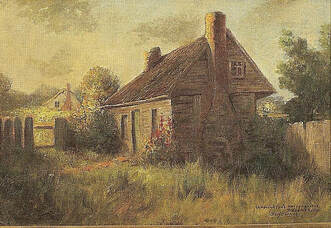 In 1745, Dulany assigned a group of commissioners to design the new western town. They wanted Frederick Town’s streets to run toward the cardinal points. There was already one road going through the new town, running from Pennsylvania to Virginia. This became known as Market Street, because a market would be established here. Another major street would intersect this road north of the Carroll Creek which it paralleled. This would receive the moniker of Patrick Street by the town founder, said to have been done to honor a prominent cousin, Dr. Patrick Dulany, a famous reverend and theologian living in Ireland. The new town was divided into 166 lots, laid out primarily north to south, with sizes ranging from 60 to 63 feet wide and 355 to 395 feet deep. The few people who bought their own lots paid two pounds, 10 shillings (about $3.20) with an annual ground rent of one shilling (roughly $.25) for 21 years and two shillings a year thereafter. A majority of residents leased lots, paying Mr. Dulany a quit rent of a shilling sterling. Frederick Town arose as the Maryland colony's first planned unit development. Daniel Dulany had a vision for his town and had to overcome challenges of being positioned in the backlands of the colony, while not having a navigable waterway. Regardless, he specifically began a unique marketing strategy of recruiting German immigrants from Pennsylvania and Europe. Dulany also started attracting English coming up from southern Maryland and the tidewater area of Virginia, looking for a new place to conduct business. The developer’s goal was to create a major trading market on the western frontier of the time. “Out of the Reach of Oppression” Early German settlers included the names of Brunner, Shellman, Kemp, Raymer, Grosh, Fout, Houck, Holts, Reich, Bentz, Brengle, Mantz, Conradt, Young, Kolb, and Getzendanner. These people had fled from the oppressive restrictions of their homeland to seek a refuge here for themselves and their families. They brought with them their language, culture, and industry. Another German family who made the long overseas journey was that of John Thomas Schley who history books claim built the first house in town in 1746 on East Patrick Street and Stein Alley (today's Maxwell Alley). This log and stone structure was two-stories high and had a gabled roof. Schley came to America for religious reasons and was the leading member of the German Reformed congregation in this new settlement. In 1748, Schley and his congregation built a log church on a lot that ran between West Church and West Patrick Streets donated for the purpose by Daniel Dulany. Frederick's founder donated lots to multiple congregations as he knew that these would serve as the centers of religious, educational and social life for these settlers living on the western frontier at the time. One of the area’s earliest settlers, Jacob Steiner, or Stoner (1713-1748), was one of the six men who tried to buy “Tasker’s Chance” in the late 1730s. Of the 19 individuals who initially received deeds from Dulany in 1746, only Steiner received more than one parcel. He held three lots, all located northeast of the newly laid-out town. Steiner operated a mill near the mouth of the Tuscarora Creek and named his lands “Bear Den,” “The Barrens,” and “Mill Pond,” the latter on which he erected a late medieval-style stone and timber dwelling. The ruins still stand amid the Worman’s Mill community. Steiner built the town’s first brick structure and later it was used as a tavern. The two-story building sat on the southwest corner of the village square at the intersection of Patrick and Market streets where Colonial Jewelers is today. One more immigrant of note to speak of was Joseph Brunner, who, with his family, immigrated to America in 1729 from a home in Schifferstadt (near Mannheim) Germany. The family landed in Philadelphia and eventually arrived in Maryland by 1744. Brunner bought 303 acres of land from Daniel Dulany for 10 pounds in 1746. He named his tract “Schifferstadt” after his native home. His son, Elias, completed a stone house on the property in 1756 which still stands today and serves as a unique architectural museum. It typifies German colonial architecture with two-and-a-half foot-thick walls, hand-hewn oak beams, exposed half timbering, and cross-and-bible doors with highly wrought elbow locks and hinges.  Daniel Dulany promoted his growing town by sending advertisements to Lord Baltimore, who in turn circulated these in Germany. In these inducements, Dulany used the immigrants who had already settled in Frederick Town to give glowing testimonials about his land and good will. The Germans greatly influenced early Frederick where the native language was more commonly spoken here than English. The style of houses and barns built also reflected German craftsmanship not English. Together with English and Scotch-Irish immigrants, the Germans forged the foundation of the small, land-locked village 40 miles from the nearest port. Some may have expected that the varied interests, habits and prejudices of these different cultures would have kept them apart. This was not the case as these pioneers found themselves in a wild country living near sometimes hostile Indians. The settlers faced all the difficulties and the dangers of frontier life. In spite of this, Frederick Town became a thriving community, attracting many tradespeople, including weavers, tailors, shoemakers, blacksmiths, and wheelwrights.  Maryland Gazette (Dec 14, 1748) Maryland Gazette (Dec 14, 1748) A New County At the time of its founding, Frederick Town was part of Prince George’s County which, along with Anne Arundel and Baltimore counties, encompassed most of the Maryland province’s western shore. With increased immigration to inland areas, the residents of western Prince George’s County petitioned the provincial government to form a new county. In 1739, Benjamin Tasker introduced the first bill to create a new county. After nine consecutive, annual attempts, the proprietary government agreed for Daniel Dulany’s fledgling village to serve as the county seat, helping to bring additional value and prestige to his planned community investment. Frederick County was formed by a legislative act on December 10th, 1748 and included the entire western part of Maryland. A county court system was established here in Frederick Town with sheriffs and justices of the peace. A courthouse and jail would be built. The commissioners purchased lots 83-88 from Daniel Dulany in 1750, today this serves as the site of Frederick's City Hall. Travel Crossroads Frederick Town’s remoteness forced it to become an independent town from the beginning. Travel was difficult and distances great. The earliest settlers built their own farms and houses and provided for all their own needs. As Frederick Town grew, more craftspeople settled here to provide services and supplies to the residents. Tailors, scriveners, jewelry makers, printers, hat makers, and tanners were among the leading businesses found in town. Many rented, while some owned these examples of Frederick Town’s earliest commercial real estate. The main thoroughfare to and from various colonies passed through Frederick. In a few years, a public road was built from Frederick to Annapolis. The town became a stopping place for weary travelers. To accommodate the many visitors, taverns were built along the route. During this period, Annapolis was an important trading port and the road from Frederick was used by area residents to haul tobacco and flax to the shipyards. Frederick Town expanded rapidly, soon becoming the second largest town in Maryland, an honor it continues to hold today. Thanks to British Gen. Edward Braddock’s ill-fated mission during the French and Indian War, the first road west had been established and carved out to Cumberland. This later would become the National Pike, utilizing Frederick’s Patrick Street. Years later, during the American Revolution, a British military member wrote of this unique residential and commercial setting in his journal: "Frederick Town is a fine large town and has a very noble appearance as the houses are mostly formed of brick and stone, there being very few timbered buildings in it; it contains near 2,000 inhabitants, chiefly German." -Lt Thomas Ansburey, 1778 The community continued to grow as the new country further formed itself following the American Revolution. As for realty pursuits with issues such as land and home sales, transfers, building, etc., people were traditionally selling and buying on their own accord with official documentation being approved and stored at Frederick County’s courthouse. Sometimes a lawyer was involved, sometimes not. Regardless, it continued to be a good place to be if one was in the legal profession as the seat of county government and considering the abundance of court transactions necessitated in a large county brimming with growth. More villages had sprung up around the county and served as centers for farm shipping and markets for the surrounding countryside. Along the National Pike, Middletown gives its founding date as 1767 and New Market was laid out in lots in 1793. Libertytown arose in 1782 along the Liberty Road. In northern Frederick County, Emmitsburg came to be in 1785, and Mechanicstown (later named Thurmont) came in 1803. To the south, a gentleman named Leonard Smith would be responsible for laying out two more locations: Jefferson in 1774 and Berlin (later named Brunswick) in 1787. Buckeystown dates from the 1780s on the early land grant of Carrollton Manor. The 1800s The turn of the century came in 1800 and in a little more than 50 years since Frederick Town was founded, the village had quickly grown from a cluster of settlers into a thriving community, drawing the attention of prominent visitors and politicians. Its residents, mostly hardy German immigrants, rose above an unfriendly environment, so far away from a trading port. It had begun as a place of dense woods and wild animals, not to mention the residents having to endure early threats of Indian attacks and two major military threats with European foes, with a third to come in 1812. Frederick Town became an incorporated city in 1817, and the county continued to grow as the National Pike further took form. Settlers and goods made their way to, and through, town in directions east to west and north to south. The Baltimore & Ohio Railroad arrived here in 1831, as did the Chesapeake & Ohio Canal.  Early image of the B&O with open air passenger cars Early image of the B&O with open air passenger cars Settlers and goods made their way to, and through, town in directions east to west and north to south. The Baltimore & Ohio Railroad arrived here in 1831, as did the Chesapeake & Ohio Canal. Both entities gave rise to the previously mentioned Berlin, and another hamlet on the Potomac River that would take the unique name of Point of Rocks. Later in the century, train activity shaped Ridgeville, (eventually renamed Mount Airy in 1894) and further advanced Thurmont in terms of trade and tourism, as a cool-air, mountain retreat. Daniel Dulany's community turned 100 in 1845, a time of renewed building with unique public structures such as churches and schools, and additional floors or amenities to residential buildings. In this latter case, some original dwellings were replaced with modern architectural designs. Some of the other towns of the county would become incorporated during this century and further refined through progressive means. A brief, but major, interruption came mid-century with the American Civil War. Residents saw large armies come through hometowns, and in some cases experienced camping regiments, skirmishes and battles. A return to normalcy would eventually take place, and agriculturally based, light industry evolved further in the form of leather tanneries, sanitary dairies, canning companies and fertilizer and limestone works. Iron manufactories, a knitting mill, brickworks, and a major brush company would eventually arise here. In addition to farming, blue collar and professional jobs were available, and homes were certainly needed to house these individuals. Community building continued to grow in earnest thanks to churches, fraternal organizations and benevolent charities. In the City of Frederick's overview history by Diane Shaw Wasch and found on the City's website, the author states: "Plans for residential development beyond the established city grid began with the platting of Clarke Place on the south end of town in 1894. The plan for Clarke Place was a sign of the suburban development that would take hold in the early twentieth century, with large single houses on lots with deep setbacks from the street. Adopting the Late Victorian and Colonial Revival architectural styles, which emphasized larger individualized building forms, these houses signaled a distinctive new appearance in Frederick architecture. West of the city grid, street extensions shown on the 1897 Sanborn Fire Insurance Company map reveal significant plans for future subdivision. The end of the nineteenth century saw a renewed energy in Frederick’s development. The city was well established with thriving agricultural markets, particularly the emerging dairy market, as well as a diversified light industrial base, and a growing number of wealthy citizens associated with the railroads, business, and legal community. City streets were paved and lit with electric lights, and telephone service was available to city residents. The century’s end was punctuated with the formation of a hospital organization, dedicated to the construction of a state-of-the-art hospital on the north end of town, and the establishment of an inter-urban railway system that eventually connected with Emmitsburg to the north, Jefferson to the south, and most importantly, the railroad hub city of Hagerstown to the west." Real estate was bought and sold, sometimes with just a handshake. More often, a special professional's help became more and more desired to assist the home, or business, seller. Of course, many sellers sought a lawyer's counsel to consummate the deal, but there were those who prided themselves of being specialized salesman of dwellings and possessed the monetary means and connections to help gain loans or mortgages for would-be buyers. The profession of real estate broker began around 1900 here in the United States. The initial home sale records began here around 1890. There was actually an attempt to create the first real estate association in the country at this time, however, the effort failed. This exercise did help set a base for the process for later. There would be few, if any, set rules about who could work as a real estate broker. Hence, there were no licenses or professional certifications to become a registered broker, leading to dubious practices with many engaged in this line of work known as "curbstoners." Anyone could place a sign on a property to sell the house, creating a sort of “wild west” in real estate. This led to “curbstoners” placing signs in front of homes to compete amongst themselves and mortgage brokers, with the seller having to randomly pick a sign in which to help sell their house. 1900s Hometown USA While Frederick may have prospered near the end of the 1800s, the first 50 years of the next century would be one of slow growth. Some historians have described Frederick as a “sleeping giant” during the first five decades of the 1900s. Frederick still had the largest land area of any county in Maryland, but by 1920, Baltimore, Allegany and Washington Counties would exceed it in population. Many industries eyed Frederick as a potential business site, but town officials made no serious attempt to lure companies here. Therefore, the economy remained at a steady, if not declining pace, for the first half of the 20th century. Research shows that some of the older families and leading citizens of Frederick thought their peaceful town in western Maryland may be growing a little too fast for their tastes. There was a fear of too much industrialization, or dirty factories, coupled with the opportunity for railroad interests and trade unions to gain power from those whose forefathers braved the former trials of frontier existence. Other social influencers simply wanted to remain “big fish in a small pond.” Steps by some leading, local citizens appear to have been taken in discouraging major industry to locate, or build, here. Frederick simply remained known for its abundant farming efforts and possessing the oldest railroad depot in the United States, but certainly not the busiest. Two railroads came through Frederick County, but Frederick City was simply more of a terminus of spur lines as the railroads were never fully embraced. One could easily see the the growth and change brought with railroad and its influence on major industry in the nearby towns of Hagerstown, Martinsburg and Cumberland. All three places fast outgrew Frederick in population, along with economic and industrial prestige. Frederick would, however, incur considerable change in another way. Transportation innovations would help spark suburbanization. The advent of the automobile was key to this change currently sweeping the nation. Frederick (city and county) would also receive its own trolley line in 1896 which accelerated suburban and interurban activity. Into the 20th century, this form of mass transportation would link Frederick City to the Middletown Valley and Hagerstown to the west, and another trolley line would connect points north en-route to Thurmont from Frederick. Farmers could ship produce and milk to Frederick with greater ease, and necessity goods and items could be sent to those living in rural areas from the commercial seat of the county. While industry lagged, living amenities were enhancing the lives of Frederick residents. Perhaps this was the genesis of Frederick’s standing later in the 20th century as a bonafide “bedroom community.” A common constant was that Frederick would be seen as a great place to live and raise a family—a true “Hometown, USA.” Stately neighborhoods would begin to take shape in Frederick City as large homes began being built and pushing city limits outward. Referenced earlier, a row of thirteen homes along Clarke Place were constructed in 1894, exemplifying all the characteristics of the Victorian and eclectic eras of architecture. Located in the south end of downtown Frederick, off South Market Street, the development was built to front the newly built Maryland School for the Deaf, which occupied the former grounds of a barracks facility built at the time of the Revolutionary War. The unique neighborhood took the name of Clarke Place after local native, Gen. James C. Clarke—a past president of the Chesapeake and Ohio Canal and several railroads including the Illinois Central Railroad. This area represented a new trend in the history and development of Frederick’s home design as most earlier examples fronted on the public sidewalk, featured a rear yard, and were two or three bays wide. According to Frederick City Planner, Christina Martinkosky: “The new neighborhood was unique in that it was the second planned extension to Frederick since the city was initially platted and the first not to mimic the long, narrow lots that typically define downtown Frederick. Instead, the development features wide lots that influenced the character of the neighborhood in several ways. It allowed for the construction of homes with large proportions and architectural features that were popular during the Victorian and Eclectic eras including front porches, projecting bay windows and towers. The generously sized lots allowed the large homes to be setback from the street and feature rear and side yards. In fact, deed restrictions on each property required that the new homes be set back 50 feet from the street and prohibited the construction of “double-houses” or offices. Over time, the neighborhood was built with homes designed in the Queen Anne and Colonial Revival styles, which were popular at the time and featured grassy lawns planted with Norway maple trees.” The area was previously part of farmland owned by Dr. Bradley Tyler and purchased by the South Park Villa Company, founded by Dr. Joseph A. Williamson, Harry W. Bowers, and Willard C. Keller. The homes along Clarke Place served as a precursor to the suburban development that would take hold in the early 20th century, featuring large, single-family homes on lots with deep setbacks from the street. Another example to follow included luxury housing being built on the northside of the 200 block of East Second Street. In 1903, the Jesuit Novitiate across from St. John’s Church was torn down. On this site, a handful of large homes were constructed. As trolley lines enabled people to move from the center of town, some relocated to Rockwell Terrace, a suburban development laid out and recorded in 1905 by local businessman Frank C. Norwood. Named after Elihu Hall Rockwell, former educator and native of New England, Norwood obtained the namesake’s property and house fronting on North Bentz Street at the head of West Third Street from a descendant. Mr. Norwood would move the house, thus opening West Third with a continuation thoroughfare he would call Rockwell Terrace. This area soon became the most desirable location in town, as the new neighborhood would be built under the leadership of Norwood and the West End Realty Company. To the west of Frederick, Braddock Heights was a byproduct of the trolley system as its parent company, the Hagerstown & Frederick Railway, built an amusement park atop Catoctin Mountain here. The location quickly grew as a resort for summer living. Attracted by the lush mountains and quiet atmosphere, prominent families and others, many of which had homes in downtown Frederick, built spacious cottages here that would capture fresh, mountain air and afford sweeping views of both the Frederick and Middletown valleys. Lewis Henry Dill (1821-1894), son of Joshua and Mary Dill, eventually came to own the property north of today's Dill Avenue and across the street from Frederick's first Presbyterian Church and graveyard. Mr. Dill's father was an innkeeper and War of 1812 veteran. Lewis lived on the northwest corner of N. Bentz Street on what was called (during his lifetime) the Almshouse Road, and eventually Montevue Road as it departed W. Fourth Street and headed in the direction of the former county home for aged and needy citizens. The street was also called the New Cut Road and Fourth Street Extended as well. The permanent renaming wouldn’t come until August, 1901 when Frederick alderman John Baumgardner suggested the name of Dill Avenue to replace the W. Fourth Street Extended moniker. It was duly accepted, and the rest is history. As for Lewis Henry Dill, he made his living as a farmer and large landholder. The College Effect The former Women’s College of Frederick announced plans in 1911 that Mrs. Margaret Hood had donated a parcel of land to the female learning institution for use as a new campus. This locale had once been known as Groff Park, home to a shooting club known as Deutsches Schuetzen Gesellschaft Park. This was a social and stock endeavor formulated by leading German-descended residents. Present-day Brodbeck Hall (on the campus of Hood College) served as the clubhouse for the group, which came complete with an old-fashioned beer garden to accommodate stockholders. The Civil War and lean times caused financial woes that the club could not rebound from, and apparently Capt. Joseph Groff, a local hotel keeper, purchased the locale. Hood College moved from its previous location on East Church Street to a new campus on the northwest part of town in 1913. This area was now destined to expand even further beyond Rockwell Terrace, truly the most desirable residential location in the city, away from the sights, sounds and smells of industry and trains primarily located in the southeast part of Frederick, containing the tanneries, grain mills, packing plants and canneries. Existing homes bounded Dill Avenue, an extension of West Fourth Street west of the intersection with North Bentz Street. The Zimmerman Farm was located to the immediate west of Mrs. Hood’s donated land for the college. Ninety acres would be purchased by local attorney Harry G. Tritapoe and business partner Eugene Sponseller. These gentlemen would lay out, and sell, building lots here in 1913. This subdivision would take the name of the former poultry farm --"Rosemont." Montevue Avenue would soon after take the name of the venture—Rosemont Avenue. Two gentlemen of particular interest in the Rosemont story are Elbridge F. Biggs and John M. Culler, who jointly bought eight building lots here in 1913. Their purchase constituted the entire 1st block of Fairview Avenue, north of Rosemont Avenue. Meanwhile, to the east of the immediate campus, fine homes began being constructed on the extension of West Fourth Street immediately next to the proposed campus and along Elm Street. This newly created street led to a new public school that would take the thoroughfare's tree-themed name. There had been some residential building activity on the east side of town already. Hamilton Street, across from the fairgrounds, and a few other lots in this vicinity had popped up on the old eastern entryway into town. East Fifth and East Sixth streets experienced residential growth as would North Market Street. The place to be, however, was the in the northwest part of town in proximity to Rosemont (Montevue) Avenue. Soon after Rosemont lots began being sold, other neighbors in this vicinity would “give up the farm” so to speak, allowing additional plans for development around the new education center of Hood College, which opened in 1913. Farmland would be purchased and soon gave way to two future subdivisions: “Villa Estates” and the aptly named “College Park.” Controversy erupted among some locals because this was being orchestrated by an outsider named Edward L. Williams from Martinsburg, West Virginia. He called his company “Swastika Realty." Some residents of Rockwell Terrace, along with local businessmen and others were outraged at this perceived “carpet-bagger” subtly challenging Frederick’s resident “big fish.” The neighborhood coined as “the Residential Showplace of Frederick” was now being challenged for supremacy by a new one, initially touted as having “the most picturesque views in the city.” Villa Estates was announced in late April of 1913 as being unique for having country style lots in which they could "have a lawn, chickens, a garden and fruit trees." Interested buyers were enticed by free trolley ride vouchers placed in the newspaper to encourage a visit to learn more. From the outset, Villa Estates, would be delayed and hampered by slander and blockages to a water supply, thanks in part to the current mayor and board of alderman. This became a major problem over the next year as Mr. Williams had been rejected by the city fathers after ten attempts to obtain water. A compromise came with a change of administration as Lewis Fraley won the mayor’s race in late 1913 and worked with his Board in the new year upon taking office. The necessary supply was allowed by summer of 1914. College Park had its own opposition as well as already stated. To combat sentiment, Mr. Williams hired noted landscape architect George Burnap to provide the architectural design, if approved. Mr. Burnap helped design areas of New York’s Central Park and was also responsible for Hagerstown’s City Park among many others. He worked as a landscape architect for the Office of Public Buildings and Grounds in Washington, DC between 1912-1917. His work in the nation’s capital includes Meridian Hill Park and the White House’ West Garden. A contentious meeting held at City Hall in early September 1913 resulted in the Frederick Board of Alderman giving the ultimate green light to this project. Soon, luxurious houses began being built along West Third and Fourth streets, west of Rockwell Terrace. Mr. Burnap employed a design of angled lots radiating around a central parcel shaped in the form of a heart. This particular “heart” plot would become Schley Park, named in honor of Frederick’s Admiral Winfield Scott Schley, a naval hero in the Spanish-American War. The Rosemont subdivision was the local challenger to Mr. Williams’ projects. Not as professionally handled as its rival subdivision projects, an advertisement appeared in spring of 1914 announcing an auction of 50 lots in this section north of Rosemont Avenue. This occurred just prior to the water approval for Villa Estates and was put on by the American Realty and Auction Company of Greensboro, North Carolina. Of note, gimmicks were used here in offering a free lunch which was a great incentive, but not more than the promise of $10 in gold for “the automobile owner who brings the largest number of white grown-ups.” The sale signified the future need for more scrupulous real estate practices. Mr. Williams clearly felt the wrath of his rivals and now wisely looked toward well-rooted local professionals to sell on his behalf. Beginning in May 1914, a new realty firm put up their respective shingle. This was Potts & Griffin. Two years later, this tandem began selling lots for Mr. Williams and the College Park Real Estate Company. New development plans would be slowed in the years of 1917-1918 due to World War I, but normalcy returned after the signing of the Armistice peace treaty in November 1918 and return of local soldiers in early 1919. Businesses flourished, and suburban residential development commenced as the period labeled “the Roaring Twenties” would soon take hold. Walker Neill and John J. Joliffe would purchase "Villa Estates" and take over sales here in 1919. Another gentleman named John N. Clary could be found selling lots in all three new subdivisions (Villa Estates, Rosemont and College Park) located northwest of town. Mr. Clary was a veteran in the industry with experience dating back to the previous century. Luckily the heated rivalry and real estate version reminiscent of “the Hatfields & McCoys” would end for not only the good of the community, but more so for innocent would-be buyers. The trolley, or Hagerstown & Frederick Railway, would change its name to the Potomac Public Service Company in 1922, and shortly thereafter to the Potomac Edison Company. Electricity and indoor plumbing were life-changing amenities. Homeownership would become further re-imagined. Frederick remained a peaceful city with tree-lined streets and devoted citizens working toward public improvements. The same held true with the smaller towns and villages throughout the county. This was a special place, and the year 1922 marked the start of a real estate-based organization whose timing was perfect for residents, old and new. Frederick was also a unique location to serve and accommodate visitors. Some were here on business, others here for pleasure, while many folks were just passing through en-route to some other destination by automobile. Regardless, it was hard not to be impressed with the look and feel of Barbara Fritchie’s town of “clustered spires, green-walled by the hills of Maryland.” The principal hostelry of town, the New City Hotel, was razed in early 1921 to make room for a new hotel. Under the leadership of local businessmen such as Charles McCurdy Mathias, Sr. and Col. David John Markey, a luxurious, six-story establishment would soon carry the name of another one of Frederick’s leading historical figures, Francis Scott Key, writer of “the Star-Spangled Banner.” The hotel would be built in 1922 and opened the following January. The facility was a “state of the art” amenity for its time and helped further proclaim the importance and potential of a community steeped in rich history and the American experience. Building in, and around, Frederick was booming. The controversies tied to the Villa Estates and College Park projects in allowing outside interests to dictate municipal policy was a great impetus to having “home rule” through and through. As stated earlier, this was the same reason the railroad wasn’t embraced nearly a century earlier. However, many saw that the unscrupulous practices of some locals, if left unchecked, could also have devastating effects on the future of a growing town originally began as a planned community on the colonial frontier of Maryland. Now was the perfect time for leading local land brokers to establish a formal Real Estate Board for the very first time. This would occur in February 1922. ***Be sure to check out parts 2 & 3 of the centennial history of Frederick County Association of REALTORS® (Click below)
“Being at the wrong place at the wrong time,” an expression we hear quite often when a hapless victim encounters a tragic event that many times leads to serious injury or, worse yet, death. My full-time job is that of a historian for a cemetery, so you can imagine I think of the fore-mentioned saying a lot. One of the best examples I’ve come across involves a prominent Frederick businessman in the mid-1800s named Henry Goldenberg. Five years after his move from Frederick in the year 1884, Mr. Goldenberg would meet a fateful end in one of the country’s worst-ever disasters. It happened in a bustling town in western Pennsylvania. Born in 1833, Henry Goldenberg was born and raised in Neheim, a town of Prussian Westphalia, located ten miles northwest of current-day Arnsberg, Germany. His parents, Jacob Goldenberg and wife Rachel (Rose) Goldenberg, left a country in turmoil and came to America in 1852 with their eight children. They would settle in Baltimore’s 7th Ward, northeast of the inner harbor in the vicinity of Johns Hopkins University and Medical Center. Early advertisements appear in the Baltimore newspapers touting the millinery expertise of a Mrs. H. Goldenberg in the Ward 7 sector of Charm City. Henry’s brother, Daniel Joseph (Goldenberg), is mentioned in connection here, and would be linked to Henry's business endeavors for decades to come. Four years later (1857), the following advertisement appeared in the Frederick Examiner newspaper touting Mrs. Goldenberg’s talents. Henry Goldenberg would soon be living in Frederick with his wife, the former Mary Eva Nardhaus, also a native of Prussia. Henry moved to town permanently in 1859 and opened his shop on the east side of North Market Street between the old Market House building (today’s site of Brewer’s Alley Restaurant) and Second Street. This was formerly the site of Michael Engelbrecht’s tailoring shop. The location is today under Market Alley which runs along the north of Brewer’s Alley Restaurant. This time period would mark an important era in Frederick’s Jewish history as the Goldenbergs and other Jewish families from Baltimore (like David Lowenstein and Jacob Rosenstock) would settle here and open clothing and other businesses.  Looking north on North Market Street midway between Church and 2nd streets. This photo dates to February, 1862 and a military display by Union troops in honor of George Washington's birthday. On the right side of the street is pictured the Market House to the immediate north of Andrew Boyd's awning shown here. The Goldenberg's store/home was two doors to the north. Mr. Goldenberg is mentioned in the writings of the brother of the above-mentioned Michael Engelbrecht. This was Frederick’s loquacious diarist, Jacob Engelbrecht (1898-1878). In that same year of 1859, he wrote: “Mr. Henry Goldenberg voted today at the Market house polls for the first time. He was naturalized on the 11th day of October 1859 in the Court of Common Pleas of Baltimore City. William Lee, Marshall, Thomas Creamer, Sheriff, William J. Hamill, Clerk.” Engelbrecht took a liking to Henry as they were both in the clothing business (Engelbrecht was a tailor by trade) and both had deep German roots. As if it wasn’t a challenge enough to open a new business in a new town, the Goldenbergs had to navigate through the American Civil War and Frederick’s major role played within it. Henry Goldenberg showed fellow residents his patriotic colors by participating as a member of the Brengle Home Guards in April 1861. The local militia group soon found themselves performing important roles of protecting Maryland’s governor (Thomas Hollyday Hicks) and state legislators convened here throughout the summer of 1861 and meeting at Kemp Hall (SE corner of N. Market and E. Church streets) instead of the State House in Annapolis. Henry Goldenberg’s military service would not extend to the US Army, although he registered for the draft. He continued to serve the community through his mercantile endeavor. Goldenberg evolved into a spectacular marketing guru, with his plentiful ads filling the pages of early Frederick newspapers of the era. From at least 1859 until Dec 1861, there had been a Goldenberg & Company located "2 doors N of Market House.” In 1861 Henry bought the stock of goods from the store room of another brother named Julius Goldenberg. Julius was described in the deed as trading under the name of Goldenberg & Company in dry goods, fancy and millinery goods. Julius had become indebted to Henry on 3 due bills given to Henry for wages owed him as clerk in the store – in August 1859 for $225, August 1860 for $270 and June 1861 for $220. So for that $715 owed, and another $500 cash, Julius sold Henry the stock and good will of the establishment. A new location for the family business would come about as the Goldenberg millinery and fancy goods store would locate across the street from its original location. The move wasn't far as the new setting was exactly across Market Street from the Market House (which would be soon razed and the new City Hall and Opera House would be built on its site.) The Goldenberg endeavor would have an address of 73 and 75 N. Market Street. The property was rented to him by Margaret Engelbrecht, widow of John Engelbrecht, another sibling of the diarist Jacob. Of additional interest, Goldenberg was reported to have had one of the first open storefronts of any business in town. Since no other property records, outside of these store locations, link to the Goldenberg family, I’m assuming they lived in the same sites as the business locations. My research assistant, Marilyn Veek, only found one real deed associated with the Goldenberg family. This was a one square-foot piece that Henry bought in 1877 from William Kline, along with a 1-inch right of way, which was behind what is now Asiana Restaurant and not next to the store he actually rented for his business. What was this all about? Henry Goldenberg further vested himself in civic functions and social organizations of town. Of key interest was his involvement in Frederick’s Masonic Lodge and would serve in various leadership roles. Things seemed to be going good, and in 1879, Henry joined forces with fore-mentioned brother Daniel Joseph Goldenberg of Baltimore in a business partnership. Something went seriously wrong in the first few years of the 1880s for the Goldenbergs. In 1882, advertisements announce the dissolution of the partnership between Henry and his brother, Daniel. I haven’t figured out all the details but D. J. Goldenberg encountered a major setback when a fire destroyed his location on Lexington Street in Baltimore. This seems to have had an impact on the Frederick (MD) Goldenbergs as a newspaper ad in the local paper in 1883 seems to paint a rather gloomy outlook for the discount Millinery business-owners. In 1883, Henry signed a deed of trust with his brother-in-law Philip Stern to sell all of his stock in trade and fixtures in the store room occupied by him on N. Market and all his other property, to pay off his creditors, as well as taxes due and salaries due to his employees. This implies that the store still existed until 1883. (Note: A newspaper article in 1885 mentions that Philip Stern for several years conducted a notion and ladies store on Market St, but now intends to quit business and remove from Frederick, so maybe Philip took over the store.) In early 1884, the Goldenbergs time in Frederick was up. They chose to head west and put into motion an opportunity in Pennsylvania and a boom town located some 70 miles east of Pittsburgh. With two sisters living in Altoona, the Goldenbergs chose to reside in Johnstown in Cambria County. Johnstown, Pennsylvania was settled in 1770 by Swiss German settlers at the intersection of the Conemaugh River which split into the Little Conemaugh River to the east east and Stoneycreek River flowing south. A century later, the small village grew into a bustling town thanks to the success of the Cambria Iron Works. Henry Goldenberg took up residence at 54 Lincoln Street. By help of an 1886 Sanborn Insurance map, I have a strong hunch that the Goldenberg Millinery store was located across Stoneycreek River from their residence in the first block of Morris Street in the southwest portion of town. Although firmly transplanted in his new home in Johnstown, Henry and other family members never lost their love for Frederick. The first big blow to the family came in August 1885 with the death of Henry’s wife, Mary Eva. Her body would be sent back to Baltimore for burial at Hebrew Friendship Cemetery. The family pulled together and moved forward without Mrs. Goldenberg. Everything was going swimmingly, probably not the best term to use, until 4:07pm on May 31st, 1889. One day earlier, on the afternoon of May 30th, 1889, it began raining in the Conemaugh Valley, but luckily Johnstown had just managed a quiet Memorial Day ceremony and parade earlier in the day. Twenty-four hours later, water filled the streets of a town that was certainly no stranger to annual flooding. However, this time things were a vastly different. As rumors had swirled that a dam holding an artificial lake in the mountains to the northeast might give way, the ill-fated prophecy would come true on this dark day. The South Fork Dam collapsed 14 miles upstream from Johnstown due to the heavy rains. In the process, an estimated 20 million tons of water began spilling into the winding gorge that surrounded the Little Conemaugh River as it led to Johnstown. Historians claim that the force barreling toward Johnstown had a volumetric flow rate that temporarily equaled the average flow rate of the Mississippi River. A massive tragedy would strike the town and its unknowing residents downstream in ten minutes time. What had been a thriving steel town with homes, churches, saloons, a library, a railroad station, electric street lights, a roller rink, and two opera houses was buried under mud and debris. Out of a population of approximately 30,000 at the time, at least 2,209 people are known to have perished in the disaster. One of the most graphic descriptions of the carnage experienced in Johnstown can be found on the National Park Service’s memorial: “But at 4:07pm on the chilly, wet afternoon of May 31, the inhabitants heard a low rumble that grew to a “roar like thunder.” Some knew immediately what had happened: after a night of heavy rains, the South Fork Dam had finally broken, sending 20 million tons of water crashing down the narrow valley. Most never saw anything until the 36-foot wall of water, already boiling with huge chunks of debris, rolled over them at 40 miles per hour, consuming everything in its path. Those who did see it said it “snapped off trees like pipestems,” “crushed houses like eggshells,” and “threw around locomotives like so much chaff.” A violent wind preceded it, blowing down small buildings. Making the wave even more terrifying was the black pall of smoke and steam that hung over it—“the death mist” remembered by survivors. Thousands of people desperately tried to escape the wave, but they were slowed as in a nightmare by the 2 to 7 feet of water already covering parts of town. One observer from a hill above the town said the streets “grew black with people running for their lives.” Some remembered reaching the hills and pulling themselves out of the flood path seconds before it overtook them. Those caught by the wave found themselves swept up in a torrent of oily, yellow-brown water, surrounded by tons of grinding debris, which crushed some, provided rafts for others. Many became helplessly entangled in miles of barbed wire from a destroyed wire works. People inside when the wave struck raced upstairs seconds ahead of the rising water, which reached the third story in many buildings. Some never had a chance, as homes were immediately crushed or ripped from foundations and added to the churning rubble, ending up hundreds of yards away. Everywhere people were hanging from rafters or clinging to rooftops and railcars being swept downstream, frantically trying to keep their balance as their rafts pitched in the flood. It was over in 10 minutes, but for some the worst was still to come. Thousands of people, huddled in attics or on the roofs of buildings that had withstood the initial wave, were still threatened by the 20-foot current tearing at the buildings and jamming tons of debris against them. In the growing darkness, they watched the other buildings being pulled down, not knowing if theirs would last the night. But the most harrowing experience for hundreds came at the old stone railroad bridge below the junction of the rivers. There, thousands of tons of debris scraped from the valley, along with a good part of Johnstown, piled up against the arches. The 45-acre mass held buildings, machinery, hundreds of freight cars, 50 miles of track, bridge sections, boilers, telephone poles, trees, animals, and 500-600 humans. The oil-soaked jam was immovable, held against the bridge by the powerful current and bound tight by the barbed wire. Those who were able began scrambling over the heap toward shore. But many were trapped in the wreckage, some still hopelessly hung up in the barbed wire, unable to move. Then the oil caught fire. As rescuers worked in the dark to free people, the flames spread over the whole mass, burning with “all the fury of hell.” One of the unfortunate victims was none other than Frederick’s former resident, Henry Goldenberg. A book entitled The Story of Johnstown was written in 1889 by J.J. McLaurin. The author received information about Frederick’s former resident. The news reached Baltimore and Henry’s brother D. J. Goldenberg before it hit Frederick shortly thereafter. Mr. D. J. Goldenberg, of 727 West Lexington street, has received a peculiar dispatch about his nine relatives at Johnstown. It reads: "At Rockwood with corpse; will be delayed at Cumberland." This is signed "Jennie Goldenberg." His anxiety is very great as to the identity of the only one who succumbed to the elements. His relatives are: Henry Goldenberg, a brother, formerly of Frederick, Md.; the latter's four daughters, (the youngest aged 16) and two sons. Mrs. Phillip Stern, of Frederick, Md., a sister, together with a sister-in-law, Mrs. Jos. Goldenberg of Philadelphia, were on a visit to Mr. H. Goldenberg and are therefore in the flooded district. Mr. D. J. Goldenberg, of this city, received a telegram yesterday, dated Rockwood, Pa., from his niece, Miss Jennie Goldenberg stating that she was on her way to Baltimore with the body of her father, Henry Goldenberg, who is Mr. Goldenberg's brother, and who was killed in the Johnstown disaster. He was a native of Germany and had been in America for about thirty-five years. For thirty years he had been a resident of Frederick, moving to Johnstown about four years ago. He had four daughters and two sons, and it is not known how many of them are alive. The Baltimore Sun (June 3, 1889) Here is how the news of Henry Goldenberg’s death appeared to his old friends, neighbors and customers in Frederick.  Barton Barton The American Red Cross, led by Clara Barton and with 50 volunteers, undertook a major disaster relief effort. Support for victims came from all over the United States and 18 foreign countries. The Great Johnstown Flood of 1889 accounted for $17 million of damage (about $484 million in today’s dollars). After the flood, survivors suffered a series of legal defeats in their attempts to recover damages from the dam's owners. Public indignation at that failure prompted the development in American law changing a fault-based regime to one of strict liability. Interestingly, Frederick, itself suffered damage from the same weather system that led to the catastrophe that had transpired in western Pennsylvania. Meanwhile the Potomac, at the Point of Rocks, had overflowed into the Chesapeake and Ohio Canal, and the two became one. It broke open the canal in a great many places, and lifting the barges up, shot them down stream at a rapid rate. Trunks of trees and small houses were torn from their places and swept onward.... A dozen lives lost, a hundred poor families homeless, and over $2,000,000 worth of property destroyed, is the brief but terrible record of the havoc caused by the floods in Maryland. Every river and mountain stream in the western half of the State has overflowed its banks, inundating villages and manufactories and laying waste thousands of acres of farm lands. The losses by wrecked bridges, washed-out roadbeds and landslides along the western division of the Baltimore and Ohio Railroad, from Baltimore to Johnstown, reach half a million dollars of more. The Chesapeake and Ohio Canal, that political bone of contention and burden to Maryland, which has cost the State many millions, is a total wreck. The Potomac River, by the side of which the canal runs, from Williamsport, Md., to Georgetown, D. C., has swept away the locks, towpaths, bridges, and, in fact, everything connected with the canal. The probability is that the canal will not be restored, but that the canal bed will be sold to one of the railroads that have been trying to secure it for several years. The concern has never paid, and annually has increased its enormous debt to the State. At the mountain town of Frederick, Md., the Monocacy River, Carroll Creek and other streams combined in the work of destruction. Friday night was one of terror to the people of that section. The Monocacy River rose rapidly from the time the rain ceased until last night, when the waters began to fall. The back-water of the river extended to the eastern limit of the city, flooding everything in its path and riding over the fields with a fierce current that meant destruction to crops, fences and everything in its path. At the Pennsylvania Railroad bridge the river rose thirty feet above low-water mark. It submerged the floor of the bridge and at one time threatened it with destruction, but the breaking away of 300 feet of embankment on the north side of the bridge saved the structure. With the 300 feet of embankment went 300 feet of track. The heavy steel rails were twisted by the waters as if they had been wrenched in the jaws of a mammoth vise. The river at this point and for many miles along its course overflowed its banks to the width of a thousand feet, submerging the corn and wheat fields on either side and carrying everything before it. Just below the railroad bridge a large wooden turnpike bridge was snapped in two and carried down the tide. In this way a half-dozen turnpike bridges at various points along the river were carried away. The loss to the counties through the destruction of these bridges will foot up many thousand dollars. 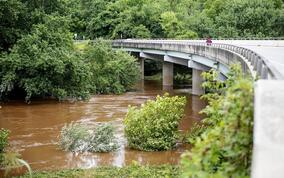 Floodwaters swell the Monocacy at the bridge carrying Reichs Ford Road over the river near Pinecliff Park located southeast of Frederick City Floodwaters swell the Monocacy at the bridge carrying Reichs Ford Road over the river near Pinecliff Park located southeast of Frederick City Mrs. Charles McFadden and Miss Maggie Moore, of Taneytown, were drowned in their carriage while attempting to cross a swollen stream. The horse and vehicle were swept down the stream, and when found were lodged against a tree. Miss Moore was lying half-way out of the carriage, as though she had died in trying to extricate herself. Mrs. McFadden's body was found near the carriage. At Knoxville considerable damage was done, and at Point of Rocks people were compelled to seek the roofs of their houses and other places of safety. A family living on an island in the middle of the river, opposite the Point, fired off a gun as a signal of distress. They were with difficulty rescued. In Frederick county, Md., the losses aggregate $300,000. Monocacy Bridge: Probably one of the oldest landmarks in Frederick county bridges has gone down in the flood. The covered bridge on the Frederick and Liberty turnpike, supposed to have been the first one built here, bearing the date 1834. It stood the storms of over half a century, has never been rebuilt, but many repairs have been put upon it. This morning it went down with the raging current, making a total of six bridges gone along the Monocacy. One part of it is lying at Mr. Kefauver's and another at Mr. Hoke's. 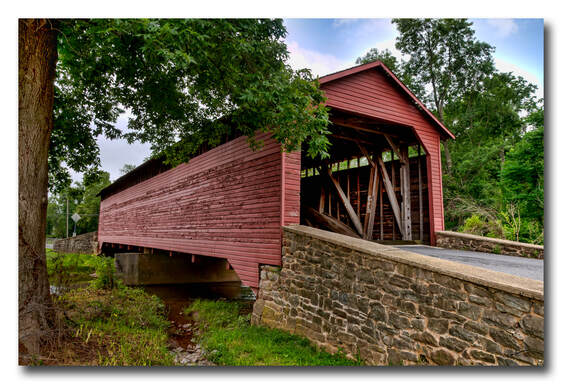 Utica Mills Covered Bridge was also a victim of the storm that created the disastrous Johnstown Flood. It washed away a 250 foot, two span covered bridge over the Monocacy River on Devilbiss Road in Frederick County. One span of the bridge was saved, dismantled and two years later reconstructed as a 101' covered bridge on Utica Road, just off Frederick Road in Utica, Maryland over Fishing Creek. The original bridge is usually referred to as Devilbiss Road Covered Bridge. Most documentation shows the original bridge as constructed c1850, but many believe it was actually built in 1843. Although the bridge was moved from its location over the Monocacy, it still consists of original timber from the Devilbiss Bridge, so it retained its build date as 1843 and was renamed Utica Mills Covered Bridge. (Photo by Roger Lancaster on Flickr) Henry Goldenberg's son Daniel was living in Baltimore during the tragedy in Johnstown. Ironically, he almost became a drowning victim himself by evidence of this newspaper article in July, 1889. In the fall of 1889, D.J. Goldenberg, Henry's brother and former business partner, ran the following ad in the Frederick paper touting the fact that his late brother's daughters would help serve Frederick customers at a special sale at his Baltimore store location.
As for Johnstown, the citizenry, with aid from people, towns and companies from all over the country, rebuilt the town bigger and better than ever before. Another major flood occurred in 1936. Despite a pledge by President Franklin Delano Roosevelt to make the city flood free, and subsequent work to do so, another major flood occurred in 1977. The 1977 flood—in what was to have been a "flood free" city—may have contributed to Johnstown's subsequent population decline and inability to attract new residents and businesses. To learn more, I've included this link to a seventh grader's video presentation which does a fine job in telling the complete story of the disaster. This came courtesy of the National Park Service.(Click Here for video) History Shark Productions Presents: Chris Haugh's "Frederick History 101" Are you interested in Frederick history?
Check out this author's latest, in-person, course offering: Chris Haugh's "Frederick History 101," with the inaugural session scheduled as a 4-part/week course on Monday evenings in June, 2023 (June 5, 12, 19, 26). These will take place from 6-8:30pm at Mount Olivet Cemetery's Key Chapel. Cost is $79 (includes 4 classes). For more info and course registration, click the button below! (More sessions to come)  Bill and Melinda Gates Bill and Melinda Gates As the decade of the 1990’s came to a close, cable television provided more opportunities for the United Way message to be delivered to the viewing public. This added to spots run on commercial television, and included high visibility through public service announcement requirements. United Way commercials were a known commodity, and served as an attractive alternative for cable networks and local insertion commercial operators. Meanwhile, the unique partnership between the United Way and the NFL celebrated its 25th anniversary in 1998. United Way was sharing their message with 110 million viewers during football season. Up to this time, over 950 different commercial spots had aired since 1973. The growth of the Internet contributed to globalization during the decade, which allowed faster communication among people around the world. Personal computers were a Godsend and allowed the United Way to further attract donations and disseminate information out to potential donors. In fact, the opportunity was now afforded to allow users to make donations via the computer. Meanwhile, an expert in the computing field would make a very generous donation to the organization in 1999. Bill and Melinda Gates gave $10.5 million to support vital United Way programs and services in an effort to strengthen the United Way system. In time this would become known as United Way Worldwide. 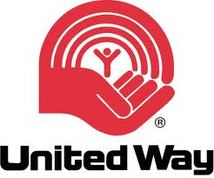 It was a time of reinvention and change for the United Way on both the national and local levels, as it entered into the new millennium. In 2000, many local chapters embarked on implementing a national brand management strategy designed to differentiate the United Way brand, and the larger system model. The strategy helped to reposition United Way as more than a "fundraiser," but instead, one of the country's leading "community impact" organization. The goal sought after was the emergence of a community-based worldwide movement. To do so, United Way organizations across the planet would bring together financial resources, volunteers, human service agencies and community partners to make the greatest impact. This was a fledgling idea at the time, but today the United Way system constitutes approximately 1,800 community-based United Way organizations. Each is independent like United Way of Frederick County, and separately incorporated and governed by a local volunteer board of directors. These organizations address the most critical issues and mobilize resources beyond pledged funds through annual campaigns and other fund-raising efforts.  Through a “united” nationwide effort, United Way and its partners, the Alliance of Information and Referral Systems, successfully petitioned the Federal Communications Commission to designate "211" for health and human services information and referral. Originally created by United Way of Atlanta, 211 is an easy-to-remember and universally recognizable telephone number that makes a critical connection between individuals and families in need and the appropriate community-based organizations and government agencies. As far as the United Way of Frederick County was concerned, the seventh decade of the united giving model would fast re-affirm the great need for the organization here, while challenging local leaders to re-evaluate whether we are prepared for the worst, or doing our best for the community with monies annually raised. At the helm of the local organization in 1999 was Dr. Ann L. Boyd, a biology teacher at Hood College. Dr. Boyd also held the distinction of being the third female to serve in the position of United Way's president. She would also be the last to hold the title, male or female, as a title change was on the horizon. Dr. Boyd was assisted by campaign chairman Peter Plamondon, Jr. of Roy Rogers Industries. Plamondon would take the reins the following year as Chairman of the Board (2000), the position formerly referred to as president. He was assisted by campaign chairman Charles C. Clark, executive director of Buckingham’s Choice Retirement Community. Frederick County’s population was 190,000 in 2000, and ironically, 190 local companies, corporations and organizations were involved that year in helping 24 partner agencies through a campaign goal set at $2 million. ($1,468,850 was raised). In March 2001, Michael Singer was hired to fill the executive director position which had been vacated by Susie Loveland a year before. Former Executive Director Nancy Crum (1989-1996) had been coaxed out of retirement to serve as interim director while the Board searched for a suitable replacement. Singer, formerly the vice president of development for the United Way of Greater Chattanooga (Tennessee), brought 11 years of non-profit experience to the position. Job duties were tweaked a bit and a new title came about as Singer would become the president and chief executive officer of the UWFC. A new marketing theme was rolled out with help from local advertising firm Ann Burnside, Love and Associates. Residents were asked to consider their United Way participation as a multivitamin for the community—one that supplies the nutrients for the survival of several local non-profit organizations. 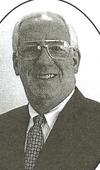 Charlie G. Clark Charlie G. Clark The Calm Before the Storm The 2001 campaign kicked off on Friday, September 7th with a goal of $1.6 million. Just four short days later, the world, as we knew it, changed forever with the deadliest attack ever experienced on United States soil. Terrorists hijacked jet airliners and flew them into New York’s World Trade Center, and the Pentagon in Washington, DC. Thus began “The War on Terror.” The United Way of Frederick County responded by taking part in a new fund called The September 11th Fund, coordinated by the United Way of New York City. This was a national effort to raise money for people affected by the disaster in all parts of the United States. UWFC Chairman Charles G. Clark wrote a local letter to the editor that explained the fund, and reaffirmed the United Way’s role in helping to help provide emergency services through funding member agencies. In this case, two were at the forefront of the recovery efforts—the American Red Cross and the Salvation Army. Nationwide, a renewed sense of charity was awakened by this horrific event and the warfare to follow, harkening back to the World War eras. Cooperative efforts eventually sparked federated giving in Frederick back in 1938 with the introduction of the Community Chest. As America moved forward from September 11th, 2001, additional tragic events would occur three and four years later in the form of natural forces. These included a series of devastating hurricanes in Florida in late summer/fall of 2004, and 2005 brought the legendary Hurricanes Wilma and Katrina. Frederick was spared, but thanks to advancements in media technology including the internet, UWFC leadership members, campaign volunteers and donors had a front row seat to watch events play out at real time. Many received the wake-up call of “What if this had happened here in our community?” Well aware of this fact were UWFC chairmen serving during the early 2000s. These men were executives in the financial world: CPA Daniel W. Chaney of RSM McGladrey (2002), CPA Robert L. Tuggle of Willard Automotive Group(2003) and Senior VP Frederick S. Genau of Farmers & Mechanics Bank (2004).  The United Way throughout Florida led the response and recovery efforts by identifying the most serious needs in devastated communities. The Florida 2-1-1 Network responded to thousands of telephone calls directing victims to services such as disaster preparedness, shelters, food and water assistance, response activities, post disaster assistance, and recovery information. Local 2-1-1 operators also matched volunteers with opportunities to give help in affected communities. In 2005, the United Way of America updated its Standards of Excellence. First adopted in 1973 and last updated in 1988, the Standards—which provide a comprehensive description of benchmark standards and best practices—reflect the organization’s strategic shift from its traditional role as fundraiser to the new mission focus of identifying and addressing the long-term needs of communities. In his “end of year report,” 2004 UWFC Campaign Chair Theodore M. "Ted" Luck (Frederick County Public Schools) said:  Ted Luck Ted Luck “Disasters don’t just happen to other people in faraway places. We have “everyday disasters” right here at home that affect your friends, your neighbors—maybe even your family. Through the 2004 UWFC Campaign, together we were able to raise $1,531,050 to ensure that basic, local services will be there for all of us—whenever we need them.” Luck's words of wisdom rang true throughout his presidential year of 2005. Over 46,000 residents, from children to seniors, were provided critical resources through United Way’s support of local organizations capable of providing emergency assistance programs such as crisis hotlines, disaster relief, counseling and shelter from abuse and homelessness. A Re-Focus on Mission In 2005-2006, time, energy and resources were invested to impact the Frederick community by continuing to focus on four distinct areas through its 22 partner agencies: 1.)Support programs that assist children and families 2.)Provide emergency services 3.)Offer health education 4.)Serve those with disabilities In the 2005 campaign, the UWFC raised $1.5 million under Board Chairman Ted Luck and Campaign Chair Eric Struntz (VP Bank of America). One year later, the annual appeal would raise $1.7 million under Struntz’ leadership. Michael Singer departed the organization and in May 2007. Board Chairman Eric Struntz took on an even greater role to help the organization during a time of transition. Reflecting back on this period, Struntz said: “The agency went through a fair amount of executive turnover during one phase of my board tenure. In particular, the year that I was board president we were without a CEO for 9 months or so, and I informally doubled as the “interim” CEO. I thought I knew a fair amount about the agency’s operations, but I had no idea all of the “in’s and out’s” until I experienced it firsthand. Fortunately the staff was fantastic, and they were the ones that fully kept things afloat.”  Bill Kantz, the new President and CEO of the United Way of Frederick County Bill Kantz, the new President and CEO of the United Way of Frederick County A gentleman named Bill Kantz would become the new president and chief executive officer at United Way of Frederick County. Kantz recently moved back to the continental United States from the U.S. Virgin Islands armed with 12 years of United Way experience. He previously served as the CEO for United Way organizations stateside as well in Waterloo, Iowa, Danville, Va., and Washington, D.C. In a newspaper article introducing the new United Way administrator to the Frederick community, Kantz spoke of the challenges many traditional charitable organizations were facing at the time. He noted competition for donations had increased because the number of nonprofit organizations seeking them has grown tremendously. “United Way organizations have to appeal to a wider scope of donors,” Kantz said. “The average donor is older than 40, but donors need to reflect community demographics. So do volunteers. Volunteers at many well-known organizations usually are older white males, he said, but it is important that traditional charities be relevant to a diverse group. People need to not just view United Way as a fundraising organization, but see how it is a great way to invest in their community.”  The 70th anniversary of the UWFC was upcoming in spring 2008. An unwelcome guest was a severe global financial crisis. The economic growth of the 2000s had considerable social, environmental and mass extinction consequences including a heightened demand for diminishing energy resources. The period from 2007-2008 is considered by many economists to have been the worst financial crisis since the Great Depression of the 1930s. Board leadership through this tough time was appropriate in the form of chairpersons Frederick L. Ridgeway, Jr. (an investor with Smith-Barney) and Jayne Bongard (VP with M&T Bank).  Under President Bill Kantz, and a re-invigorated Board of Directors, the revamped mission of the UWFC had never echoed louder: “To unite local resources in an effort to provide the most effective response to community issues in Frederick County.” Meanwhile, the organization’s Vision statement was “To build a community where everyone has the aspirations, resources and opportunities to reach their potential.” The major ideological change featured a shift from simply allocating funds for member agencies to looking at community impact and identifying specific areas of need and monetary distribution to those that could best address these needs. This controversial move certainly wasn’t without pain as some agencies, who had grown dependent on the United Way of Frederick County, lost their major funding streams. The Community Impact funding model had been initiated through United Way of America in the mid-2000s. Although the preliminary planning started under Mike Singer, Bill Kantz had the opportunity to introduce this concept to Frederick County. Described as “a high paced, energetic guy with a get things done personality,” Kantz had witnessed the power of focused charitable resource allocation during his time working for United Way in the Caribbean. The caring power of communities was being harnessed and mobilized to do greater good. United Way organizations now had the power to bring communities together in an effort to focus on the most important health and social service needs by building partnerships and leveraging resources to make a measurable difference. Focus areas were being identified at the local level and varied from place to place. With United Way Worldwide in place, a movement was now in motion to make a measurable impact on the global community as well. United Way Worldwide continues to invest in the programs and services that strengthen the ability of local United Way organizations to identify and build a coalition around a set of community priorities and measure success based on community impact. 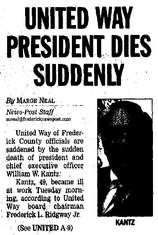 Frederick News-Post (Feb 20, 2008) Frederick News-Post (Feb 20, 2008) Bill Kantz had an major task to deliver upon. It would be achieved, but sadly, the UWFC president and CEO would not live to see his vision come to fruition. Kantz died suddenly on the morning of February 19th, 2008. Shortly after coming into the office for a regular workday. He collapsed and was taken to nearby Frederick Memorial Hospital and died shortly thereafter. He was only 49 years-old. His premature death shocked grief-stricken colleagues. Board Chairman Fred Ridgeway was interviewed by the Frederick News-Post later in the day, saying: “He brought a lot of energy to us. He was getting a lot of things done for us.”  Eric J. Struntz Eric J. Struntz Former Chairperson and interim president Eric J. Struntz was quite active in helping the organization make this phenomenal change. He reflected: "The work to transition from an allocations/designations model to a “community impact” model began under Mike Singer, and each subsequent CEO helped further the cause of bringing the agency to where it is today. In many ways the overall premise remains the same – United Way raises money on behalf of non-profit agencies in Frederick County, and pools those dollars together to help make a bigger impact than would have happened otherwise. However, as donors now have more and more options of who and how to give, the competition for those “dollars” is greater, and accountability for the impact the funds are having is of even higher importance. In my view, the shift to a Community Impact model was essential to the survivability of UWFC." At this juncture, a former Frederick County delegate to the Maryland General Assembly, Rick Weldon, would step in as UWFC CEO/President. He picked up the community impact torch and moved forward in the direction that his predecessor had mapped out. Looking back, he would add: “I’d be dishonest if I suggested the transition from a “council of community partners” to the community impact model was easy, though. It was challenging to “sell” nonprofit CEO’s, who had grown accustomed to a dependable annual allocation of resources, to the idea of targeted grants in the areas chosen by UWFC as community priorities. To their credit, all of them have adapted their expectations, and our visionary UFWC leaders have proven the value of the community impact model to help us address our most pressing problems in the areas of income, education and health.” Eric Struntz added: “Notwithstanding the above change, continuing to have key relationships with a core group of agencies/partners remained critically important. When UWFC first started to move towards this newer operating model, there was a fair amount of trepidation amongst the agencies that UWFC had traditionally partnered with. The transition involved a significant amount of communication amongst all stakeholders, and I’d like to think that each of the CEOs at the time did a great job of helping to educate the community on the changes that were being made. And it’s important to note, most of the agencies that UWFC partners with today are decades long partners who we have worked with for many, many years. Sudden Community Impact One of the finest innovative ideas of the period involved a new partnership between the United Way of Frederick County and one of its greatest workplace campaign partners—Frederick County Public Schools. Entitled “Stuff the Bus,” this activity involved volunteers and participating donors actually filling a school bus with much-needed school supplies. The inaugural event occurred September 11th, 2009. Related educational-oriented initiatives to aid school children in succeeding in school soon followed. These included a collaborative effort with Frederick Community College involving a poverty simulation, and a community-wide backpack drive.  Josh Pedersen Josh Pedersen Construction Law Attorney David C. Weaver and M&T Bank VP Keith Grunow would follow Eric Struntz and Jayne Bongard as board chairpersons. All four individuals would play a role in having to hire yet another CEO/President after Rick Weldon left the organization after being offered an opportunity with the Mayor’s Office of the City of Frederick. In early 2010, the Board offered the position to a native from Utah named Josh Pedersen. Pedersen was an appealing candidate for the job because of a proven track record in the “community impact” arena. Once in place here in Frederick, he told an FNP reporter: “The United Way is no longer a fundraising organization. It has become a community change organization. We are not just looking at production outputs, but we’re looking at the long term impact on our community.” Pedersen had great prior experience in the non-profit world and had experience with United Way organization to boot. The Frederick Chapter now focused on helping people in three major areas in its work: education, health care and financial stability. Josh Pedersen would nurture the community impact model over the next 6 years before his departure in March 2016 to take a position at the nonprofit 2-1-1 Maryland Inc. The midpoint of Pedersen’s tenure marked the 75th anniversary of the organization in April, 2013. By this time, a Community Impact Grants and community Needs Grants programs had been instituted. Several programs were started to address the root causes of academic achievement, financial stability and healthy lives. These included: Born Learning, FamilyWize, Prescription Discount, One Million Mentors, Student United Way, and United Way Summer Serve. 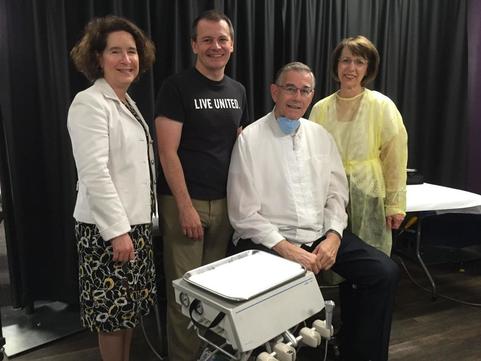 Pedersen found that “one of the coolest things” about working in the Frederick County community was “people’s commitment to solve problems and willingness to make a difference." “It’s not about one donor or one nonprofit or one person,” he said. “It’s all of us united, coming together to solve a problem.” A huge accomplishment for the organization during Petersen’s tenure as CEO was the effort to help working families become more financially stable. Board member Eric Struntz said, “While the organization provides assistance for immediate needs, United Way has also aimed to 'not just put a Band-Aid on the problem,' but also help families reach economic independence. There’s a balance required between helping to meet immediate financial needs, and helping to fix the underlying problems so that those needs don’t happen to begin with. While both are important, “helping families become financially stable and independent” in my view is most critical. As a donor, I would rather give money to fix problems than provide “band aid” solutions, so focusing efforts on the underlying causes of social issues is incredibly important."  Pedersen, his board, sponsors and volunteers were very successful in building partnerships with different nonprofits, while maintaining existing relationships. This was an important part of the organization’s work during his tenure. United Way of Frederick County recognized that issues are better tackled with the power of multiple groups. This was so important as the community continued to grow. In 2012, the UWFC annual report showed that $126,711 was invested in the area of Education, in which 1,936 persons were served. This ranged from funding put toward youth mentoring and afterschool opportunities to family coaching and Stuff the Bus. In respect to the second pillar of Income, UWFC provided an investment of $73,895 to promote financial stability and independence. This served 1,108 people receiving help through programs such as Information and Referral Services, Neighborhood Revitalization, Homebuyers Education, Financial Literacy and Income Volunteer Training. The third main focus are is Health, and partners ranging from Gale Recovery, Families Plus, Mission of Mercy, Frederick County Hepatitis Clinic and Villa Maria received a total investment of $69,300 in which 1,245 persons were served. Josh Petersen and his Board of Directors also learned a valuable lesson relating to a decrease in workplace giving by leading companies. This was not going to be sufficient to meet fundraising needs. A crippling commercial recession in the rear view mirror, Frederick based companies and businesses are more transient than ever before. Eric Struntz reflects: “We already started to see pullback of some of the larger companies in the area. CitiMortgage, Chase, Bechtel and a number of others had all significantly reduced their presence in Frederick County. The county became much more “commuter-based” as well, which made reaching those folks even more of a challenge. And with those changes, it became tougher to target individual donors for gifts. So work began to increase foundation giving, corporate sponsorship, large individual gifts, etc. as a way to help offset workplace turnover. While employee giving still remains an important component of the overall fundraising effort, the recognition of a need to diversify funding sources was very important”. Jeffrey K. Fraley (1st Vice-Chair-M&T Bank) led the local chapter as Chairman of the Board from mid 2012-mid 2013. He was followed by Jim Racheff (CEO-Data Management Services, Inc.), who would serve two consecutive terms. Under Racheff, The United Way of Frederick County experienced another major milestone. This was the 75th anniversary of "united giving" here in Frederick County. This monumental achievement came on the heels of another as Forbes Magazine ranked United Way as one of the most efficient charities in the nation, calling the non-profit and "all-star charity." United Way of Frederick County had certainly lived up to this all-star billing. Since the inaugural campaign drive of May, 1938, UWFC had raised more than 44,000,000 over its 75-year history. Best of all, all $44,000,000 was invested in programs and services here in Frederick County.  Out of that goal came the Prosperity Center which opened in 2014. This collaborative effort with the Frederick Housing Authority and the Frederick County Financial Literacy Coalition moved the offices of the United Way of Frederick County from their longtime home in the Federated Charities Building on S. Market Street to the 600 block of N. Market Street, within the Bernard W. Brown Community Center. The joint initiative was designed to help provide resources for the “working poor” of Frederick County, estimated at 16,000. Here, residents can find services such as getting their tax returns done free of charge, credit counseling, asset building tools and budget coaching.  Ken Oldham Ken Oldham Who is this Alice? Evolution of staff throughout the years has been important as well. Traditionally staffing requirements focused on fundraising, finance, and administration. Today, those roles remain critical, but have also expanded to include focus on both community impact and community engagement. On August 1st, 2016, Ken Oldham took over as CEO and President of United Way of Frederick County. Boasting an extensive background in non-profit management, strategic planning, and community outreach, he came to Frederick after serving for over a decade as President of the National Philharmonic at Strathmore in Bethesda, Maryland. In addition, Oldham has several years of experience in helping to develop non-profit organizations. He is a Certified Fund Raising Executive (CFRE) and a current member of Western Maryland’s Chapter of the Association of Fundraising Professionals. In recognition of his professional excellence, he received the prestigious Alumni Achievement Award and the Montgomery County Executive’s Emerging Leader Award. Ken earned his Bachelor of Science from Frostburg State University, where he serves as Vice President of the FSU Foundation and Chair of the Governance Committee.  Malcolm Furgol Malcolm Furgol A native of Scotland, Malcolm Furgol is the UWFC's Director of Community Impact. He is responsible for the development and execution of strategies related to the long-term community impact goals of the organization, focusing on education, financial stability, and health. He has been part of the organization since December 2013 and is also in charge of planning and implementing our signature United Way activities Furgol served as Membership & Information Manager at The Nonprofit Roundtable of Greater Washington and as Board Chair for the Young Nonprofit Professionals Network of DC (YNPNdc).  Board Chairs Vasquez (left), Stenersen (2nd from left), and Sears (right) with CEO Oldham Board Chairs Vasquez (left), Stenersen (2nd from left), and Sears (right) with CEO Oldham The Annual Leadership Breakfast in fall continues to put the campaign drives in motion, and springtime brings recognition to leading community volunteers and organizations supporting the United Way through the Bravo! Awards event. Roger Stenersen (Director of Hood College's Educational Leadership program)served two terms as UWFC's Board Chairman (mid 2014-mid 2016) and was followed by James Sears (President of Maryland Operations-First Energy Corporation) and Danny Vasquez (GM-Plamondon Hospitality Partners).
At this important milestone, it’s so important to see what the Frederick County Chamber of Commerce thinks about the organization—one it formed back in 1938. As a catalyst for enhancing the economic vibrancy of the Frederick community, the Chamber has provided the UWFC team with tools to be better professionals through a large spectrum of training opportunities. Fine workers and keen Board members usually can have skills sharpened at the Chamber, not to mention the leadership programs offered. Additionally, the Chamber links UWFC with similar organizations so networking and problem-solving even between peers can become more commonplace.  UWFC CEO Trio featuring Ken Oldham (left), Rick Weldon (center) and Josh Pedersen (right) UWFC CEO Trio featuring Ken Oldham (left), Rick Weldon (center) and Josh Pedersen (right) Rick Weldon, a Delaware native, first came to Frederick in 1985 and has been involved with the United Way of Frederick County as a donor, volunteer and served as President and CEO from 2008-2009. Today, Weldon serves as Vice-President of the Frederick County Chamber of Commerce and shares a unique perspective on the UWFC’s impact back on the Chamber, itself—the organization responsible for its establishment here in Frederick back in 1938:Rick Weldon, a Delaware native, first came to Frederick in 1985 and has been involved with the United Way of Frederick County as a donor, volunteer and served as President and CEO from 2008-2009. Today, Weldon serves as Vice-President of the Frederick County Chamber of Commerce and shares a unique perspective on the UWFC’s impact back on the Chamber, itself—the organization responsible for its establishment here in Frederick back in 1938: From its earliest days, UWFC has played an important and lasting role as a part of the Chamber of Commerce. We’ve always had a strong presence of UWFC board members and volunteers also serving on Chamber boards and committees, and they share their concerns and accomplishments with their colleagues in the private sector. The Chamber provides space and support for the Frederick Nonprofit Alliance, a group comprised of CEO’s from many of our leading nonprofit organizations. They share best practices, experiences and resources, all under the umbrella of the Frederick County Chamber. It’s something we’re very proud of! United Way of Frederick County is a powerful representation of the generosity of the people of Frederick County. The ability to focus resources on our most pressing challenges and in support of our most vulnerable populations has always been UWFC’s strength. That was the basis for the original Community Chest investment fund, and continues today as the underlying mission of UWFC. When called, our community always seems to answer! Happy 80th United Way of Frederick County! "The first forty years of life give us the text: the next thirty supply the commentary." These were the words of 19th century German philosopher Arthur Schopenhauer. United Way of Frederick County celebrated its 40th milestone in 1978. It was a decided time where the past growth and daily life of the organization over four decades could now be reflected upon, and measured for true meaning. The time and efforts of hundreds, if not thousands, of board members, volunteers and donors had provided a manual and road map—one to be used to help chart out direction for the next 40 years.  In 1979, local dentist Robert Broadrup served as Board President of United Way of Frederick County to close out the decade of the 1970s. Fittingly, most Americans would begin to have teeth clinched, beginning in November of 1979, in response to the Iran hostage crisis. This was a diplomatic standoff between Iran and the United States in which 52 American diplomats and citizens would be held hostage for 444 days from November 4th, 1979, to January 20th, 1981. These hostages were taken by a radical group of Iranian students who stormed the US embassy in Tehran. The US hostage crisis stands as the longest of its kind in recorded history, and had serious consequences on the presidency of Jimmy Carter, and his eventual defeat for a second term to Republican challenger, Ronald Reagan. A galvanized US, full of national pride, was another result as the country came together in their support of fellow citizens. Yellow ribbons became a popular icon of the time, primarily symbolizing the resolve of the American people to win the hostages' safe release. Campaigns were led to "Tie A Yellow Ribbon" around public trees as well as encouraging people to wear tied ribbons on lapels.  President Ronald W. Reagan President Ronald W. Reagan When President Reagan took office, major changes and cuts were made to federal spending, especially in relation to government-funded social programs and needs. In a televised address in late September 1981, the president called for “new, imaginative” partnerships between local governments and voluntary organizations to help meet the nation’s human care needs. This message was greeted by great enthusiasm by staff and volunteer leaders of Frederick County's United Way. During the president’s five-minute message, Reagan emphasized voluntary organizations such as the United Way to be “the core” of our social welfare system. He asked “all individuals of every income level” and “all corporations of every size” to give more generously than ever to that fall’s United Way campaign. Reagan said: ”People who give to help others want to know the greatest part of their charitable gift actually goes to those who need help. That’s true of the United Way.” The president described himself as a “fellow volunteer,” following in the presidential tradition of delivering a special United Way message to the nation, something that began in 1927 with Calvin Coolidge’s national radio broadcast. Against this backdrop, UWFC Executive Director Jean Laws worked hard to keep attention on member non-profits and the work they continued to do for the local community. These included: the American Red Cross, Arthritis Foundation, Big Brothers & Big Sisters, FSK Boy Scouts of America, Counseling Services, Epilepsy Chapter, Federated Charities, Frederick Community Center, Frederick County Association for Retarded Citizens, Girl Scouts, Goodwill Industries, Mental Health Association, Learning Tree, Inc., Salvation Army, Seton Center and the YMCA. Nine more organizations would be added over the next few years: Community Living, Catholic Charities, Battered Spouses of Frederick County, Group Homes, Inc., Frederick Telecom Association, Gale House Inc., Jericho II (group home for boys), Frederick County Hotline, and Information and Referral Services.  Frederick News (Sept. 27, 1980) Frederick News (Sept. 27, 1980) The campaign of 1978 raised $328,500, $4,500 over the initial goal. Mrs. Laws and Dr. Broadrup were aided by the first-ever female chairperson in the 1979 campaign. This was Kathryn “Kitty” Reed of the Frederick Citizens Savings & Loan. Ms. Reed was fresh off serving two terms as president of the Frederick Chamber of Commerce. The tandem brought in $381,143 in 1979. Kitty Reed would take over from Broadrup as Board president the following year, representing the first woman to do so in the organization’s history. She elaborated on the "football" kickoff theme from 1978 by bringing in a true kicker from the local, semi-professional football team known as the Frederick Falcons. A tally of $424,604 would be brought in for 1980's annual campaign, and $440,528 would follow in 1981. Two other folks served in leadership roles at the start of the decade—Jack F. Mason (Manager of Frederick Gas Company) and James F. Reilly (Underwriting Superintendent for State Farm Insurance). In August 1982, Jean Laws made the difficult decision to retire after 10 years at the helm. Her husband had been offered a job allowing the couple to return to Salisbury, and family and friends there. During her tenure, member agencies grew from 10 to 25. The budget grew from just over $200,000 to the near-half a million, the amount budgeted for the 1983 Appeal being $490,000. Laws’ last campaign (the previous fall) attained $445,000, the largest amount the organization had ever experienced, even though there had been an ambitious goal of $480,000. In Mrs. Laws’ defense, a current economic recession and a multitude of cutbacks by the federal government were prime factors for the UWFC falling short of their mark—the financial climate was the most difficult since the Great Depression era of the 1930’s. To Jean Laws’ credit, the previous four United Way campaigns surpassed projected goals, thus providing agencies with 100% funding—a fine legacy to go with her departure. In an interview appearing in the August 12th, 1982 Frederick News-Post, Mrs. Laws said: “I have found Frederick Countians are not only to me very friendly people, but that they will come through with donations every time.” In the article, Jean Laws was praised by former United Way presidents Lawrence A. “Tommy” Dorsey, Jr. along with Jack Mason, Robert L. Snyder, and Pat Dean (former director of the American Red Cross). Mr. Dorsey said of Laws: “She works so well with volunteers, and as hard as the volunteers. She knows how to direct, she is a director if there ever was one. She is very much interested in the Frederick County community…has the faculty for remembering the small, important details about people…a lot of charisma.” Jean Laws went on to say: ”It’s the hundreds of volunteers who work together to make it all possible and worthwhile. The volunteers who give so much of themselves to help others are just wonderful people. Working together has been, and always will be, the basis of success. In working well with each other in complete harmony, the United Way idea will succeed,” Mrs. Laws explained. “Of course it's the little things that have made it a rewarding job. The bottom line is people helping people. United Way has helped a lot of people and that’s the important key. If you can do that, in the bad times as well as the good, then you know you have done a good job. This has been one of the best experiences in my life—the United Way and Frederick—specifically the people of Frederick.” Dorothy Jean Laws left Frederick, but would continue using her talents as she served for many years as a consultant to United Way groups on the Eastern Shore. Now the 1983 campaign had to "kick-off" without its seasoned leader, and amidst the continued recession complete with a time of high unemployment. However, these were conditions that the United Way and its forerunners (UGF and Community Chest) were originally built to withstand. The Reagan Years The 1980s decade was one of roller-coaster like, socioeconomic change due to advances in technology and a worldwide move away from planned economies and towards laissez-faire capitalism. Many economists at the very least agree that the changing global economic trends of the 1980s can be somewhat attributed to the "Reagan Boom", which, in the 1980s was a record setting era that eventually produced more jobs and more economic expansion than any other time in U.S. history. As economic liberalization increased in the developed world, several multi-national manufacturing corporations relocated to countries such as Thailand, Mexico, South Korea, Taiwan, and China. The final decade of the Cold War opened with the US-Soviet confrontation continuing largely without any interruption. Superpower tensions escalated rapidly as President Reagan adopted a much more aggressive stance on the Soviet Union. The world came very close to nuclear war for the first time since the Cuban Missile Crisis of 1962, but the second half of the decade would see a dramatic easing of superpower tensions and ultimately the total collapse of Soviet communism. The fall of the USSR made conservative economic policy more popular both home and abroad. The United Way model was working here in Frederick County, and had been for well over four decades. This was an interesting case study based on Frederick’s economic situation from a historic perspective. Frederick was, and had always been, a conservative, agricultural community. It was one devoid of large industry like Baltimore to the east, and Hagerstown to the west. The major United Way success stories around the country occurred in places of high business and industrial activity. Campaigns that could tap into companies with large employee pools were generally more successful than not. For years, Frederick’s biggest employers were businesses including the Union Knitting Mills, the Ox-Fibre Brush Company, M. J. Grove Lime Company and the Everedy Company. Banks were a constant, as were schools, but white-collar jobs would not expand here until the growth of emtities such as Fort Detrick and Frederick Memorial Hospital.
 Frederick News (Sept 7, 1982) Frederick News (Sept 7, 1982) Earl Robbins would find himself in the role of president in late summer of 1982. He was assisted by banker Richard C. Marshall III (1st VP Maryland National Bank). The third piece of the top leadership team involved a replacement to fill the big shoes left by Jean Laws with just weeks before the ensuing campaign drive. Joyce Cramer, the new, executive director hire, was a hometown girl who had plenty of experience with the non-profit group, having spent the previous 11 years with Central Maryland United Way. The Frederick High School and Hood College alumnus had helped manage campaigns in many neighboring Maryland counties and Baltimore City. A newspaper article from September 1983 reported: “this year the organization is taking a more determined direction on fundraising methods to make the county’s campaign the most successful one ever.” One of the plans the United Way developed in an effort to bring the community campaign into line with the agencies’ actual needs is “campaign potential,” an idea developed by Cramer. The plan includes a study comparing the Frederick County community to others across the nation, similar in size and nature, to estimate how far this area would need to increase to meet the national campaign average.  When the proverbial smoke cleared in early 1984, it was determined that the 1983 campaign raised $552,254. The new leadership team of Robbins, Marshall and Cramer had done it, of course with the help of determined volunteers and countless others. At a banquet in February, 1984, Robbins commented: “The practice of neighbor helping neighbor has been rekindled in Frederick County. The enthusiasm and success generated in the 1983 campaign has been heartwarming. God bless all the givers in Frederick County.” A year later, the goal was increased by 45% to $800,000. The rationale rested in the belief that the campaign should raise the true total needed for budgets by the 26 partner agencies under the United Way umbrella. The campaign fell short of its intended goal by raising only $700,000. However, this was still nearly $150,000 in additional funds raised than the previous year.  Frederick News (Sept 3, 1985) Frederick News (Sept 3, 1985) Our United Way Celebrity The 1985 campaign included another increase of the desired drive goal to $962,000 for the purpose of covering 22 local agencies. The official kick-off of the campaign included a varied entertainment bill at the Weinberg Center for the Arts. WFMD’s Tommy Grunwell served as emcee on a night that included country music performed by Don Barnes and Debbie Williams, organ selections by Richard Kline, and the showing of two films produced by the United Way. Several hundred people turned out to honor a very special guest, Julie Bartee, a Brunswick resident who was the national spokesperson for the United Way. Miss Bartee was also a senior at Maryland School for the Deaf. She had originally played a role in the United Way’s documentary film “You Don’t Do It, It Won’t Get Done,” produced in 1971. At the time, Julie was two years-old and living with her family in Nashville, Tennessee. The film showed how Julie’s parents, Robert and Gina Bartee, received help in diagnosing their daughter’s deafness through the Bill Wilkerson Hearing and Speech Center, an agency funded by the United Way. Country music legend Loretta Lynn helped tell the story. After receiving help, the Bartee family was urged to move to Frederick County to be near the Maryland School for the Deaf. Earlier in the year (1985), Loretta Lynn was called on to take part in a new film entitled “Memories,” in which Julie Bartee’s story was revisited 14 years later, sharing Julie’s academic success, and athletic prowess as an-award-winning track and field competitor who set several national records. Future United Way president, and current MSD Superintendent, Dr. David M. Denton introduced Miss Bartee as “a special person who strived to do her best.” Julie would give a speech in sign language retorting, “United Way was there when I needed their support.” She would continue to travel the country as an ambassador for the United Way during her year as spokesperson. The "hometown girl's" rise to prominence would have a very positive effect on elevating the message of the local organization. The following February of 1986, the entire Bartee family was lauded by the United Way of Frederick with the Volunteer of the Year award. Tommy Grunwell was also given special recognition for his generous help with the fund drive which netted $816,817. The goal would be raised to top the million-dollar mark a year later.  By the mid-80s, developing countries across the world faced economic and social difficulties as they suffered from multiple debt crises requiring many (of these countries) to apply for financial assistance from the International Monetary Fund (IMF) and the World Bank. Ethiopia witnessed widespread famine in the mid-1980s due to corrupt rulers, resulting in the country's dependence on foreign aid to provide food to its population, along with worldwide efforts to address and raise money such as the Live Aid Concert in 1985. Pop music had done some “out of the box” fundraising of its own, inspiring new ideas and avenues for addressing needs. From a global health perspective, The AIDS epidemic had become recognized as a killer of millions. Over the next three decades it would be responsible for taking the lives of nearly 40 million people.  In the 1980s, some of the momentum of education reform moved from the left to the right, with the release of “A Nation at Risk,” Ronald Reagan's efforts to reduce or eliminate the United States Department of Education. In the latter half of the decade, E. D. Hirsch put forth an influential attack on one or more versions of progressive education, advocating an emphasis on "cultural literacy"—the facts, phrases, and texts that Hirsch asserted every American had once known and that now only some knew, but was still essential for decoding basic texts and maintaining communication. After high tension for most of a decade, 1988 marked much improved relations between the US and Soviet Union. A decade that began with US residents getting to watch a miraculous ice hockey victory over the Russians in the 1980 Winter Olympics, now was coming to a close with images of the infamous Berlin Wall being toppled.  Digital technological advances ushered in the era of compact discs and digital video discs (dvds), changing entertainment delivery and quality for the better. Cable television was providing expansive offerings in entertainment, sports and news options. The global Internet had taken shape in academic settings such as college campuses by the second half of the 1980s, as well as many other computer networks of both academic and commercial use. By 1989, the Internet and the networks linked to it were a global system—quickly leading to the World Wide Web created by Sir Tim Berners-Lee. The latter half of the decade saw additional gifted community leaders guiding United Way of Frederick County and the annual appeals. State Farm's Deputy Regional VP Charles L. Snyder served as president in 1985 and was followed by Robert E. Clark, president of John Hanson Savings (1986). James D. Latimer, eastern division manager for Potomac Edison, headed the UWFC in 1987 and David M. Denton, Superintendent of the Maryland School for the Deaf, took charge in 1988. Under Denton's presidency, two more partner agencies joined the United Way—The American Cancer Society, and DILA (Deaf Independent Living Association). Going for Gold 1988 marked a very special year for the United Way of Frederick County as it was a landmark anniversary in which the organization would celebrate its 50th. Going back to 1938 and the Community Chest, special brochures and posters had been produced by volunteers for each annual campaign. This commemorative year was no different as Charlene Hennessy of IronGate Graphics designed the theme and poster for 1988 entitled "Going for Gold." The poster depicted the spirit of the Olympic Games with marathon runners moving ahead with the strength and determination to make the finish line. A lofty goal of $1,800,00 was set for this hallmark year. This was considerably larger than the previous year's (1987) projected intake of $1,177,476 (of which only $952, 850 was collected). A special kickoff breakfast was held on September 16th at the FSK Holiday Inn Frederick. Immediately following breakfast, a celebratory motorcade had been arranged which took participants northward from the hotel (located just off MD85/Buckeystown Pike) to Downtown Frederick via Market Street. The grand marshal for the event was Frances Randall, part owner of the Frederick News-Post and niece of the Frederick Community Chest's inaugural 2nd VP, William T. Delaplaine. Mrs. Randall had served as a longtime guiding light for the Girl Scouts of Frederick, a charter partner-agency with the organization dating to 1938. The motorcade ended at the Big Brothers/Big Sisters office on N. Market Street, located within the Odd Fellows Home. Along the route, representatives from all 20 agencies of the UWFC waved banners, flew balloons and cheered on the vehicles with a chant of "Go for Gold!" The 1988 anniversary campaign brought in $1,238,00. This was only 69% of the desired goal, however, it was a $286,000 improvement on 1987's sum and the first time in Frederick history that the annual appeal would break the "million-dollar mark." After the excitement of the anniversary year waned, another major transition would beset the United Way's Frederick Chapter. Executive Director Joyce Cramer retired in June, 1989. Over her seven-year tenure, the number of volunteers had jumped from 200-500. Annual contributions followed suit going from $350,000 to over $1,200,000. The departure of Mrs. Cramer opened the door for a new executive director in the person of Nancy Crum. Crum formerly held the position of assistant director of the UWFC, and was a natural choice to serve as acting executive director in Cramer’s absence. She would soon become executive director and hold the post for five years. A group of doctors in education helped lead the United Way of Frederick County from the mid 1980’s into the 1990’s. These included the fore mentioned Dr. David Denton (Maryland School for the Deaf) and Dr. John George (Frederick County Public School teacher and elementary history curriculum head) and Dr. Michael Cohen (former principal of Lewistown Elementary). The educational and communicative talents of these gentlemen would certainly be put to the test at the start of the next decade as unforeseen trouble was brewing. The National Scandal Michael Cohen was serving as United Way of Frederick County president in February, 1992 amidst a grim economy. To add insult to injury, this was also the same period that a national media story surfaced involving impropriety and financial mismanagement within the national United Way organization. The scandal was focused on William Aramony, CEO of the national United Way for over 20 years. The story was broke by investigative columnist Jack Anderson. Aramony would retire in 1992 amid allegations of fraud and financial mismanagement, of which he was subsequently convicted. He was sentenced to seven years in prison and fined $300,000. While many United Way chapters throughout the country scrambled to combat “guilt by association,” United Way of Frederick County was able to stand confident and “educate” the community about its own track record, fiduciary practices and the integrity of its leadership and general membership of volunteers from throughout the county. UWFC members wanted the masses and, most importantly, campaign contributors to understand that their local campaign donations stayed local, and had been properly appropriated to local agency partners. Board President Michael Cohen, a native of Brooklyn, NY had come to Frederick in 1976 and worked as a supervisor of elementary schools. He had also formerly served as director of the Frederick March of Dimes and as a Board member of the ARC of Frederick County. He addressed the many concerns raised with a heartfelt and poignant commentary in the Frederick News-Post dated February 26th, 1992. The letter was signed by the 31 members of the UWFC Board and staff, showing their professional affiliations and unity to the continued cause at hand.
 Frederick Post (Oct 21, 1994) Frederick Post (Oct 21, 1994) Countering Grungy Times Culturally, the 1990’s are characterized by the rise of multiculturalism and alternative media, which continued into the 2000’s. The term “grunge” became popular during this time, first used to describe the murky-guitar bands that emerged from Seattle and the northwest part of the country such as Nirvana and Pearl Jam. Bands weren’t the only things “grungy,” during this time. The United Way brand had taken a major hit, and was now perceived by many as dirty and unkempt. The scandal wasn’t through playing out in the national media. Just days after the 1993 campaign kicked off here locally in October of 1993, more national news came out about the misuse of funds by William Aramony and other national UW staffers. The scandal would subside as the new governance structure implemented at United Way of America became a model for the nonprofit sector. Following the presidency of Dr. Michael Cohen, Richard Roschli (Potomac Edison's eastern division manager) was charged with leading the organization into brighter times. Now more than ever, a strong public relations effort, as well as positive marketing, was needed at the local level to dispel rumor and misconceptions. Susan Shreve, a staffer at the US Treasury Department was hired to handle a newly created position as UWFC’s Marketing and Communications Director. Another proactive move occurred as the next four years leading up to the 60th anniversary of the organization seemed to feature professional leadership individuals that were "ultra-responsible" with handling money and garnering community support.  Ramona C. Remsberg Ramona C. Remsberg The fore-mentioned Ramona Corun Remsberg was a native of Jefferson (MD) and former president of Frederick County National Bank. She spent 55 years at FCNB and holds the distinction of being the first female in Frederick history to hold a chief position at a local financial institution. Mrs. Remsberg would serve two terms as UWFC campaign chair in 1992 & 1993 and Board president 1994 & 1995. She is fondly remembered today as one of the most dynamic leaders ever to grace the organization. Many recall that Ramona Remsberg positively influenced volunteers and donors alike to give more of themselves and their donation for the good of the community. She would be followed as Board president by R. Michael Menzies of 1st Bank of Frederick. September 14, 1995 marked the kickoff of the 1995 campaign. The stage was set for United Way of Frederick County’s first ever “Day of Caring” event. This featured 210 volunteers from 30 businesses, adorned in United Way t-shirts and participating in 40 community service projects around the county. The event gave volunteers a first-hand view of the everyday work done by partner agencies. They also got to see their hard-earned contributions at work.  Joseph D. Baker Joseph D. Baker For additional coverage during this fragile time, insurance expert Joseph D. Baker would chair the campaign in 1996 and serve as president in 1997 and 1998. You could say that Baker also had fiscal knowledge in his blood as his namesake grandfather helped organize three different Frederick banks over his lifetime. As was stated at the onset, the elder Joseph D. Baker knew a bit about philanthropy as well. Executive Director Nancy Crum had left the UWFC in 1996. Her replacement was Charles Riddle who came from Sagamon County, Illinois where he was involved with the local United Way of that place for 22 years. Riddle stayed in Frederick for only 10 months before tendering his resignation in April 1997. Current UWFC Board Vice-President Susie Loveland was quickly appointed as acting executive director. Loveland was co-campaign chair the previous year, and had served as organization president of the Berkeley County United Way from 1986-1990 before coming to Frederick to take up employment as Public Relations Director for Frederick Community College. In 1998, President Baker, along with his campaign chair, Dr. Ann Boyd, a biology professor at Hood College, kicked off the 60th year of "federated and united giving" in the area. Although not as grand as the 50th commemoration a decade previously, Acting Executive Director Susie Loveland worked diligently on a fine campaign to celebrate the United Way of Frederick County's "Diamond Jubilee."
The United Way had weathered a major storm on both the national and local levels. It was time for celebration, and a renewed commitment to the mission at hand as the world was readying to move into the new millennium. The mission of the 60-year-old organization was still as it always had been--to maximize community support to meet the human service needs of Frederick County. 1959-1978 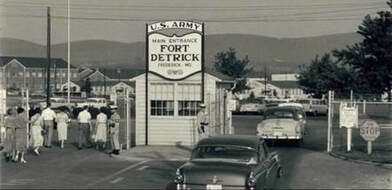 By the end of the 1950s, war-ravaged Europe had been re-constructed and began experiencing a tremendous economic boom. The United States and its allies had rebuilt their former foes into democracies based on the model of capitalism. Here at home, sluggish economic growth during the 1950s, would soon give way to another major boom in the 1960’s. World War II had brought about a huge leveling of social classes in which the remnants of the old feudal gentry disappeared, even here in Frederick. New residents from around the country, and world, had come to the area. This was primarily due to the growing importance of Camp Detrick, renamed Fort Detrick in 1956, and designated as a permanent installation for the US Army. Biological warfare experimentation continued to be researched here after World War II and throughout the Korean War to follow (1950-1953). Other projects underway involved scientists and support staff studying infectious diseases, cancer and genetic engineering. Some worked on developing better medical equipment and improving the environment. Detrick would also become the permanent site of the East Coast Relay Station in 1959, one of the key locations in America’s Defense Communications System, made all the more valuable during the Cold War period.  Other newcomers to Frederick County settled here as a result of the advent of commuting. The interstate highway system came about under President Dwight D. Eisenhower. Its importance stemmed originally from defense purposes, but it would soon revolutionize the nation by opening undeveloped areas throughout the country into new “suburbias.” High-speed superhighways allowed easy access to jobs centered in Baltimore, Washington, DC and Hagerstown. The expressway to the nation’s capital cut driving time in half, trimming a trip of roughly 80 minutes into one taking 40 minutes. On the local level, these roadways opened up new living opportunities throughout Frederick County. The automobile was the key lynchpin, allowing a degree of transportation freedom never experienced before. The economy of a nation benefited from the fruits of automobile makers.
The 1950s decade ended with J. Harold Hooper at the helm of the Chest, and a campaign goal of $110,000 for the United Fund Appeal (between the Community Chest and American Red Cross). At this time, another local non-profit called Counseling Services, Inc. was admitted for membership. Meanwhile, a push was being made on the national, state and local level towards providing civil rights for all—underscoring racial equality for African-Americans. The post-war time of high economic growth and general prosperity became one in which African-Americans united and organized, and finally secured a triumph as the Civil Rights Movement ended Jim Crow segregation in the South. Frederick was the northernmost bastion of noted race inequality as it lingered directly below the famed Mason-Dixon Line. Here, schools, civic and social clubs, and restaurants would soon experienc desegregation. Further laws were passed that made discrimination illegal, and provided federal oversight to guarantee voting rights.  Despite the prosperity of the postwar era, a significant minority of Americans continued to live in poverty by the end of the 1950s. In 1947, 34% of all families earned less than $3,000/year, compared with 22.1% in 1960. Nevertheless, between one-fifth and one-fourth of the population could not survive on the income they earned. The older generation of Americans did not benefit as much from the postwar economic boom, especially since many had never recovered financially from the loss of their savings during the Great Depression. It was generally a given that the average 35-year-old in 1959 owned a better house and car than the average 65-year-old, who typically had nothing but a small Social Security pension for an income. Many blue-collar workers continued to live in poverty, with 30% of those employed in industry in 1958 receiving under $3,000/year. In addition, individuals who earned more than $10,000/year paid a lower proportion of their income in taxes than those who earned less than $2,000/year.  Chief Charles V. Main Chief Charles V. Main Blasting Off into the New Decade The continuing generosity of the community was needed, and by now, expected. The average goal of the United Fund Appeals through the decade (1960-1969) was $155,222 with average contributions and pledges totaling $146,025. The campaign, however, did not run itself. It was the solicitation for funds led by community leaders and tireless workers who unselfishly gave of their time, talent and energies. Among the guiding citizens of Frederick County's Community Chest during the 1960s era, we find the names of: Carl V. Weakley (Manager-C&P Telephone) Nicholas A. Fanos (President, Frederick Iron & Steel) Charles V. Main (Frederick City Police Chief) Raymond C. Brehaut (President, Frederick Natural Gas Co.) Jacob R. Ramsburg (Co-founder Frederick Underwriters & local/state politician) George A. Zeigler (MJ Grove Lime Co.) John R. Cheatham (Owner/Manager, Key Chevrolet) Dwight Collmus (Alex Brown & Sons) Francis W. Bush, Sr. (Dir. Of Safety/PR, MJ Grove Lime Co.) Paul J. Green (Manager, Farmers Supply Company) John C. Houston (Frederick Electronics Corporation) Charles M. Trubac (Vice-President, State Farm Insurance) James L. Rimler (CPA/Frederick County Auditor 1956-1963) James W. Freeman (President, Frederick Natural Gas Company)
 "In an impassioned speech to both houses of Congress on May 25th, 1961, US President John F. Kennedy announced his ambitious aim of sending an American to walk on the moon before the end of the decade. Calling for a massive injection of extra funds into the space program, the President said: "I believe that this nation should commit itself to achieving the goal, before this decade is out, of landing a man on the Moon and returning him safely to Earth." The President went on to say that an estimated $9 billion would be needed over five years for research and development of the technology that would be required to make lunar exploration a reality, but that he did not envision the need for new taxes to raise the funds. In truth, Kennedy’s announcement was motivated by a number of political factors. He had been blamed for the failed Bay of Pigs invasion of Cuba by anti-Castro exiles in April, and had also seen the Soviet Union beat the US into space when Yuri Gagarin made his orbit of the Earth that same month. There was also a genuine fear of allowing the Soviets to get too far ahead in the Space Race in terms of what it might mean for their strategic power. “We go into space because whatever mankind must undertake, free men must fully share,” said the President. Frederick County got caught up in "space exploration fever" as well, trickling down to the Community Chest Appeal of 1961. "Appeal rockets" now took the place of the formerly used "appeal thermometers." The "Rocket" on its launching pad was designed by Larry Hauver, an 11th grader at Thurmont High School. Seven of these were placed at various locations around the county: Downtown Frederick, the Frederick Shopping Center at 7th Street, Fort Detrick, Walkersville, Thurmont and Middletown. Executive Director Willard H. Markey was soon replaced by Sgt. Harry A. Harper. Ironically, or by design, the air & space motif was kept intact as Sgt.Harper was a former Air Force recruiter in Frederick who retired from the military in 1961. Harper would serve the Frederick Community Chest over the next four years until 1966. Of particular note during Mr. Harper’s tenure was the October 1963 Kickoff Meeting for the United Fund’s 1963 fall campaign. Mr. Harper described the rally held in West Frederick Junior High School as “one of the most enthusiastic rallies ever to be held in the area”. The principle feature of the event was a collection of short reports given by the 11 member agencies of the United Appeal.  Robert F. Kennedy Robert F. Kennedy The overall worldwide economic trend in the 1960s had been one of prosperity, expansion of the middle class, and the proliferation of new domestic technology. Rapid social and technological changes brought about a growing corporatization of America and the decline of smaller businesses, which often suffered from high post-war inflation and mounting operating costs. Local employers were urged to utilize the payroll deduction method of securing pledges by their employees for contributions. Encouragement came from the nation’s capital as telegrams were received from Frederick native and US Congressman Edward McCurdy “Mac” Mathias, Jr., and another from US Attorney General, Robert F. Kennedy, brother of the president of the United States. Both messages were addressed to the Chest's General Campaign Chairman, John W. Morgan. Kennedy’s telegram read: “Congratulations to you and all your volunteers joining with you in your “kick-off” of the 1963 campaign. Your joint efforts are in the finest American tradition of people helping people. I am congratulating you and wishing you well (signed) Robert F. Kennedy.”  Turbulent Times Robert F. Kennedy’s brother would be assassinated just a month later in Dallas, Texas. The Kennedy family had captured the imagination of the country, especially young people. In response to civil disobedience campaigns from groups like the Student Nonviolent Coordinating Committee (SNCC) and the Southern Christian Leadership Conference (SCLC), President John F. Kennedy, pushed for social reforms. His death was a shock to the nation. The reforms of former President Kennedy were finally passed under Lyndon B. Johnson including civil rights for African Americans, and healthcare for the elderly and the poor. The confrontation between the US and the Soviet Union dominated geopolitics during the 1960s, with the struggle expanding into developing nations in Latin America, Africa, and Asia as the Soviet Union moved from being a regional to a truly global superpower and began vying for influence in the developing world. After President Kennedy's assassination, direct tensions between the US and Soviet Union cooled. However, the heavy-handed American role in the Vietnam War outraged student protestors around the globe. With escalation of this war throughout the second half of the decade and into the next, the Red Cross took on an air of greater importance for charity at home. New member agencies to the Community Chest over the previous few years were Travelers Aid, (1963), Kids Incorporated (1963), Epilepsy Chapter (1965), and Fort Detrick Youth Activities (1965). In 1966, new resident Roger Cann was appointed to succeed Harry A. Harper, who had left the area after being lured away to become executive director of the United Health Foundation in Peoria, Ill. Cann, a Boston native had come to Frederick by way of Salisbury, Maryland. During Harper’s four years at the helm, Frederick’s United Appeal rose from a nine-agency drive raising $120,000 (and not meeting its goal year after year) to a 13-agency drive which raised $161,000 in Harper’s last year (1965) exceeding its goal for the second straight year. Cann had great familiarity with the United Appeal and Community Chest because he had served as District Scout Executive for the Francis Scott Key Boy Scouts since 1958.  Sadly, Roger Cann’s tenure would be cut short by his sudden death in early January of 1968. The Community Chest Board found their new leader in retired Army colonel Richard Clendenin, who resigned his position as Public Relations Officer for Fort Detrick to serve as Executive Director of the annual United Fund campaign. Clendenin was part of the Army’s Chemical Corps and at one time served on the Pentagon’s general staff. He had been assigned to Fort Detrick, where he stayed until his retirement from the Army in 1963. His talent as an amateur actor and director endeared him to the local community as a regular with the Fredericktowne Players theatrical group.  The Fall campaign of 1967 marked the 30th such drive in the organization's existence. That first-ever Chest campaign of May, 1938 achieved a collection of $15,503.55. At the Community Chest's "Annual Appeal Recognition Dinner" held in February 1968, Chest President Paul J. Green remembered the late Roger W. Cann "for his devotion to his work and community." He also thanked his campaign chair John C. Houston on raising $160,916 thus achieving 93% of the appeal goal of $172,127. Last, but certainly not least, two special ladies, Mrs. Marie Linthicum (Community Chest Secretary) and Miss Mayetta Hershberger, (volunteer extraordinaire) were praised by Green for their "splendid cooperation and devoted support" during his term in office. The Community Chest of Frederick County closed out the decade with presidents Francis W. Bush Sr. in 1968 and James L. Rimler in 1969. The 1968 campaign raised $171,391 out of a goal of $190,000. To end the decade, the Chest "shot for the stars" with a campaign goal of $200,000. Although the goal was not achieved, the Community Chest of Frederick County would raise $183,840 for its partner agencies.  Recounting the fashion trends of the period is an exercise not for the squeamish Recounting the fashion trends of the period is an exercise not for the squeamish Super Seventies Historians have increasingly portrayed the 1970s as a "pivot of change" in world history focusing especially on the economic upheavals, following the end of the postwar economic boom. Social progressive values that began in the 1960s, such as increasing political awareness and economic liberty of women, continued to grow. Most industrialized countries experienced an economic recession due to an oil crisis caused by embargoes. The crisis was felt by consumers and featured such travesties as skyrocketing mortgage rates and long lines at gas pumps. Novelist Tom Wolfe coined the term “the ‘Me’ decade" in an article published for the New Yorker Magazine. The term described a general new attitude of Americans towards atomized individualism and away from communitarianism, in clear contrast with the 1960s. It was a time that saw people embrace entertainment and consumer culture like never before. These factors seemingly would stack the deck against federated giving. In 1970, a name change came to the organization originally founded in 1938 as the Frederick Community Chest. The new moniker given was the United Givers Fund of Frederick County, Inc. In addition to a new name, Goodwill Industries became the group’s 14th member agency at this time. In late December, 1970, Col. Clendenin would announce his resignation in order to enjoy retirement and devote more time to his acting hobby. A surprise move was on the horizon in the form of Clendenin’s replacement—one that seems so fitting with the rise of the second phase of the feminism/women’s movement. This period was ripe with activity aimed to gain greater equality for women by giving more than just voting rights, as it included domestic issues (such as clothing and a break with traditional household roles) and employment. At a meeting of the Frederick County United Givers Fund (UGF) Board of Directors in late November 1971, an announcement was made that the Board had unanimously elected Mrs. Marie Linthicum as executive director. The Mount Airy native (and mother of two) had served as office secretary since taking over from Helen Croghan in 1965. Linthicum’s previous work experience included secretarial duties held with the Social Security Administration in Baltimore and the Board of Education of Montgomery County. Interestingly, a newspaper account announcing her appointment states: "in addition to being active in scouting and serving as an assistant den mother, Marie Linthicum was a former “Miss Mount Airy.”  Suburbanization caused the gradual movement of working-class people and jobs out of the inner cities as shopping centers displaced the traditional downtown stores. In time, this would have disastrous effects on urban areas. In the meantime, the suburban housing market was booming. This was happening here in Frederick. City residents and newcomers moved into the suburbs of Frederick. Developments such as Clover Hill, Frederick Town Village, Eastgate, and townhouse communities such as Amber Meadows and Waverly Gardens offered safehavens away from the declining downtown area. Downtown businesses were following suit, or receiving newfound competition from the many restaurants and stores that would open within two major shopping malls, built during the decade. Surrounding corridors including The Golden Mile (US40) and Evergreen Point (MD85) would become commercial meccas. UGF, We hardly Knew You The United Givers Fund of Frederick County of the early 1970s would be led by the likes of Charles M. Trubac, Vice-President of State Farm Insurance (1970); James W. Freeman, President, Frederick Gas Company (1971); F. Lawrence Silbernagel, Regional VP of Maryland National Bank (1972); Charles A. Simms, General Accounting Supervisor for Eastalco Aluminum Company (1973); and J. Paul Langley, Asst. General Manager of Capitol Milk Producers (1974). In 1972, Marie Linthicum was replaced by another female executive–Dorothy Jean Laws. Mrs. Laws was no stranger to the organization, having served as Executive Secretary for the United Giving Fund of Wicomico County since 1962. She was exactly what Frederick County needed, and would prove invaluable as yet another outsider who brought fresh ideas and perspective to the community. Laws' previous experience with United Giving campaigns was paramount. This would be an era where a stronger relationship would be built between the local chapter and the parent organization, United Way of America, which had recently moved its headquarters from New York City to nearby Alexandria, VA in 1971.  QB Roger Staubach for the United Way QB Roger Staubach for the United Way One of the top achievements of Frederick’s newly named UGF organization in the early 1970s was heightened visibility outside the traditional campaign model. This came with successful sponsoring of unique community benefit events. The entity would begin hosting annual golf tournaments, a "Show & Tell" exhibit at the newly constructed Frederick Towne Mall, and variety talent shows. Entitled "Curtain Call '72," the UGF's first variety show was held at Gov. Thomas Johnson High School's auditorium on October 5th, 6th and 7th, 1972. The Fredericktowne Players were of key importance in making this opportunity a reality, as was former UGF Executive Director Richard Clendenin who aided the production in several ways. A second show was held in 1973 with help from the Frederick Jaycees. The 1970s would also be a period in which cooperative marketing and advertising would be introduced in earnest. Here locally, cartoon-style advertisements began appearing in the Frederick News-Post with more sophisticated advertising would follow. In 1973, the national United Way took an unlikely partner in increasing public awareness of social service issues facing the country. This was the National Football League (NFL). In addition to public service announcements featuring volunteer players, coaches and owners, NFL players began supporting their local United Ways through personal appearances, special programs, and participation on United Way governing boards. In 1974, United Way and the NFL undertook the largest public-service campaign in the nation’s history. The televised commercial spots called “Great Moments” were a major key in bringing greater awareness. United Ways would raise $1.68 billion, a 10.1% increase over the previous year. The campaign worked, and continues to this day. In Frederick County, Executive Director Laws helped in raising $233,489 with leadership from President J. Paul Langley and Campaign Chair Robert G. Hooper (Branch Mgr. Baker, Watts & Co.). Hooper was a legacy member of the organization, as his father, J. Harold Hooper, had served as Frederick Community Chest president in 1959. Bob Hooper would take the reins of the UGF the following year as president in a year which a 12th agency member was added—Friends for Neighborhood Progress. In April 1975, it was announced that the United Givers Fund of Frederick County name was going to be changed to the United Way of Frederick County. According to President Hooper, the name change was necessitated by a developing trend toward the abandonment of the United Giving Fund label in favor of the United Way designation. He said that many persons coming here from other parts of the country were confused by the UGF name. This was also a testament to the nationwide exposure that heightened advertising was providing. A Flood of Leadership Another community leader who gave of his time and talent to lead the organization through the mid 1970s was John E. “Jack” Tritt. Tritt was purchasing agent for Frederick County Schools. As president during the nation’s Bicentennial Celebration year (1976), he was also in the lead during a special time in Frederick's history as Frederick had been named an All-America City by the National Municipal League. This award came thanks in part to activism shown by civic participation and problem solving by the United Way and its predecessors (UGF/Community Chest) and a group called Operation Town Action, a group focused on rebuilding the struggling downtown. The latter was led by residents Don Linton and Peggy Pilgrim and Curtis Bowen. Jack Tritt was aided by a true legal team of campaign chairs: Lawrence A. “Tommy” Dorsey, Jr., a local attorney whose father was sitting president of the Frederick County Commissioners; and G. Edward Dwyer, another practicing lawyer who later would earn distinction as a chief judge of the 6th Judicial Circuit (serving from 1991-2016). In mid-September, a photo appearing in the Frederick News showed Campaign Chair Dorsey receiving a ceremonial citation from the Frederick County Commissioners, presented by his father, declaring the upcoming month of October as “United Way Month.” A goal of $272,000 had been set.  Frederick Post (Oct 7, 1976) Frederick Post (Oct 7, 1976) Unfortunately, the spotlight wouldn’t stay on the organization long as tragedy would strike weeks later on October 5th, 1976. A devastating flood did nearly $25 million dollars in damage to downtown Frederick, and several other sites around Frederick County as the effects were felt of an abnormal storm producing abundant rains. It was a trying campaign as can be imagined. Frederick, and the local United Way chapter, received a wake-up call with the flooding. It had never experienced catastrophes such as hurricanes, tornadoes or earthquakes like other towns and cities. This was a major disaster, and the community came together to help, rebuild and plan for the future.  Bentz and W. Church streets during the Great Frederick Flood of 1976 Bentz and W. Church streets during the Great Frederick Flood of 1976 The Great Frederick Flood of ‘76 was a major point of change in local history. The United Way contributed to the relief efforts. Help was especially exemplified through one of its partner agencies—the Red Cross of Frederick County. In 1976, the organization would receive $22,709 in funds from the United Way of Frederick County. Perhaps fate, but more so, the experience of the previous year, led to over $265,000 in campaign collection to hit a 97% success rate with the campaign. The following year would achieve 100%. It had taken Executive Director Jean Laws five years, but she had got the campaign to meet its quota, the first time in 11 years since it was achieved in 1965 under President Dwight Collmus and Campaign Chair Charlie Main. At a recognition dinner in February 1977, incoming UWFC President Tommy Dorsey had the distinct pleasure of presenting Patricia G. Sykes the award for Outstanding United Way Volunteer of the year. Ms. Sykes, a Texas native, directed the United Way’s publicity campaign, which featured numerous, well-written articles on the organization’s 12 partner agencies, and volunteer chairmen. Sykes was the first woman to ever receive the award, and received a standing ovation from the capacity crowd assembled at the VFW Country Club. President Dorsey called Ms. Sykes “the epitome of caring.” In April, 1977, the UWFC welcomed another partner to the fold—Frederick County Association of Retarded Citizens. Big Brothers and Big Sisters had recently come on board as well, bringing the total of member agencies to 14. The desired set goal of $284,000 was attained during the ’77 campaign. Dorsey confidently handed the presidential gavel to G. Edward Dwyer the following year—not to mention the fact that Dwyer was also given a desired campaign increase for the organization’s 40th anniversary year. Two more non-profits would join as partner agencies—Mental Health Association and the Learning Tree, Inc. The 40th annual campaign kickoff event held on September 9th, 1978 was just that. The commemorative event featured interesting football-related novelty events such as having five local, high school kickers on hand to actually “kick-off” the event. Local radio “on-air” personality Tommy Grunwell hosted the event at the Baker Park Bandshell. All in all, it was a great way to connect the local chapter to the national advertising campaigns involving the partnership with the NFL. Meanwhile, Judge Ed Dwyer, as he is best known today, together with his campaign chair, Willard W. Lindquist along with the United Way of Frederick County's campaign team, bested their 1978 goal of $324,000 by “scoring” a definite touchdown with an extra point in a 101% effort garnering a final tally of $328,500.  The United Way family now included: the American Red Cross, Arthritis Foundation, Big Brothers-Big Sisters, Boy Scouts of America, Counseling Services of Frederick, Epilepsy Chapter, Girl Scouts of America, Federated Charities of Frederick County, Frederick Community Center, Frederick County Association of the Retarded (later known as ARC), Goodwill Industries, Learning Tree, Inc., Salvation Army, Seton Center, Mental Health Association and the YMCA. Forty years of history were now officially in the books going back to the day of incorporation as the Community Chest, April 11th, 1938. As the organization was under its third moniker, the United Way of Frederick County, Inc. had shown that it was still growing as a perennial winner for Frederick and Frederick County. As a sign of the times, one could say that they were caught up in "Saturday Night Fever" doing much more than simply "Stayin' Alive." This of course is a nod to super-group the Bee Gees who dominated the charts during the anniversary year. 1938-1958 A fortunate occurrence in local history occurred in the year 1938. It was the beginning of “united giving” in Frederick with the formation of the Community Chest. This fund-raising organization was created to collect money from local businesses and workers to be distributed toward important charity and philanthropic projects in the community. The initial impetus of the program came as a remedy to assist in funding the operating budgets and capital needs of several partner agencies.  Joseph D. Baker "Frederick's First Citizen" Joseph D. Baker "Frederick's First Citizen" “Timing is everything” as they say. Ironically, or by divine design, this was the same year that Frederick lost its great and iconic benefactor—Joseph D. Baker. Given the moniker of “Frederick’s First Citizen,” Mr. Baker died October 6th, 1938 at the age of 84. His legacy includes generous donations that would create the Buckingham School for Boys; the Record Street Home for the Aged; the Baker Annex at Frederick City Hospital for the county’s African-American population; the Frederick YMCA; a new home for Calvary Methodist Church and a spacious municipal park that bears Mr. Baker’s name. Upon his death, friend James H. Gambrill, Jr. remarked, “The influence of his life will remain as a continued benediction upon the city of Frederick.”
Also stepping up in times of need were local businesses such as the Frederick News, Ox-Fibre Brush Company and the Union Knitting Mills. Nothing illustrates this latter point better than the thrilling events of July 1864 during the American Civil War when Frederick’s leading banks provided necessary funds to pay the infamous $200,000 ransom levied by Confederate General Jubal A. Early. The city was spared.  The timing of Frederick’s Community Chest creation was impeccable. Over the next several decades, this organization would incur multiple name changes and eventually come known as United Way of Frederick County. All the while, the citizenry’s passionate spirit of giving has remained the same for 80 years. Earlier Frederick residents and business persons have passed the torch to later generations, as well as newcomers to the area, dedicated to the cause of assisting the unfortunate and impoverished in our community. For eight decades, a variety of non-profit groups and agencies have received invaluable support from Frederick’s “united giving” organization thanks to both big and small business entities, local institutions and private citizens. Donations have come in the form of manpower hours, cash pledges, matching grants and supplies totaling in the tens of millions. Today, United Way of Frederick County brings the community together to provide resources that aid people in need, or at risk, in order to help solve problems. This is the same intention that started the organization here in 1938.  GENESIS (1938-1958) Although we look to 1938 as the year of founding, United Way of Frederick County was first conceptualized nearly a century ago, thanks to the mobilization of the country’s population and economy during World War I. The support efforts on the home front required soldiers, food, ammunition and money—key necessities to win the international conflict. Frederick County residents certainly did their part, and Allied efforts secured victory in November, 1918. All the while, valuable lessons regarding the importance of preparedness and teamwork were gleaned from this terrible chapter in our country’s history. As soldiers returned home from Europe and elsewhere, the United States found itself as one of the world’s top military and economic powers. National leaders saw the need for better organization and improved amenities at home. Soon began infrastructure changes to the armed forces, roadways and transportation systems, and government agencies. It was a time of social and political reform, and economic prosperity that would usher in “the Roaring Twenties.” At the local level, community leaders, residents and veterans alike could reflect upon the power of their collective actions in the recent war effort. Many began to feel a renewed vigor, and entertained the notion of waging war on a new foe—the ills and social problems here at home. These could be addressed by a “united” effort of care and fund-raising among neighbors, in an attempt to further improve Frederick County.
The Community Chest organization dates back to Cleveland, Ohio and the year 1913. It had the purpose of conducting organized, fundraising campaigns with local businesses and employees—the proceeds distributed to important local projects. The drive to establish a group like this in Frederick would take several years as not everyone favored the idea. Consternation and cynicism were expressed by more than a few of Frederick’s established fundraising enclaves such as fraternal organizations, church councils and civic groups. Some felt that a new “charitable union” would undo individual successes, and feared fund management by someone other than themselves. The matter of a united fundraising entity would be tabled until 1932, at which time the Frederick Lions Club re-introduced the idea for a Community Chest program. John W. Wolfe, chairman of the Lions’ Welfare Committee, was named to head a group to study the "Community Chest" concept and report his findings to the club. A year later, the local chapter of the Salvation Army would endorse a community chest for Frederick at its June meeting in 1933. Again, no formal movement would be taken. Florence Garner, leading member of the Federated Charities organization was among the Salvation Army’s advisory board in support of the plan. Founded in 1911, Federated Charities was headquartered at 22 S. Market Street in the old home bequeathed by Margaret Janet Williams, daughter of a former Frederick banker, John H. Williams. This umbrella group oversaw a Free Kindergarten for the community and the operation of the Charity Organization Society which provided assistance to families that could not be helped by other agencies. Services included a Prenatal Care Clinic, visiting nurse and drug prescriptions and the distribution of medical equipment, food, heating oil and used clothing to families that qualified. Florence Garner was the General Secretary of Federated Charities and carried a great deal of clout in the community, especially in addressing medical and social needs. She had originally come to Frederick from Ohio in 1912 to fill the organization’s position as visiting nurse. Ms. Garner helped lay the initial groundwork for Federated Charities and rose to lead the organization, staying for 38 years until her retirement in 1950. Having Ms. Garner as an advocate (for a Frederick Community Chest) certainly spoke volumes.  Certificate of Organization Membership for the Frederick County Chamber of Commerce Certificate of Organization Membership for the Frederick County Chamber of Commerce Enter the Chamber The country was quite a bit different than it had been a decade earlier. Residents had seen the legendary stock market crash of 1929, launching the era known as the Great Depression. Its effects would be felt for over 12 years as many people lost money in the form of savings and inheritances. Others found themselves without jobs, with new ones hard to find. In 1930, more than 14,400 people lived in Frederick City, the county population was 54,440. There were plenty of businesses and employers in town, but Frederick sorely lacked jobs in large industry. Regardless, Frederick had an organized Board of Trade, originally chartered in 1912. The newly christened Frederick County Chamber of Commerce was the first chartered “Chamber” in the United States. In the 1920’s, the local Chamber adopted the slogan, "If Frederick is worth living in, it is worth working for!"  CCC workers constructing the Catoctin Recreational Demonstrational Area CCC workers constructing the Catoctin Recreational Demonstrational Area Meanwhile, President Franklin D. Roosevelt was moved to institute his “New Deal” plan (1933-1938) as a means to provide employment through federal programs such as the Works Progress Administration (WPA) and the Civilian Conservation Corps (CCC) among others. If there was ever a time for much needed charity, this was it. A few years would pass until January 1938. The time to consolidate Frederick’s varied charity drives was long overdue. The Frederick County Chamber of Commerce announced a goal to secure a community chest for Frederick, once and for all. Chamber members and local businesses had oft been targeted to assist in leading, and making contributions to, local charity campaigns. Oftentimes this would make many individuals and businesses feel overwhelmed by multiple requests to participate in competing fund drives. Worse yet, they found it increasingly hard to say no.  The Community Chest offered a great solution for pooling resources and time, not to mention cross-marketing the many needs of the community to the populous. Plans were discussed for a single, annual drive to replace independent, money-raising campaigns. Competition would soon be eliminated as various charities would share proportionately under the Community Chest model. A community meeting was scheduled for mid-February to consider whether the time was right for a community chest for Frederick. This would be held at the Francis Scott Key Hotel in downtown Frederick on the night of Wednesday, February 16th, 1938. The following day, the Frederick News featured the headline "Community Chest Idea Gains Impetus." Thirty-three Frederick citizens and representatives of charitable causes apparently "threshed" out the question of whether it could be carried out. Hearty sentiment was shown, and without dissent, the group voted that a committee of 19 persons draw up plans for such a chest and submit them at a public meeting to be held for the purpose within three weeks. The actual minutes from this meeting are preserved within the archives of Heritage Frederick (formerly the Historical Society of Frederick). They appear below: On March 22nd, a public meeting to consider the draft of a constitution and by-laws for the proposed Community Chest would be held at the Francis Scott Key Hotel. Here the assigned committee had opportunity to show their work. Overwhelming support was demonstrated again, and another meeting was scheduled for March 25th, one in which a board of directors would be elected and officers named. The strength and ties of the Frederick County Chamber made the “united giving” model a reality on April 11th, 1938. This was the day that the Articles of Incorporation were officially signed by 24 individuals, and filed with the State of Maryland.
 Delaplaine Food Drive of 1895 Delaplaine Food Drive of 1895 The organization’s Second Vice President was William T. Delaplaine (Jr.), son of the founder of the Frederick News. Delaplaine made sure that the idea of the community chest got plenty of traction in his family's newspaper. Interestingly, his father, William T. Delaplaine (Sr.), had died as a result of contracting pneumonia attributed to tireless efforts associated with a charitable food drive performed by the newspaper during the harsh winter of 1895. The Frederick Community Chest’s secretary was John W. Wolfe, the man charged by the Frederick Lions Club to study the community chest’s feasibility a few years earlier. The first treasurer was William D. Zimmerman (Cashier of Frederick County National Bank). Also holding spots on the Board were two sons of great philanthropists from the area’s past: Holmes D. Baker (son of “Frederick’s First Citizen” Joseph D. Baker) and James H. Gambrill, Jr. (son of James H. Gambrill, successful agriculturalist and miller). The latter operated the Mountain City Mill for decades, today known more commonly as the Delaplaine Center for the Arts. Gambrill Park was named for James, Jr. in honor of his tireless fight for public recreation facilities and nature conservation. Rounding out the first Board of Directors of the Frederick Community Chest were William B. Bennett (Bennett’s clothing store), Dorothy Filler McBride (President of the Maryland State Board of Examiners of Nurses) and Dr. Ignatius Bjorlee (President of the Maryland School for the Deaf from 1918-1955). Other leading citizens to lend their support and energies included Parsons Newman (fine antiques expert), Benjamin B. Rosenstock (canning company owner), Charles McCurdy Mathias, Sr. (lawyer/politician), Russell Ames Hendrickson (owner of a ladies clothing store) and William Bartgis Storm (Citizens Bank/president of the United Fire Company).
 A volunteer paints in an adjustment to a Community Chest thermometer in Wisconsin A volunteer paints in an adjustment to a Community Chest thermometer in Wisconsin A “Federated” New Home By late June, 1938 the Community Chest would have a home base of operations. This would be the former domicile of Frederick banker John H. Williams. The house more recently had been inhabited by Federated Charities and was located at 22 S. Market Street. Greeting visitors was the aptly named iron, dog statue on the front portico—“Charity.” This four-legged icon had been on the site since the start of the Civil War. A second Frederick Community Chest drive would occur in May, 1939, and was headed by Robert L. Smith, District Manager for the Potomac Edison Power Company. The goal of the campaign was upped to $16,550. Results were displayed each day on a large novelty thermometer, located on the front of the Federated Charities building (22 S. Market Street). By the end of the drive period, funds were $2,500 under the goal. The family of Joseph D. Baker, Sr. stepped up with a $1,000 donation which sparked others to fulfill the goal amount. When it was all said and done, 2,359 different contributors had taken part in the campaign.
 As the importance of these fundraising drives became better known to the residents of Frederick, success rates grew proportionately. The fifth Chest Drive appeal took place in May of 1942 and raised in excess of $2,000 over the desired goal. This was particularly encouraging due to a local and national climate characterized by participation in World War II causing the offshoot effects of apprehensive workers, a rising cost of living, war rationing and other unfavorable conditions. Against this backdrop, a new member was admitted to the Community Chest membership in late 1942 in the form of the Girls Scouts of Frederick. The next few years (1943-1945) would be especially trying. While war was raging on foreign soil, men and women here did their part to support the fighting troops. Many men traveled to Baltimore and Hagerstown to work in ship yards and aircraft plants. Local businesses such as the Union Knitting Mills, Ox Fibre Brush Company and the Everedy Company also played roles in the war effort.  Women packaged bandages in their homes for the Red Cross, an organization of paramount importance at this time—so much so, that the directors of the Community Chest decided to postpone their annual spring-based drive in deference to the Red Cross’ drive. When they proceeded the following fall, a partnership had been made with the National War Fund to conduct a joint campaign. This effort exceeded its quota as nearly $59,000 was garnered. The joint campaign would become the norm for the next two years. The respective campaign chairs in 1944 and 1945 were former veterans of World War I, not to mention the fact that they were from leading Frederick families: James H. Gambrill III, and R. Ames Hendrickson. After massive devastation of their own countries and loss of life, Italy surrendered in 1943, and Germany and Japan in 1945. On the other hand, the US emerged far richer and with fewer casualties comparatively. The Frederick community, and nation, learned once again the important lesson of teamwork, dedication and sacrifice in dire times of need. Post-War America Twelve million returning veterans were in need of work and in many cases could not find it. Inflation became a rather serious problem, averaging over 10% a year until 1950. Raw materials shortages dogged manufacturing industry. In addition, labor strikes rocked the nation, in some cases exacerbated by racial tensions due to African-Americans having taken jobs during the war and now being faced with irate returning veterans who demanded that they step aside. Munitions factories shut down and temporary workers returned home. Following the Republican takeover of Congress in the 1946 elections, President Harry Truman was compelled to reduce taxes and curb government interference in the economy. With this done, the stage was set for the economic boom that, with only a few minor hiccups, would last for the next 23 years. After the initial hurdles of the 1945-48 period were overcome, Americans found themselves flush with cash from wartime work due to a slowdown in buying for several years. The result was a mass consumer spending spree, with a huge demand for new homes, cars, and housewares. Increasing numbers of people enjoyed high wages, larger houses, better schools, more cars and home comforts like vacuum cleaners, washing machines—which were all made for labor-saving and to make housework easier.  Here in Frederick, many found employment at Frederick’s Camp Detrick, a US Army installation specializing in medical and biological warfare research. Others took employment located throughout the county and region as government jobs were becoming more plentiful. GI Bills assisted veterans in completing education and securing loans for such things as automobiles and houses. This became a contributing factor for an increasing population characterized as “the Baby Boom,” in turn, bringing a greater demand for improved educational facilities, medical amenities and of course, social services. As many families began migrating to the rapidly expanding suburbs, optimism was the hallmark of the new age—an age of grand expectations. The Roosevelt administration of the previous decade generated a set of political ideas—known to later generations as New Deal liberalism. This remained a source of inspiration for years to come. Community Chest campaigns over the next few years had cash collections that nearly doubled those before the war.
 Before decade’s end, more successful drives were enjoyed and another non-profit member was accepted for membership. This was the Esther E. Grinage Kindergarten, the first such pre-school opportunity for African-American children in modern times in Frederick. Much of Frederick was still segregated at this time. This was exemplified here in Frederick with public schools, hospital entrances, parks, restaurants and movie theaters. The gesture of support by the Frederick Community Chest spoke volumes during a difficult time of racial inequality visibly present at the local, state and national level. The 1949 campaign drive was also noteworthy and historic in the fact that it marked the first time Frederick’s local Black population became involved in earnest with the organization that would one day become known as the United Way. As the Community Chest entered the decade of "the Fabulous Fifties," Harry Truman would be followed as president of the United States by the Republican war hero, Gen. Dwight D. Eisenhower. He was a moderate who did not attempt to reverse Franklin D. Roosevelt's "New Deal" programs such as regulation of business and support for labor unions. President Eisenhower actually expanded Social Security and built the interstate highway system. This was also a time of confrontation and fear as the capitalist United States and its allies politically opposed the Soviet Union and other communist countries—the Cold War had begun. Community Chest drives would continue throughout 1951-1959 with an annual average collection of $52,000. Each year now brought a new Frederick Community Chest president to the forefront. Names would include Glenn T. Swisher (Comptroller-Potomac Edison Co.), Paul McAuliffe (Manager-Francis Scott Key Hotel), Niemann Brunk (Owner-Frederick Produce Co.), Byron Winebrenner (Comptroller-Frederick Produce) and Charles S. V. Sanner (Insurance Agent). 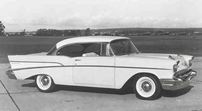 As locals would first see the emergence of a singer named Elvis Presley and a re-designed Chevrolet automobile, the Community Chest’s Board of Directors under president (and local attorney)Parsons Newman decided to re-tool their own organization on a county-wide basis. They also instituted the “United Fund Campaign” for the entirety of Frederick County. Local Farmers &Mechanics Bank President Benjamin L. Shuff was appointed campaign chairman, and put together the first countywide campaign. Another historic element of this campaign was the first-ever use of a payroll deduction plan for employee donors. On September 25th, 1957, a well-attended dinner meeting of the Frederick County division of the Community Chest was held at the Francis Scott Key Hotel. Among those in the attendance were 50 area captains and election district chairpersons of the campaign from rural areas around the county. The keynote speaker was past Chest president, and campaign chair, Charles S. V. Sanner. He was a one-time special assistant to the Fort Detrick commandant, along with being a realtor and insurance agent. Sanner gave an overview of the Frederick Community Chest’s first 20 years in Frederick from formation to the recent countywide drive. He also spoke about the member agencies that the campaign helps each year. “Respect for the privacy of the individual recipients of our aids,” Sanner said, “has prevented many of our county services from being generally known to the public. These are not old-fashioned charities but vital public services and character building organizations.”
|
AuthorChris Haugh Archives
February 2024
Categories |
Proudly powered by Weebly





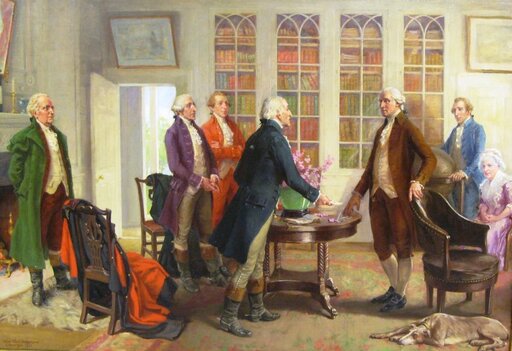



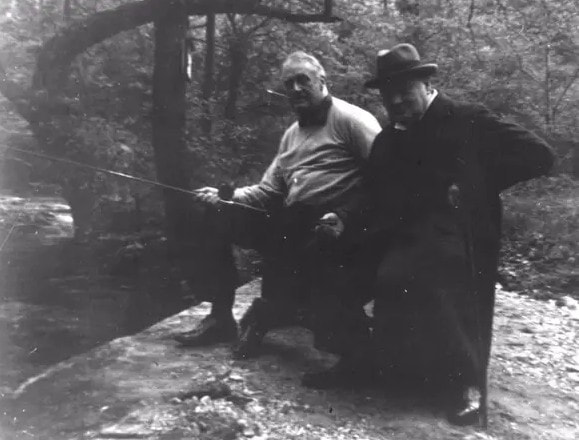







































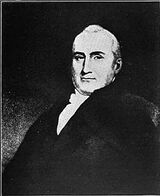










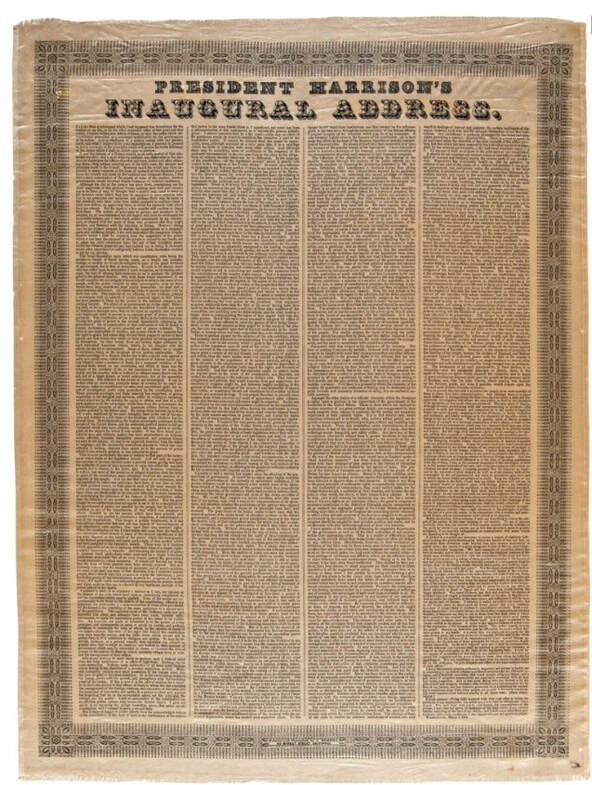


























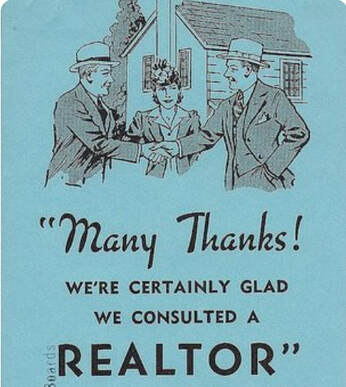


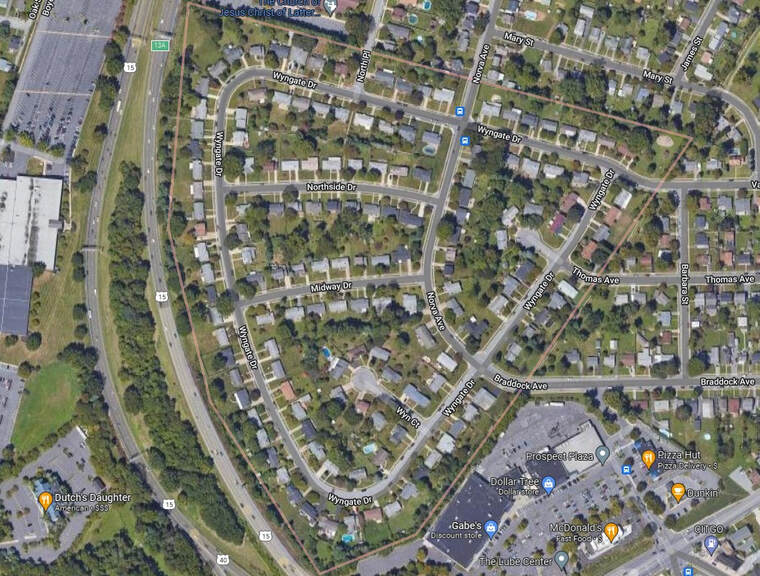


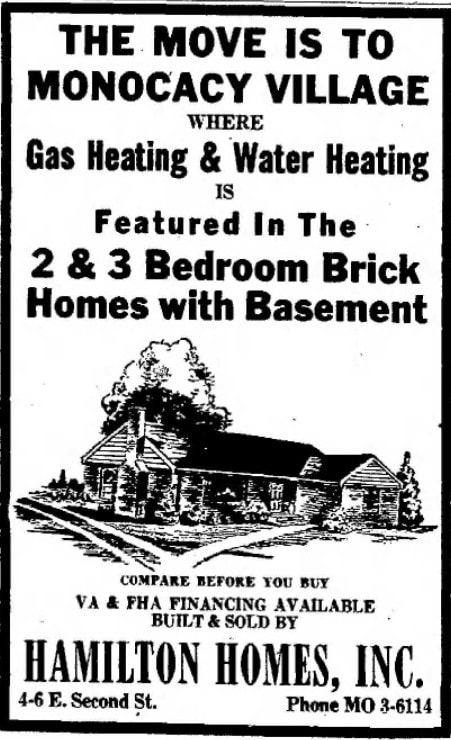





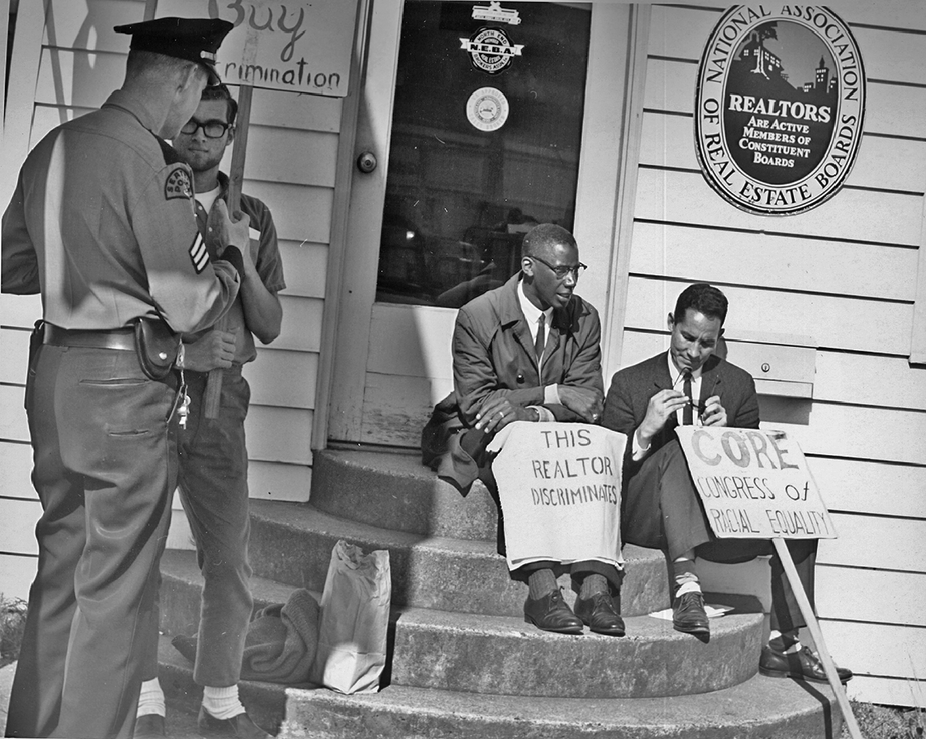


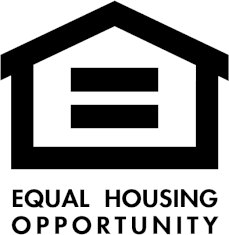
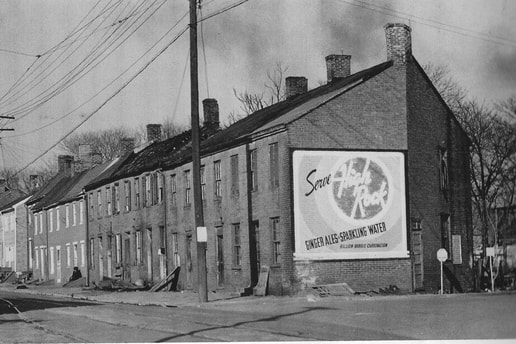

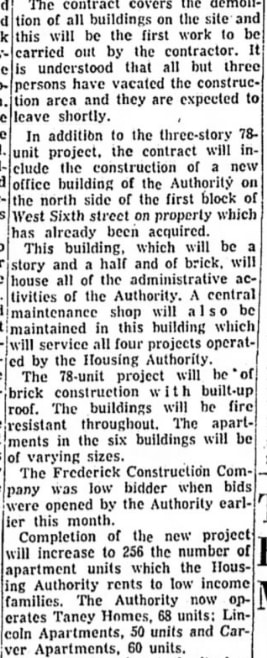






























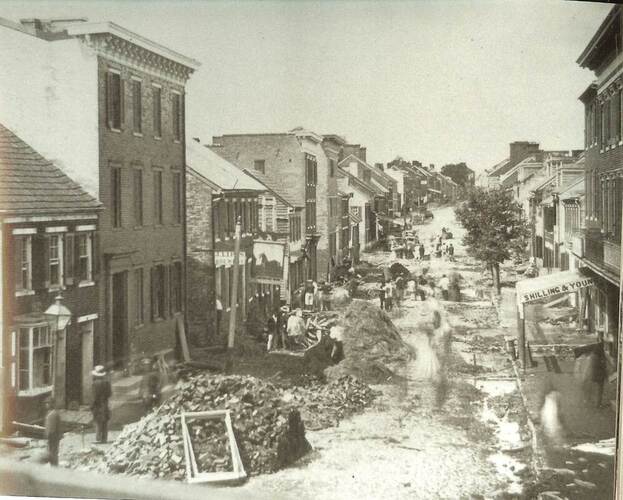

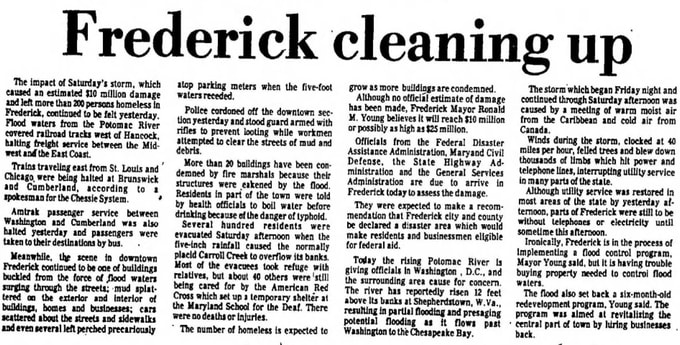

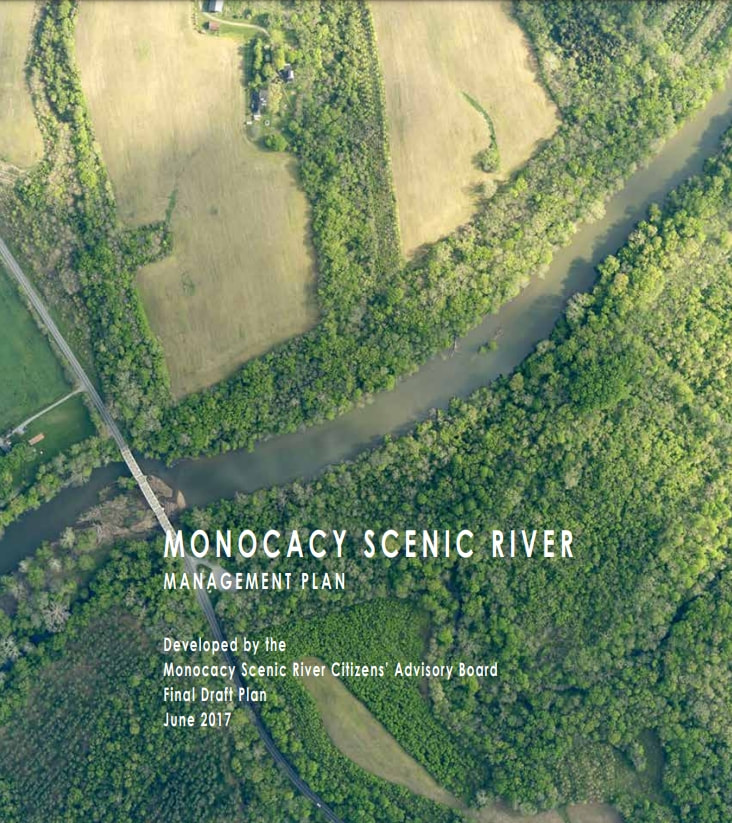




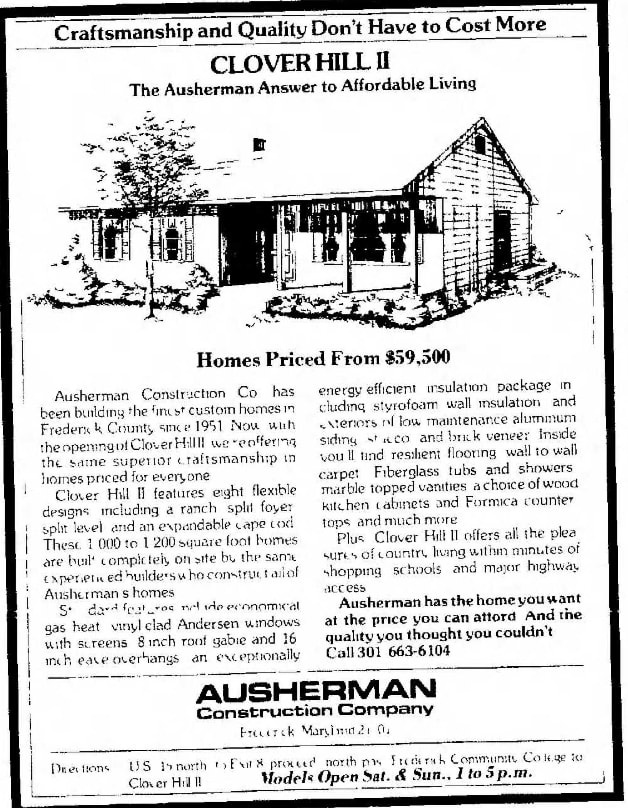

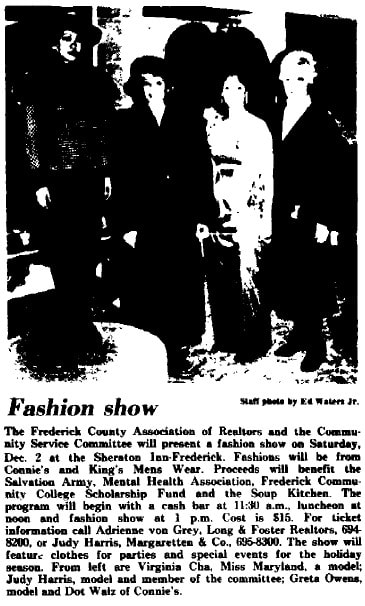











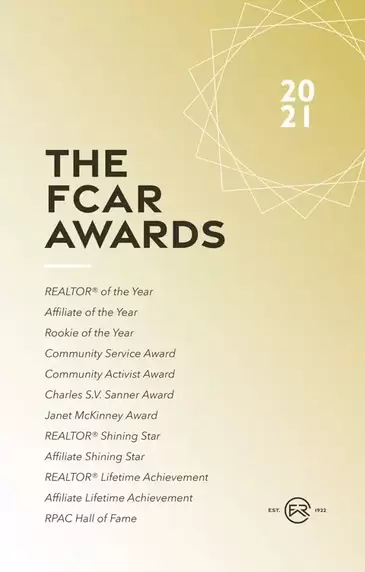






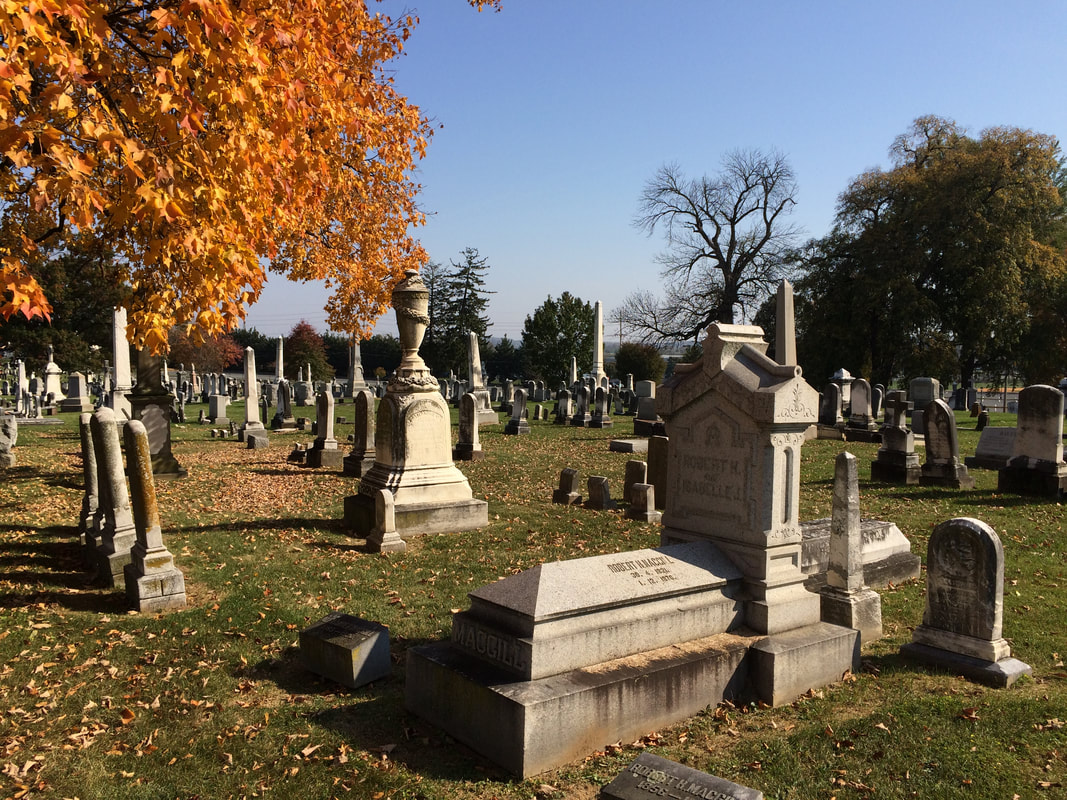


















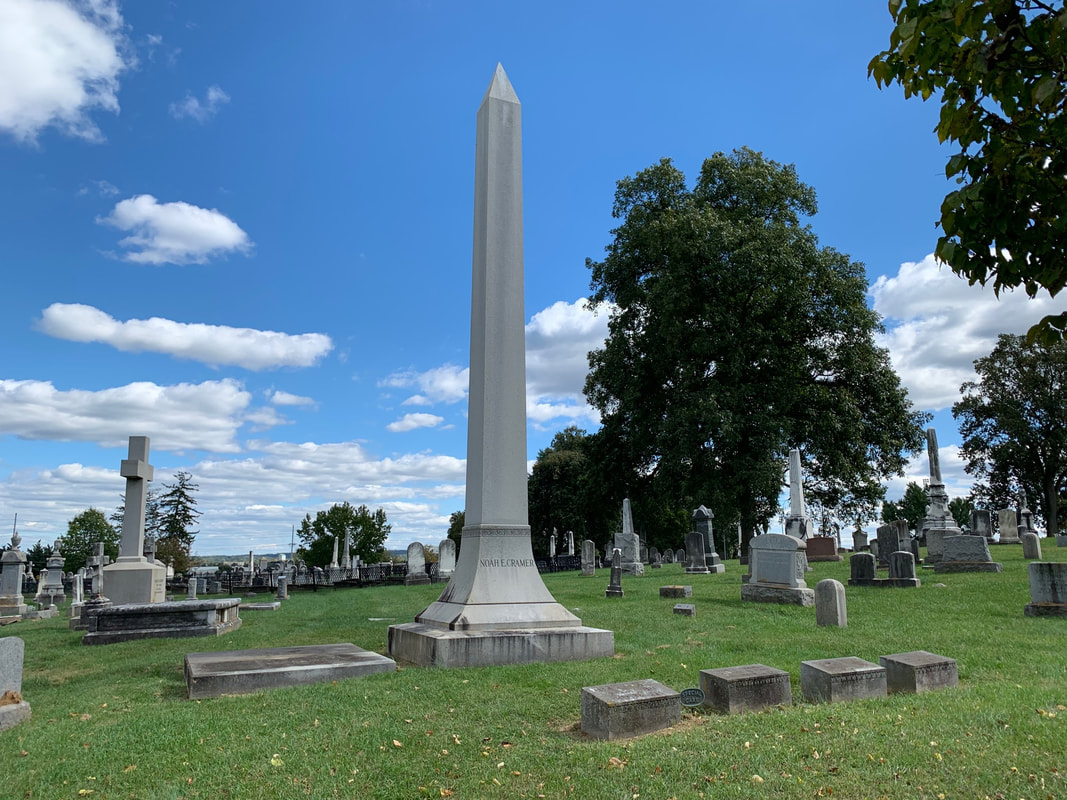










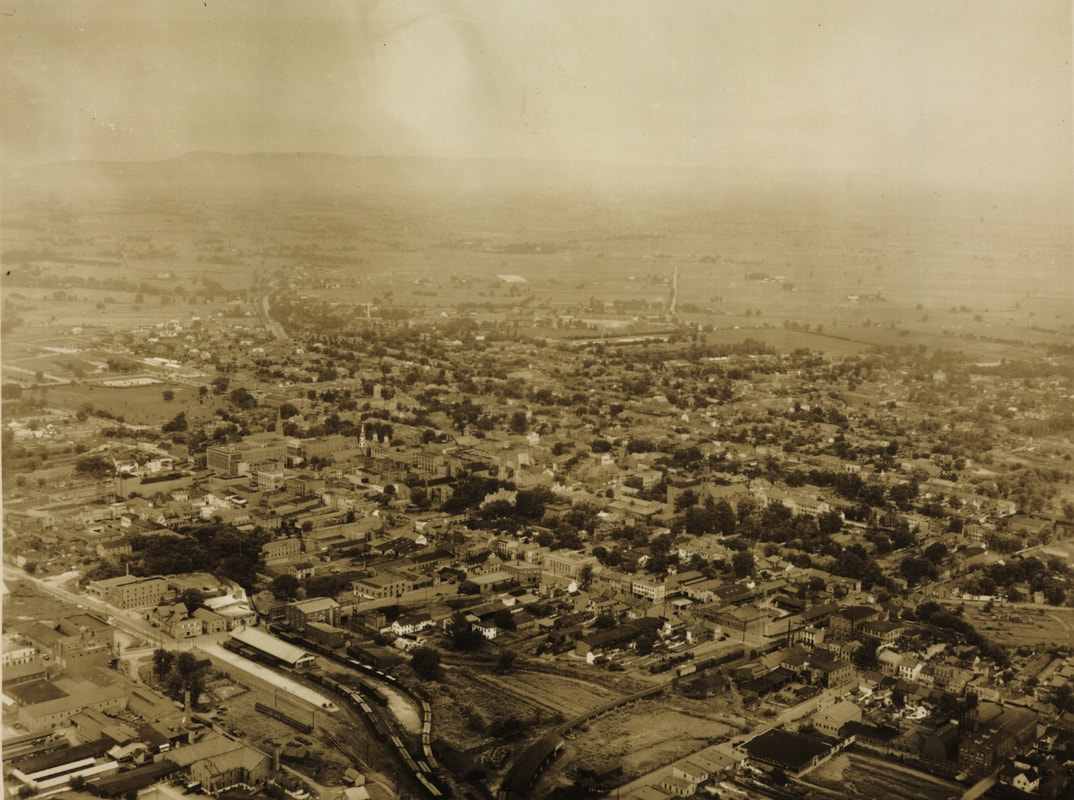














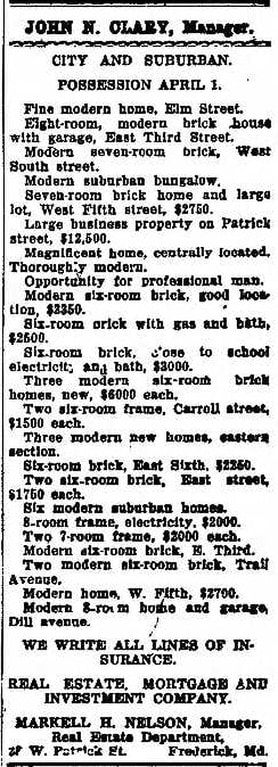
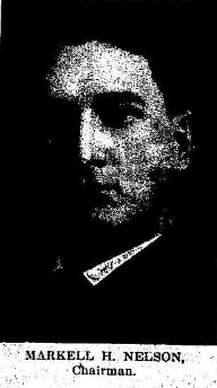













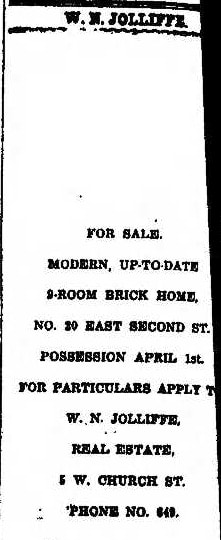



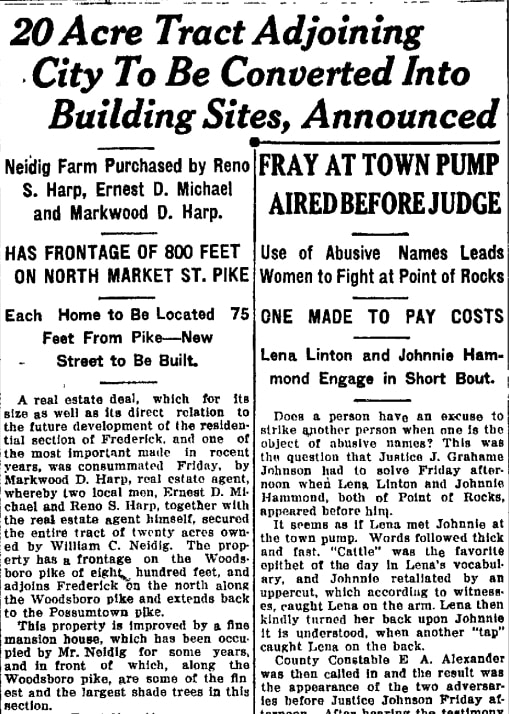



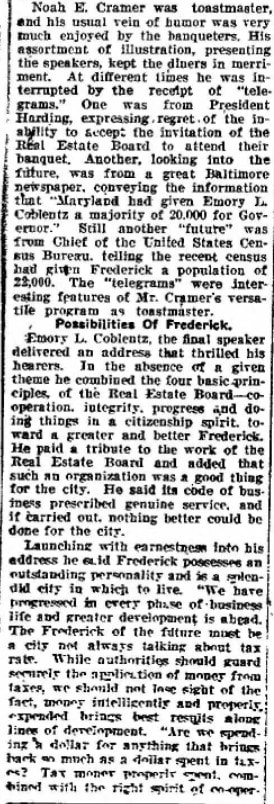





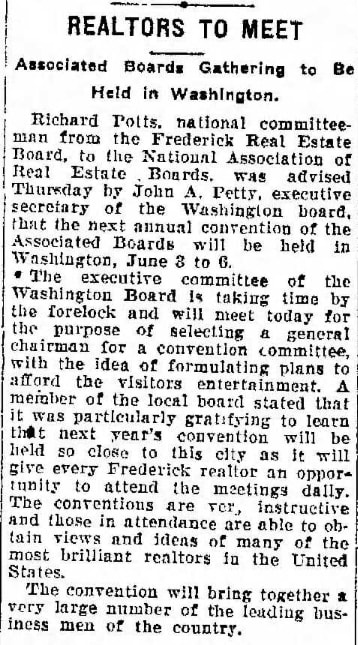












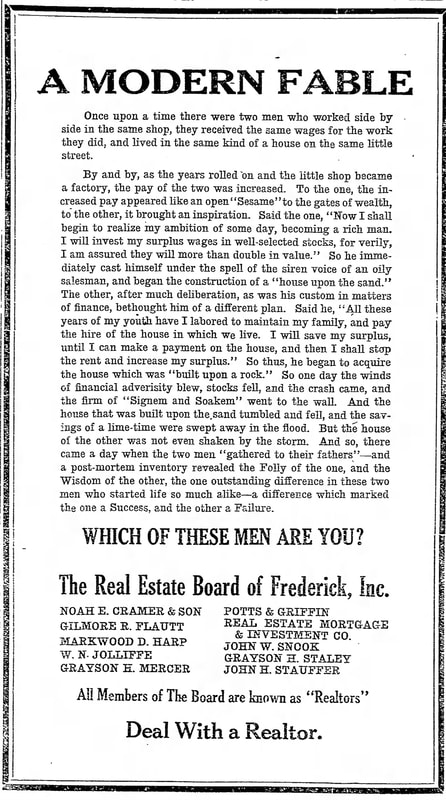




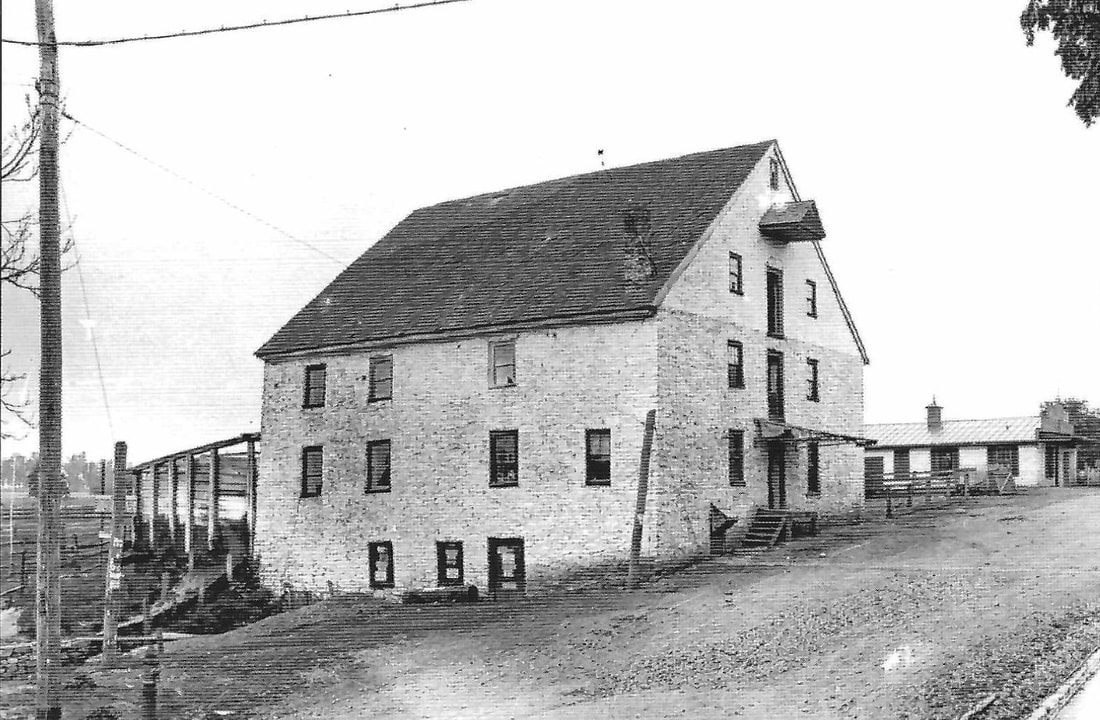



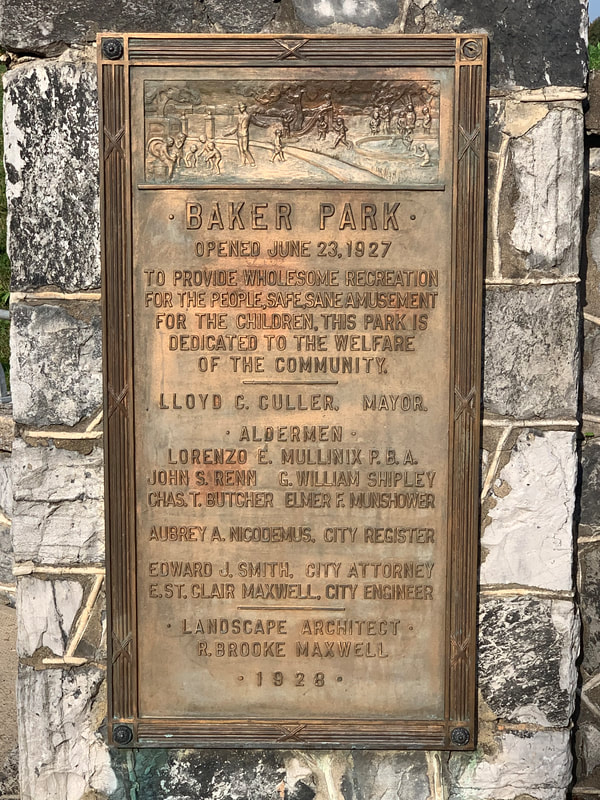

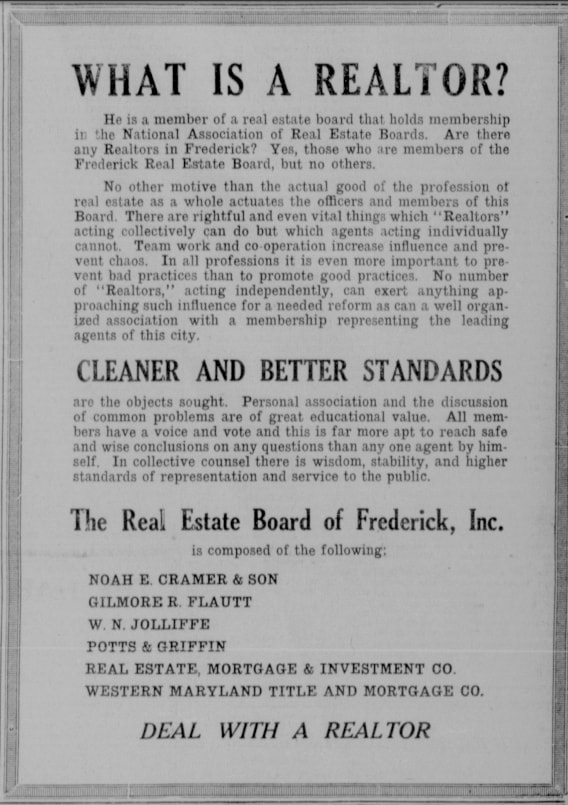

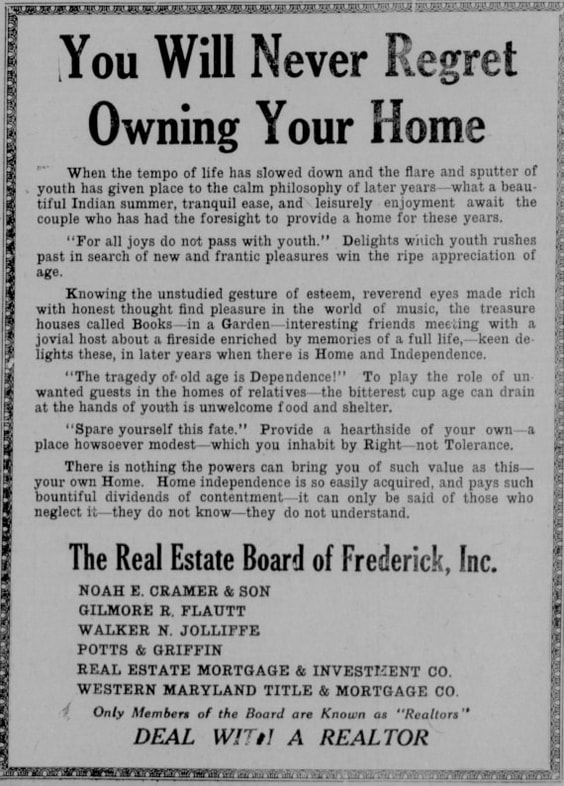








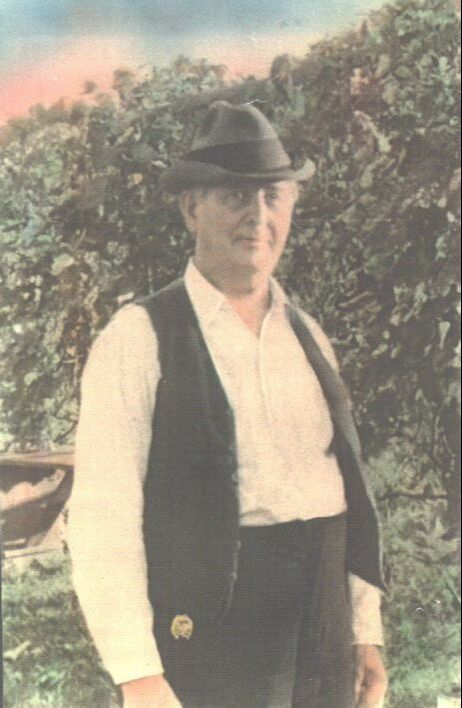

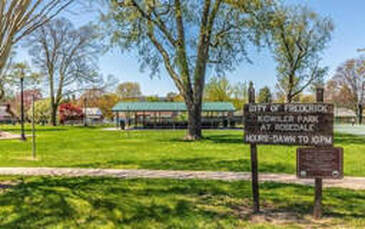




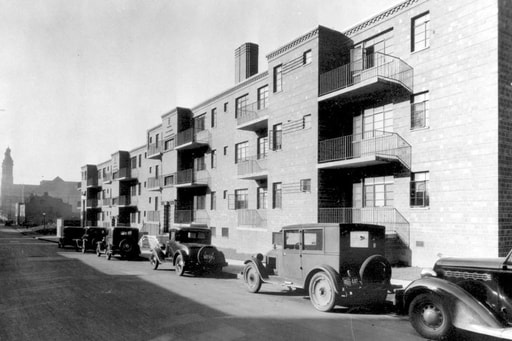



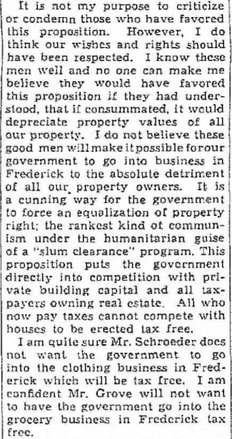
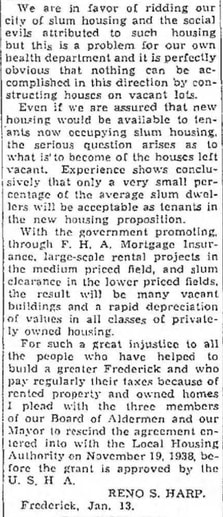


















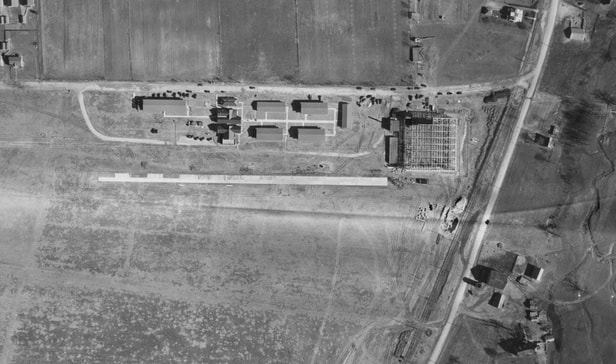





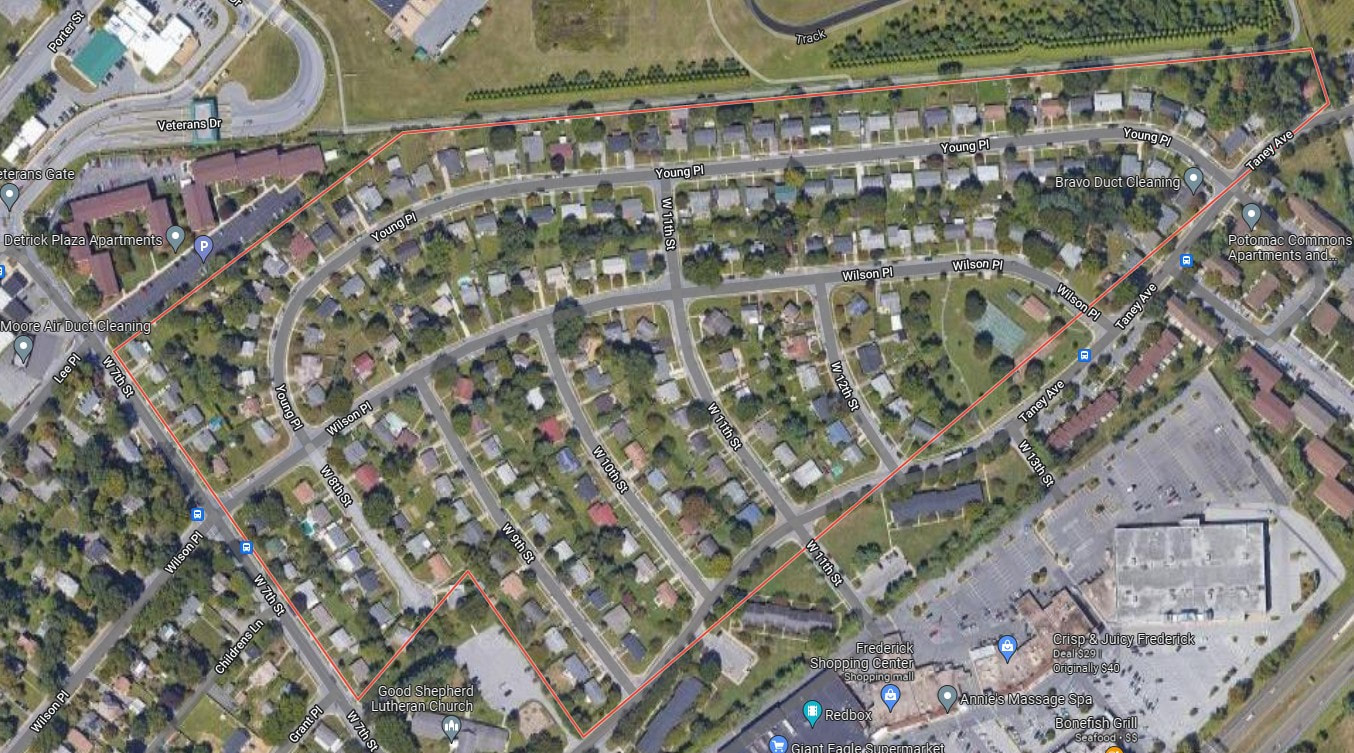
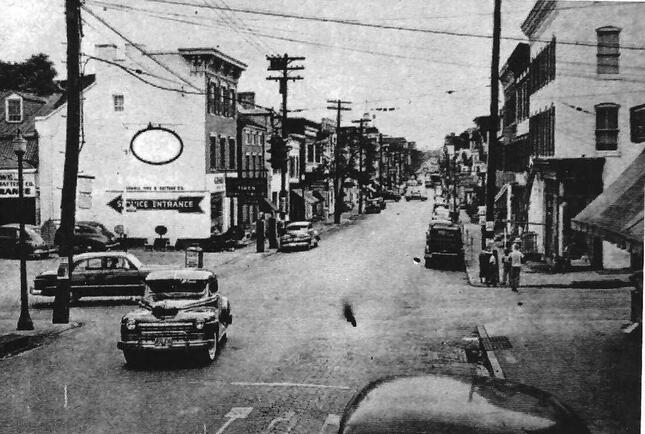









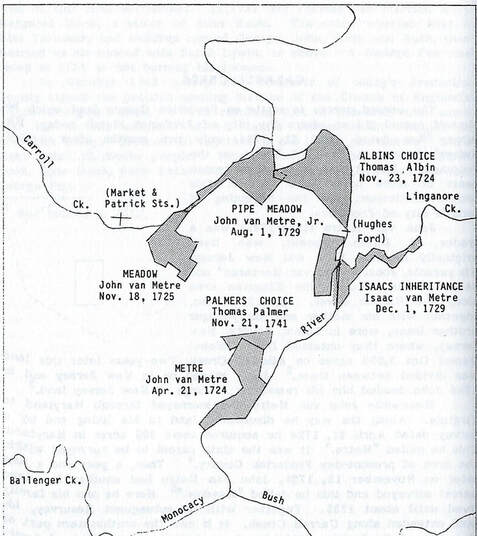










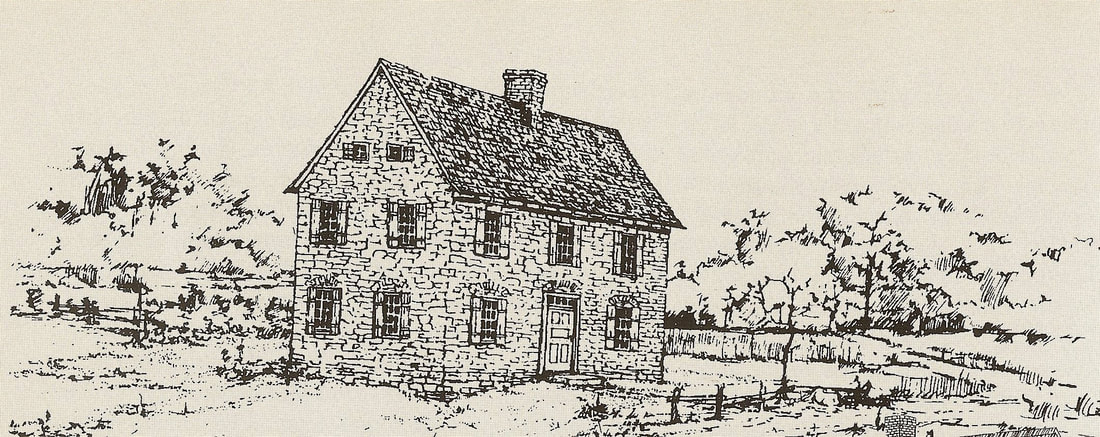






















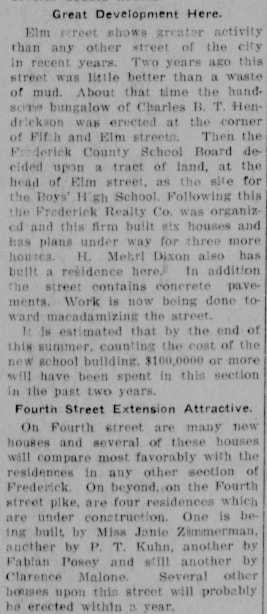
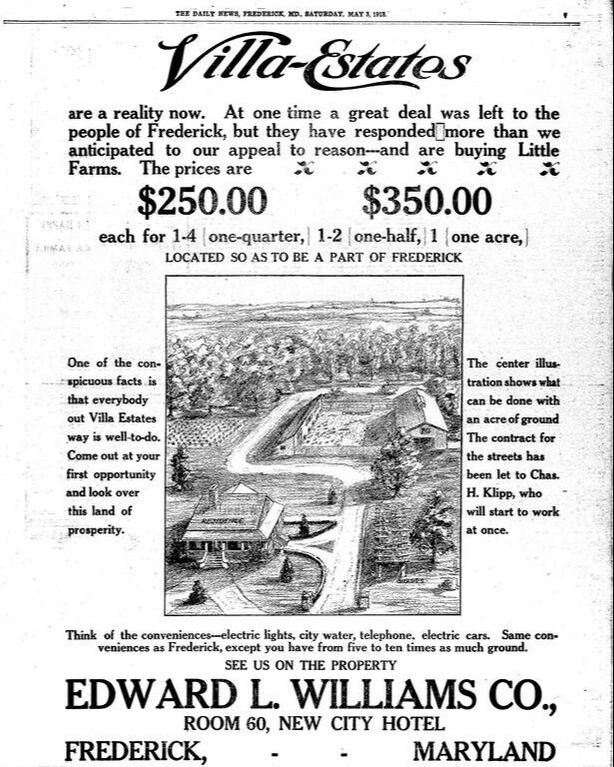









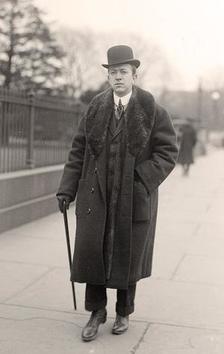

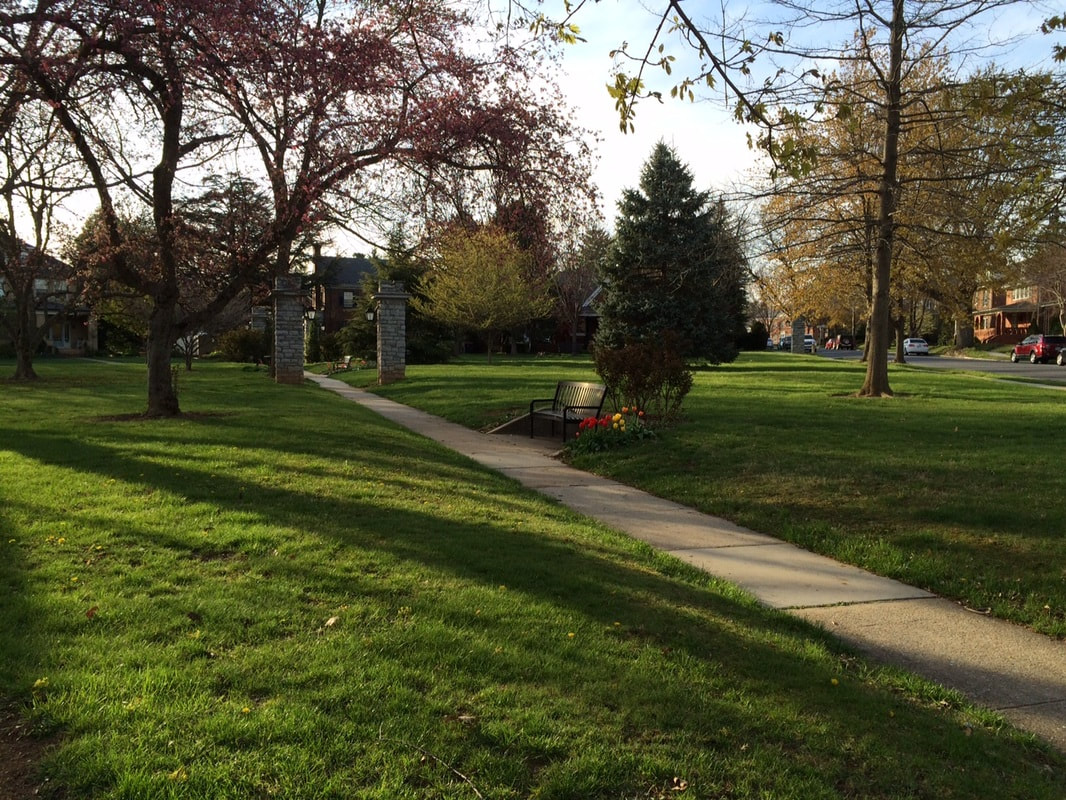
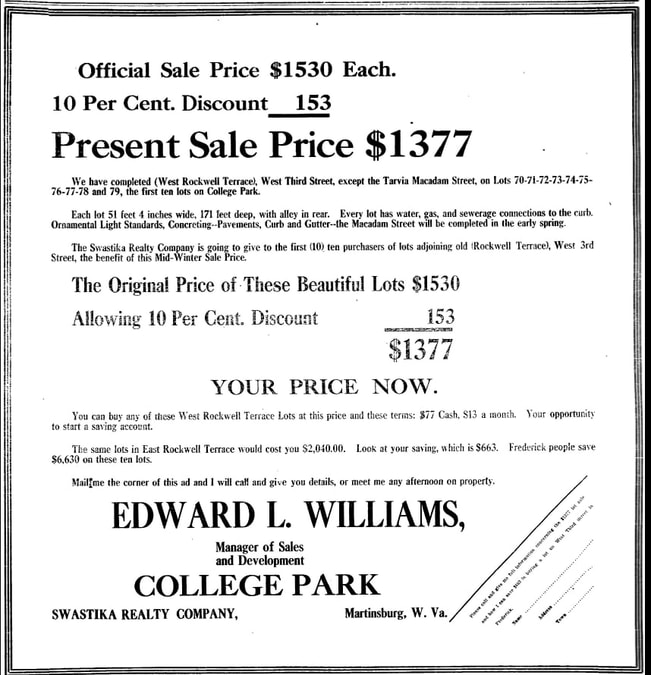




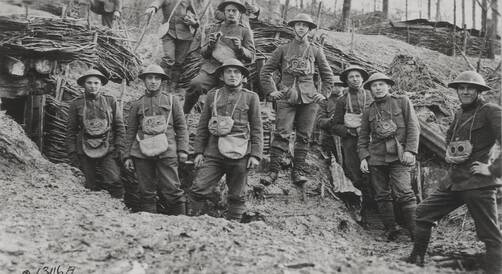




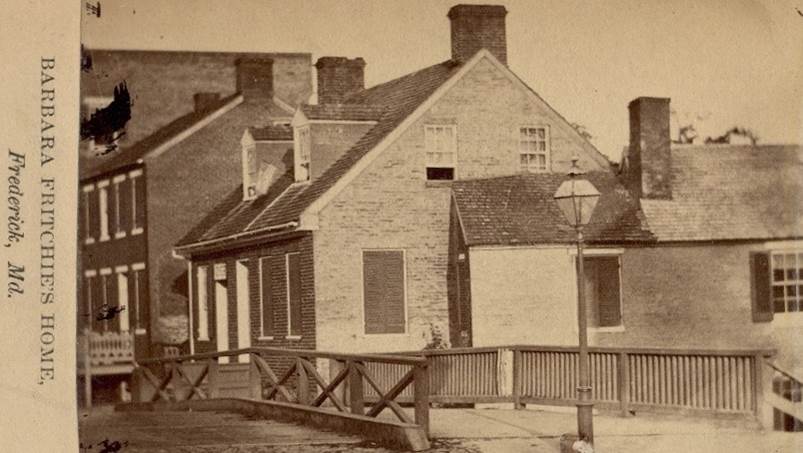















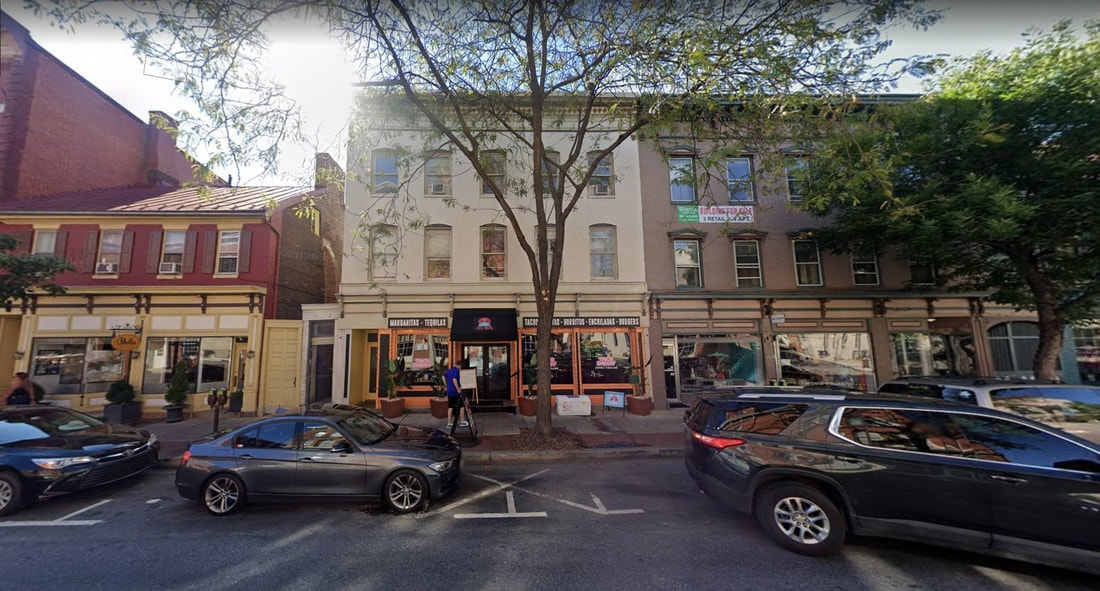



















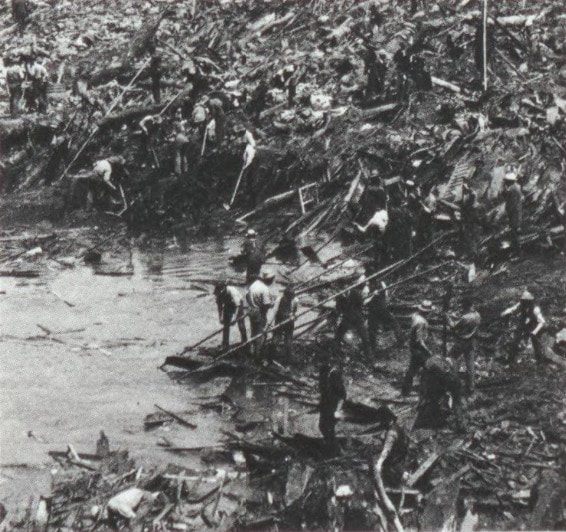












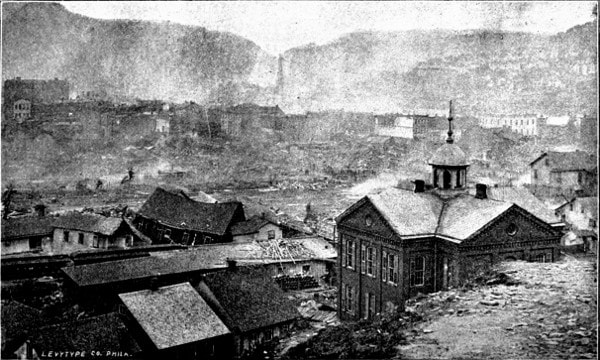


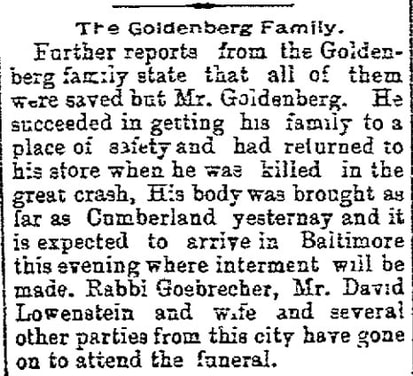






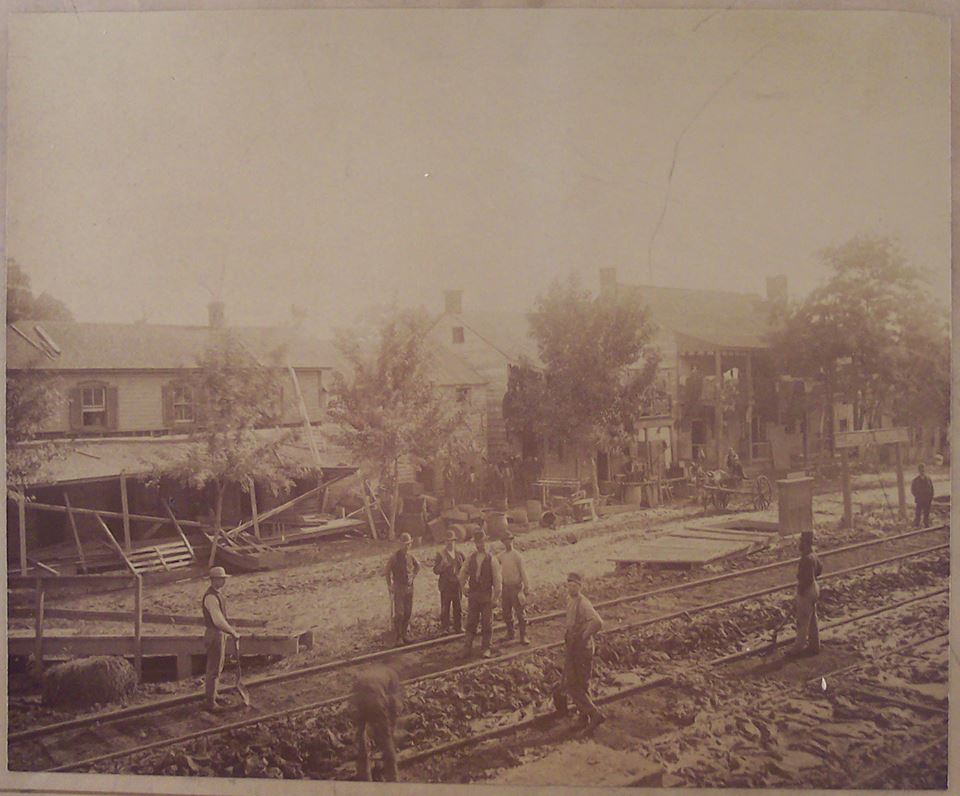























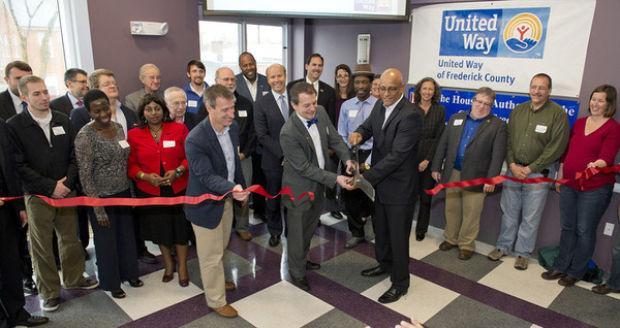
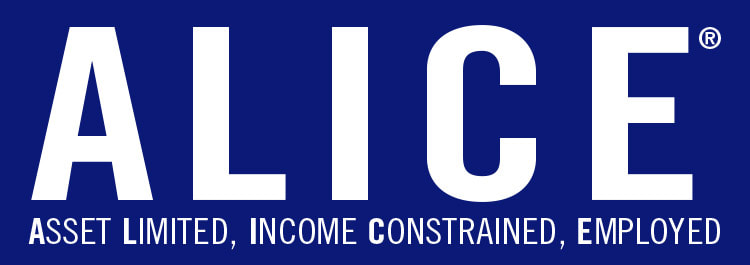


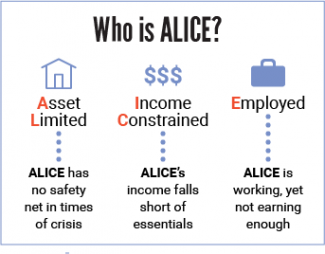

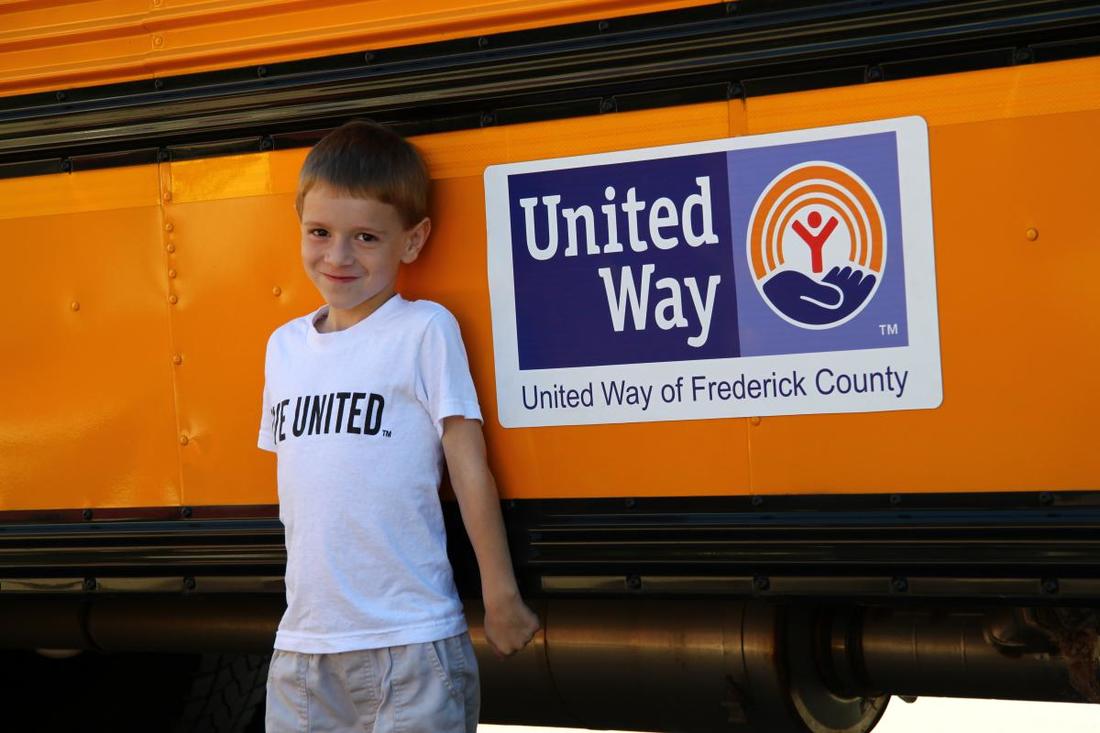





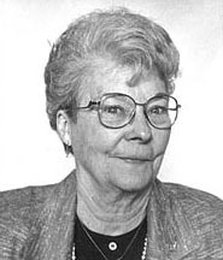












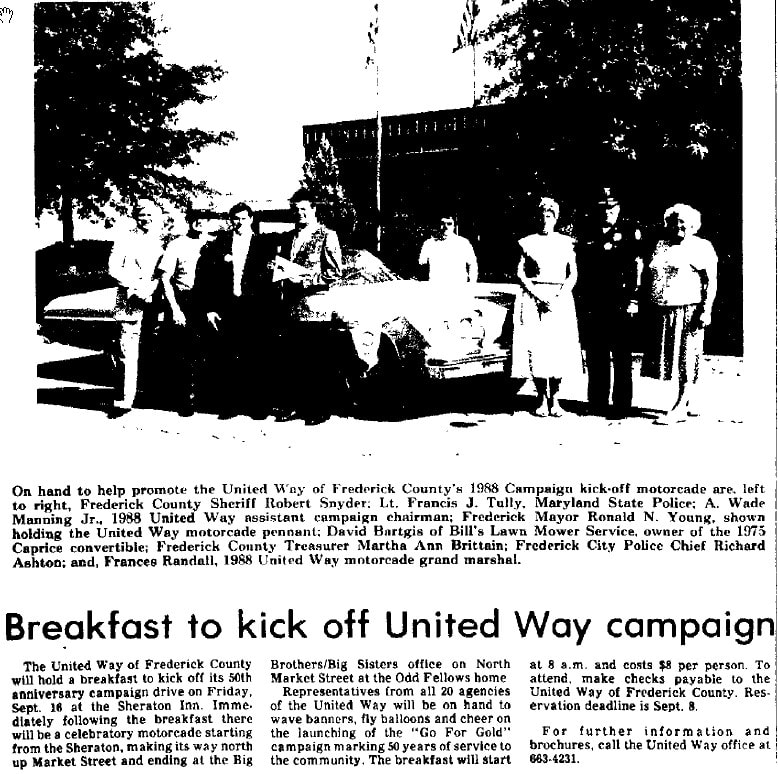

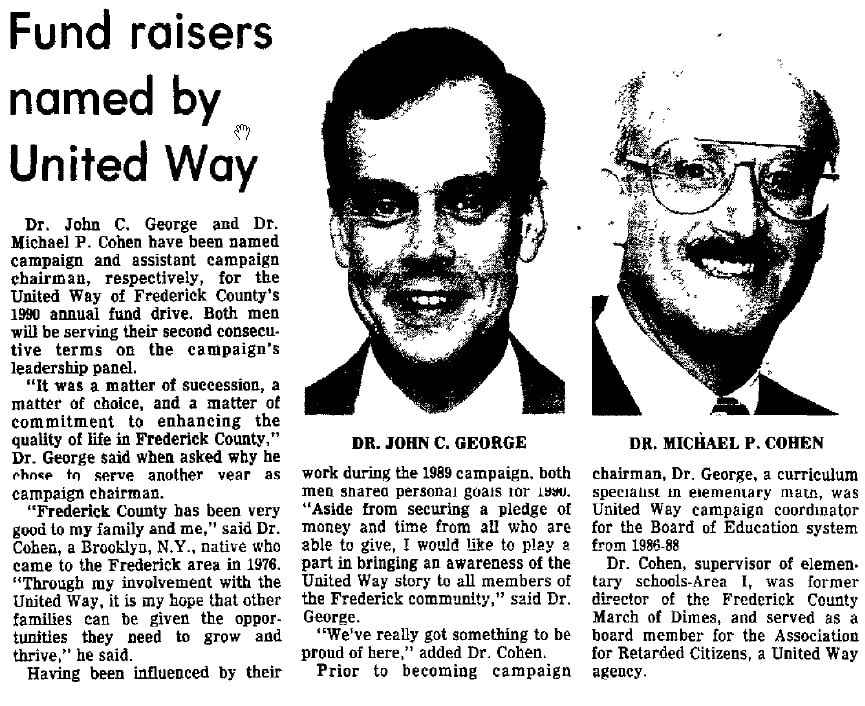





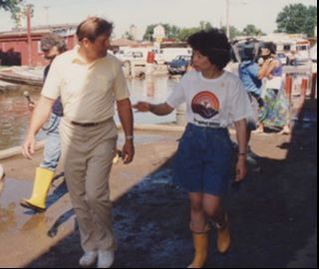












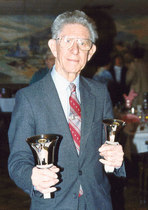


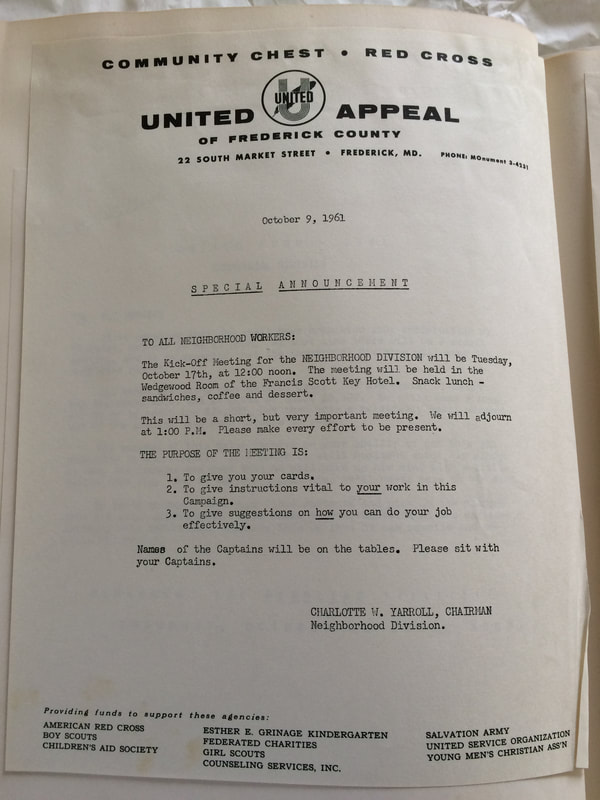















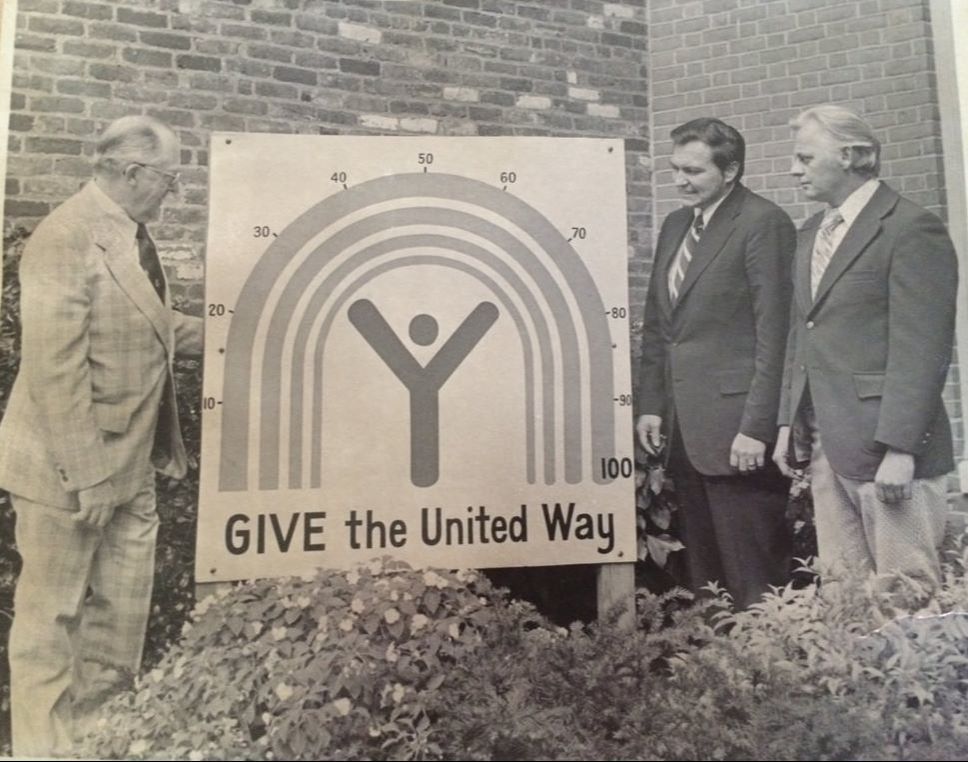














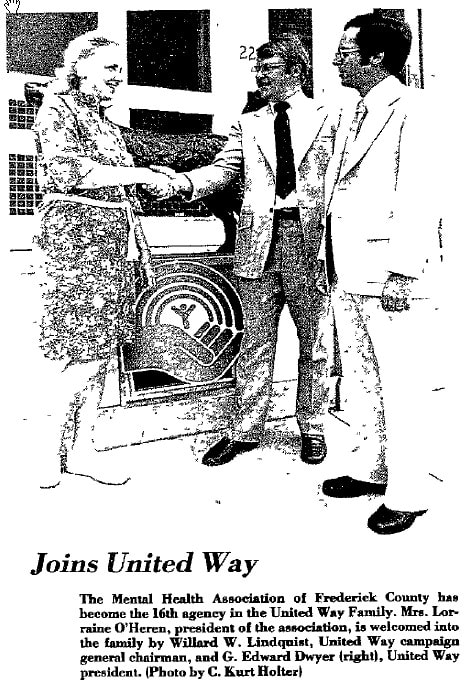



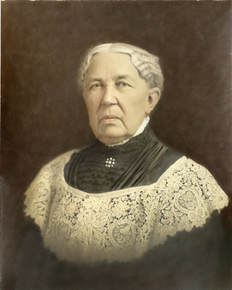





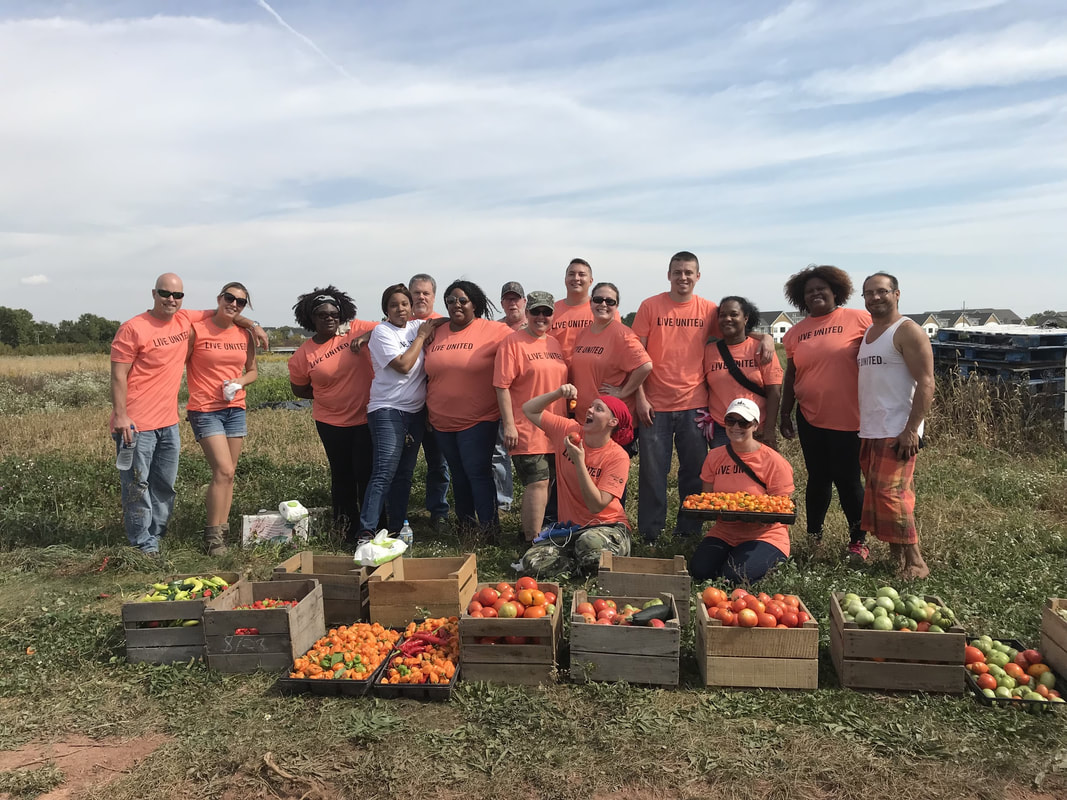




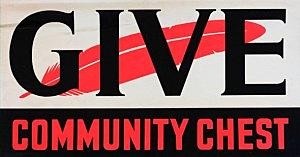








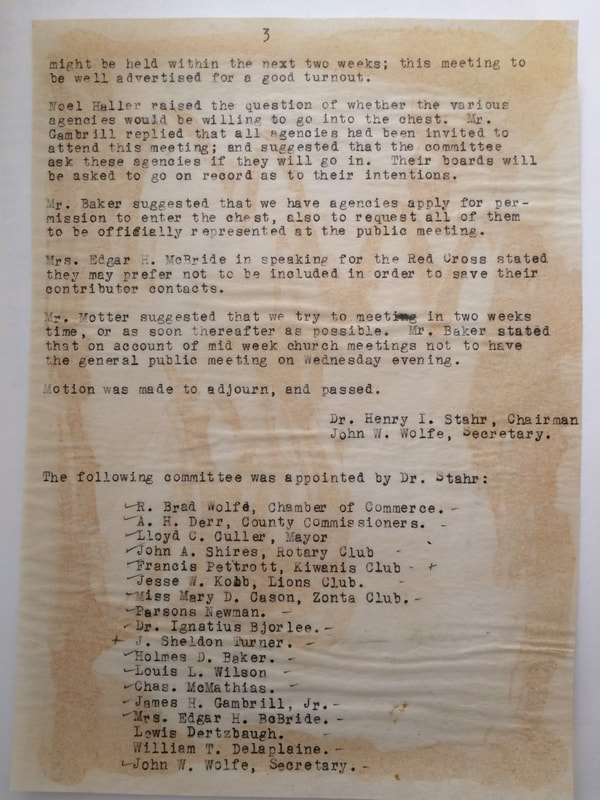
















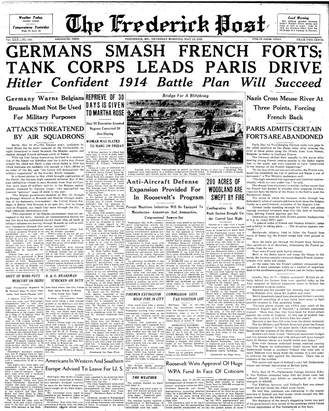





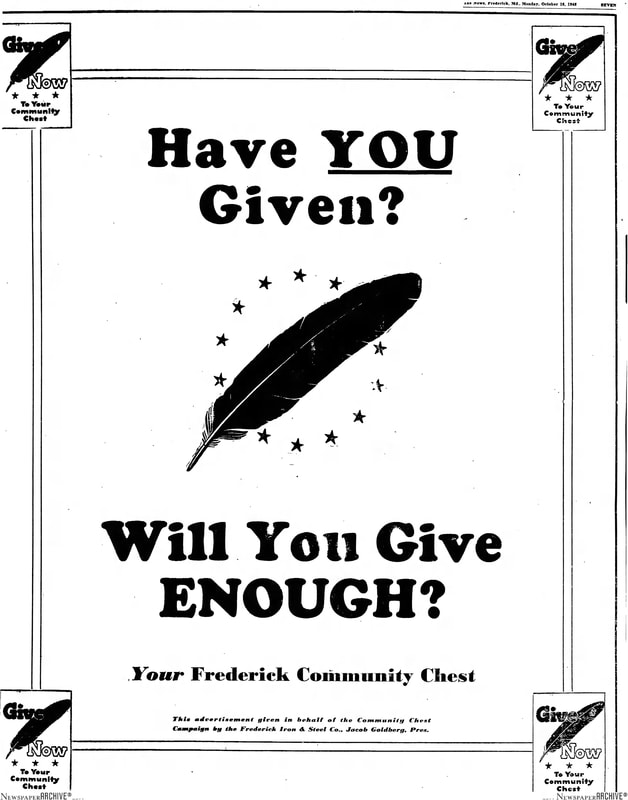
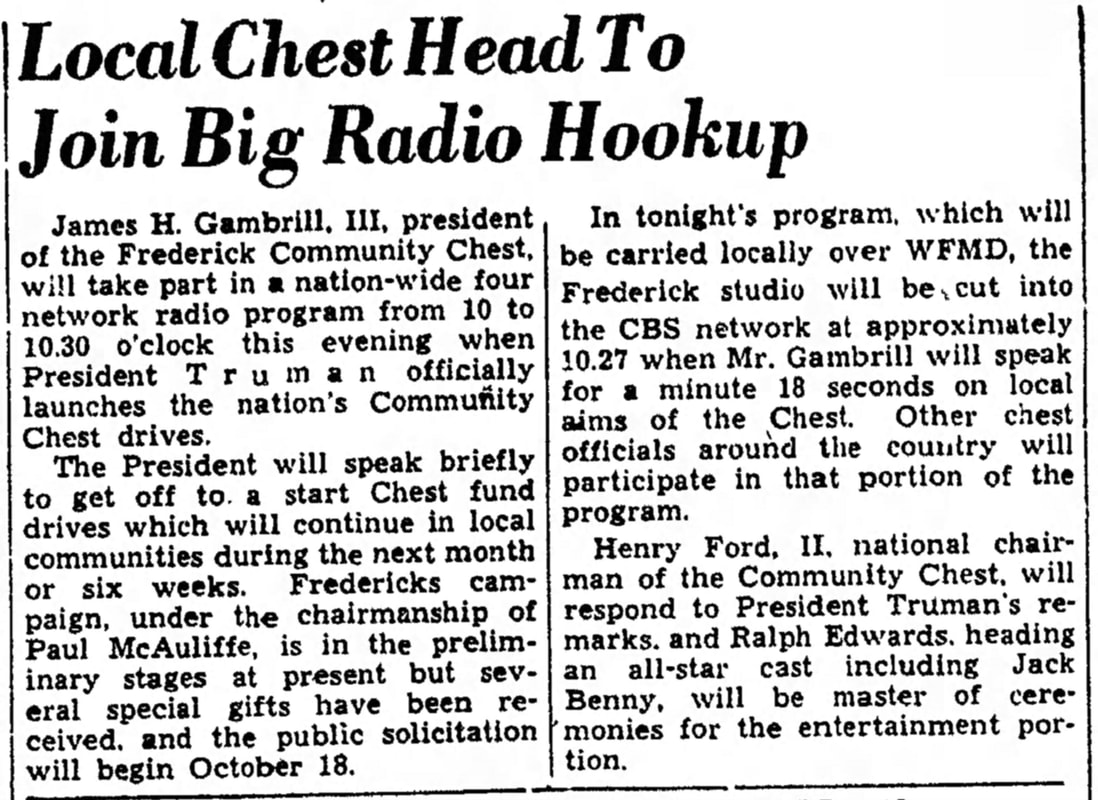
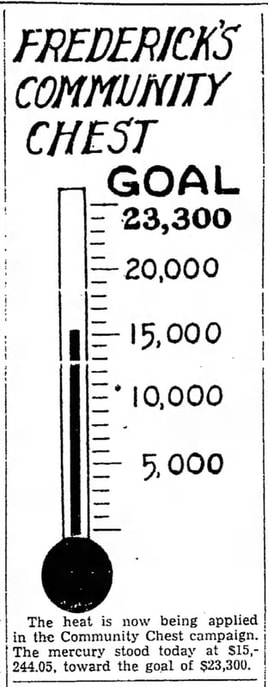










 RSS Feed
RSS Feed